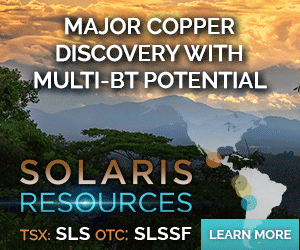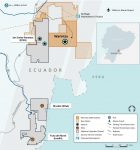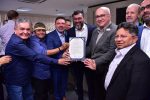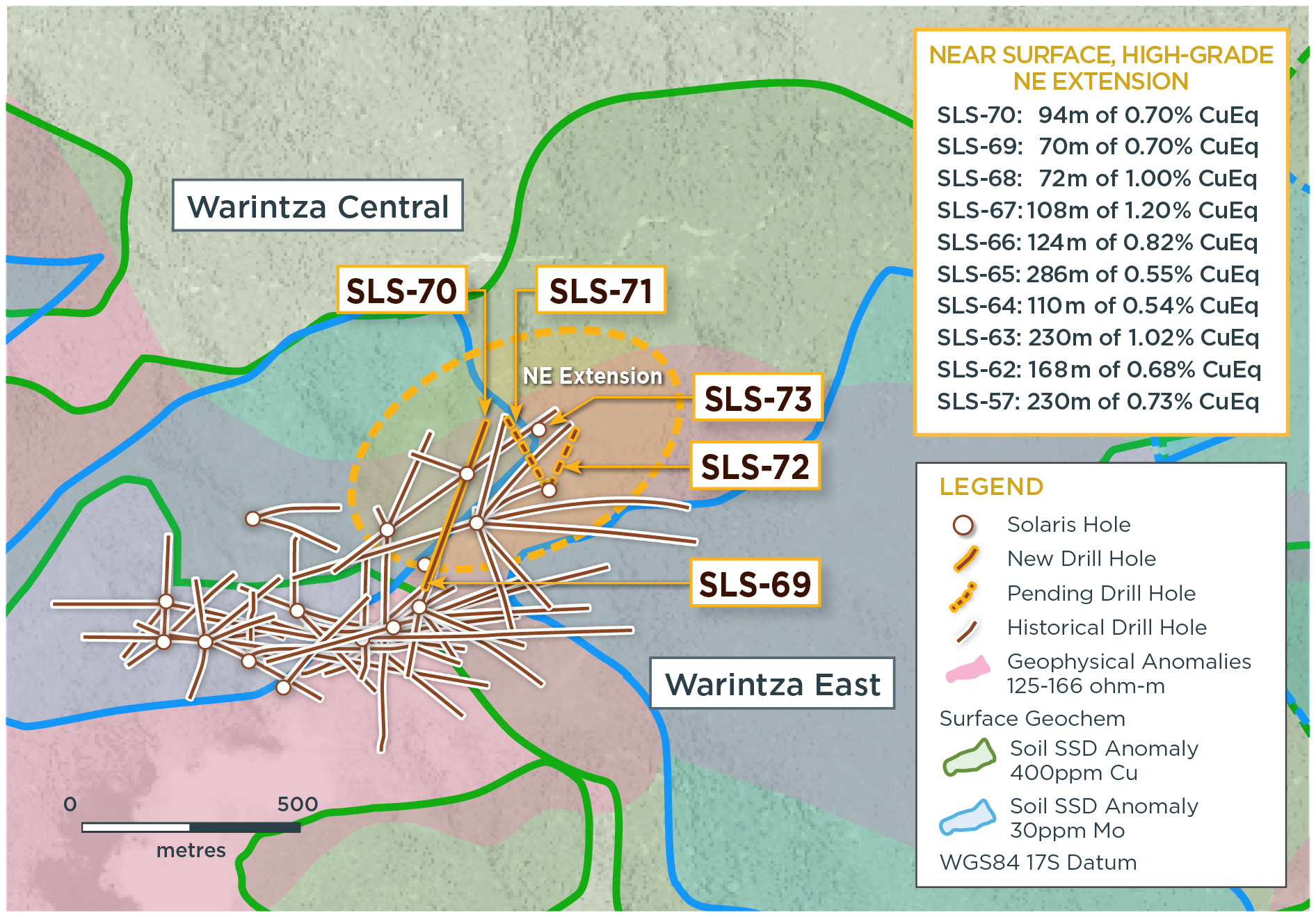
Solaris Resources (TSX:SLS) (OTCQB:SLSSF) has reported new assay results from a series of holes aimed at growing the Northeast Extension of the “Indicative Starter Pit” at the Warintza Project, with further resource expansion growing the area of near-surface, high-grade mineralization estimated at estimated at 180 Mt at 0.82% CuEq¹ (Indicated) and 107 Mt at 0.73% CuEq¹ (Inferred) within the Warintza Mineral Resource Estimate. The company is currently waiting on assays from follow-up step-out drilling, and has additional platforms planned for construction at the project.
Mr. Jorge Fierro, Vice President, Exploration, commented in a press release: “The Northeast Extension represents a significant area of focus for growing the ‘Indicative Starter Pit’, one of the two key goals for the follow-on drilling program from the 2022 MRE, with the other being major resource growth at Warintza East, where extensional and step-out holes are due shortly. In addition, a major program of reconnaissance sampling that commenced last summer has identified new areas of well mineralized outcrop in previously inaccessible terrain adjacent to the Warintza Central and Warintza East deposits that present opportunities for additional discoveries, with further details to be released shortly.”
Highlights from the results are as follows:
- SLS-70 was collared at the northeastern limit of Warintza Central and drilled northeast into an open volume, returning 186m of 0.64% CuEq¹ from near surface within a broader interval of 264m of 0.55% CuEq¹, expanding the zone to the north where it remains open
- This hole follows from SLS-65, drilled approximately 90 degrees to the northwest from the same platform, which returned 286m of 0.55% CuEq¹ from near surface (refer to press release dated December 5, 2022)
- SLS-69, collared from the same platform and drilled the opposite direction to the southwest, returned 156m of 0.60% CuEq¹ from 52m depth within a broader interval of 846m of 0.30% CuEq¹, connecting the Northeast Extension to Warintza Central
- Prior hole SLS-66, drilled west-southwest, returned 124m of 0.82% CuEq¹ from near surface within a broader interval of 622m of 0.42% CuEq¹ (refer to press release dated September 7, 2022) from a platform to the south where a follow-up southwest-oriented hole is planned to better connect the Northeast Extension to Warintza Central
- Assays are pending from two newly constructed 250m step-out platforms testing the zone further to the northeast, with additional platforms planned for construction as the weather improves
Table 1 – Assay Results
| Hole ID | Date Reported | From (m) | To (m) | Interval (m) | Cu (%) | Mo (%) | Au (g/t) | CuEq¹ (%) |
| SLS-70 | Mar 13, 2023 | 26 | 290 | 264 | 0.38 | 0.03 | 0.11 | 0.55 |
| Including | 104 | 290 | 186 | 0.48 | 0.03 | 0.11 | 0.64 | |
| Including | 104 | 198 | 94 | 0.53 | 0.03 | 0.11 | 0.70 | |
| SLS-69 | 52 | 898 | 846 | 0.20 | 0.02 | 0.03 | 0.30 | |
| Including | 52 | 208 | 156 | 0.48 | 0.02 | 0.08 | 0.60 | |
| Including | 52 | 122 | 70 | 0.56 | 0.03 | 0.06 | 0.70 | |
| Notes to table: True widths of the mineralized zone are not known at this time. | ||||||||
Table 2 – Collar Location
| Hole ID | Easting | Northing | Elevation (m) | Depth (m) | Azimuth (degrees) | Dip (degrees) |
| SLS-70 | 800350 | 9648417 | 1356 | 291 | 20 | -65 |
| SLS-69 | 800350 | 9648417 | 1356 | 944 | 200 | -70 |
| Notes to table: The coordinates are in WGS84 17S Datum. | ||||||
Endnotes
- Copper-equivalence calculated as: CuEq (%) = Cu (%) + 4.0476 × Mo (%) + 0.487 × Au (g/t), utilizing metal prices of US$3.50/lb Cu, US$15.00/lb Mo, and US$1,500/oz Au, and assumes recoveries of 90% Cu, 85% Mo, and 70% Au based on preliminary metallurgical test work. The ‘Indicative Starter Pit’ is based on the same assumptions as the MRE except utilized metal prices of US$1.00/lb Cu, US$7.50/lb Mo, and US$750/oz Au. The ‘Indicative Starter Pit’ is comprised of Indicated mineral resources of 180 Mt at 0.82% CuEq (0.67% Cu, 0.03% Mo, 0.07 g/t Au) and Inferred mineral resources of 107 Mt at 0.73% CuEq (0.64% Cu, 0.02% Mo, 0.05 g/t Au) above a 0.6% CuEq cut-off grade. No economic analysis has been completed by the Company and there is no guarantee an ‘Indicative Starter Pit’ will be realized or prove to be economic.
- Refer to Solaris’ technical report titled, “NI 43-101 Technical Report for the Warintza Project, Ecuador” with an effective date of April 1, 2022, prepared by Mario E. Rossi and filed on the Company’s SEDAR profile at www.sedar.com.
- For additional details on “Near Surface, High-Grade, NE Extension” intervals, refer to press release dated May 26, 2022 for SLS-57: 230m of 0.73% CuEq (0.59% Cu, 0.03% Mo, 0.08 g/t Au), refer to press release dated July 20, 2022 for SLS-62: 168m of 0.68% CuEq (0.51% Cu, 0.03% Mo, 0.07 g/t Au) and SLS-63: 230m of 1.02% CuEq (0.87% Cu, 0.02% Mo, 0.12 g/t Au), refer to press release dated September 7, 2022 for SLS-64: 110m of 0.54% CuEq (0.38% Cu, 0.04% Mo, 0.03 g/t Au) and SLS-66: 124m of 0.82% CuEq (0.71% Cu, 0.02% Mo, 0.09 g/t Au), refer to press release dated December 5, 2022 for SLS-65: 286m of 0.55% CuEq (0.38% Cu, 0.04% Mo, 0.06 g/t Au) and SLS-68: 72m of 1.00% CuEq (0.88% Cu, 0.02% Mo, 0.06 g/t Au).
The above references an opinion and is for information purposes only. It is not intended to be investment advice. Seek a licensed professional for investment advice. The author is not an insider or shareholder of any of the companies mentioned above.
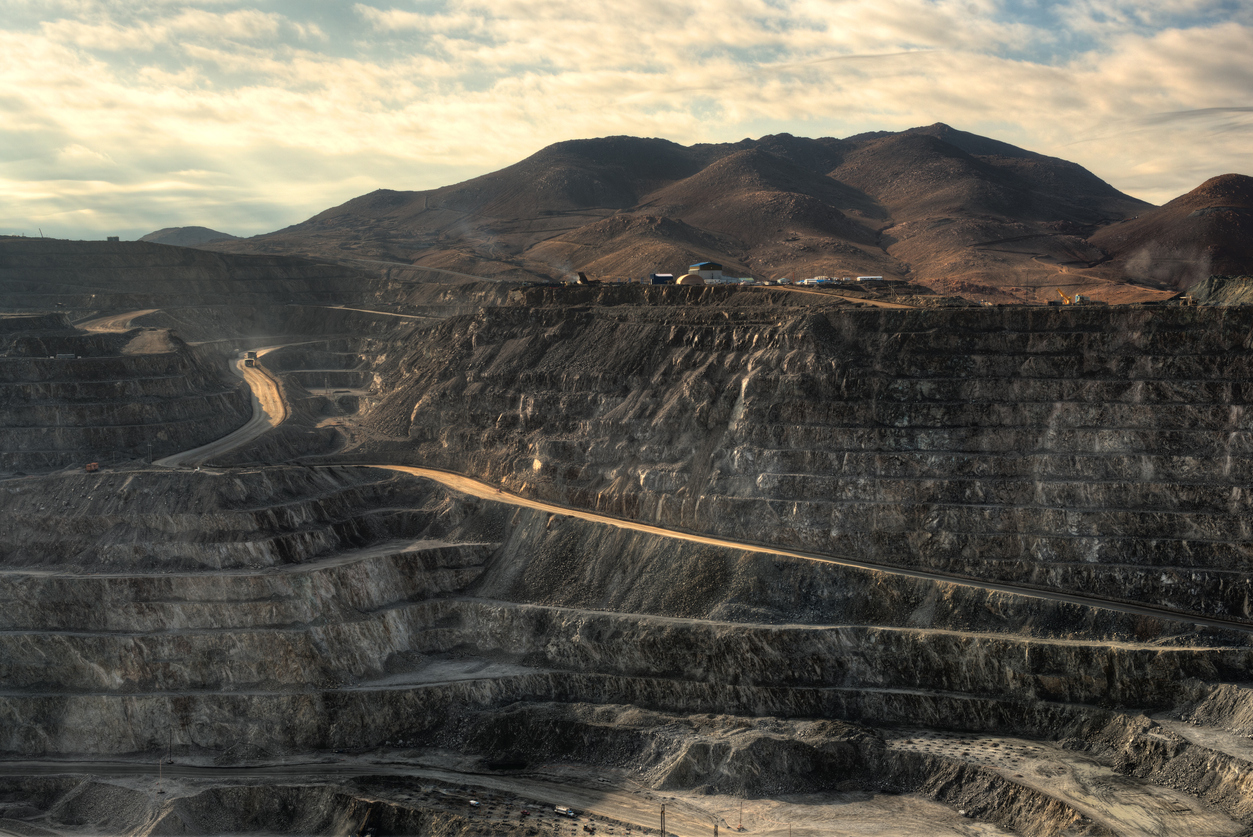
South America is home to some of the largest copper deposits in the world, and several exploration companies are working hard to discover new resources and expand existing ones. Here are the top three copper exploration companies in South America, along with some of their most notable intercepts.
Solaris Resources (TSX:SLS) (OTCQB:SLSSF)
Solaris Resources (TSX:SLS) (OTCQB:SLSSF) is a Canadian copper exploration company focused on the discovery and development of copper and gold deposits in the Americas. The company has a strong presence in South America, where it is actively exploring for copper and gold deposits in Ecuador and Peru.
The company continues to report regular exploration results expanding on its discoveries at what has been called a potential “superpit”.
Warintza is considered a take-out target as the Company has defined a large 1.5Bt copper inventory, featuring a high-grade starter pit and low strip ratio, within a mining district offering major structural advantages from highway access, abundant and low-cost hydroelectric power, fresh water, labour and low elevation. The Company has de-risked the project by locking in a social license through an IBA signed with the communities, and freezing in place the regulatory and fiscal framework by signing an Investment Contract with the Government in December. The final de-risking item is completing project permitting, which is ongoing and expected in 2024 with the project being designated a “strategic priority project” by the Government.
First Quantum Minerals (TSX:FM)
First Quantum Minerals (TSX:FM) is a Vancouver-based mining company with operations in Africa, Australia, and South America. Its flagship copper mine is the Cobre Panama project, located in Panama. The company has been exploring the region for years and has made several significant copper discoveries.
First Quantum has reported several impressive drill intercepts at Cobre Panama. One of the most notable was a 136-meter intersection of copper and gold mineralization, grading 0.63% copper and 0.35 grams per tonne of gold. This intercept was found in the southeast extension of the Cobre Panama deposit, and the company believes it has the potential to significantly increase the mine’s resources.
Anglo American (LSE:AAL)
Anglo American (LSE:AAL) is a multinational mining company with operations in Africa, Europe, and the Americas. Its copper operations are located in Chile, where it owns a 50% stake in the Los Bronces mine and a 100% stake in the Mantoverde mine.
Anglo American has reported several impressive drill intercepts at Los Bronces. One of the most significant was a 95-meter intersection of copper and molybdenum mineralization, grading 0.67% copper and 0.022% molybdenum. This intercept was found in the north zone of the mine, and the company believes it has the potential to increase the mine’s resources.
Teck Resources (NYSE:TECK)
Teck Resources (NYSE:TECK) is a Canadian mining company with operations in Canada, the United States, and Chile. Its copper operations are located in Chile, where it owns a 90% stake in the Quebrada Blanca mine.
Teck reported several intercepts at Quebrada Blanca since exploration began. One of the most biggest was in 2021; a 129-meter intersection of copper mineralization, grading 0.39% copper. This intercept was found in the QB2 deposit, which is currently under construction and expected to begin production in 2022. The company believes that QB2 has the potential to become a significant copper producer, with a projected mine life of over 25 years.
The above references an opinion and is for information purposes only. It is not intended to be investment advice. Seek a licensed professional for investment advice. The author is not an insider or shareholder of any of the companies mentioned above.

The above references an opinion and is for information purposes only. It is not intended to be investment advice. Seek a licensed professional for investment advice. The author is not an insider or shareholder of any of the companies mentioned above.
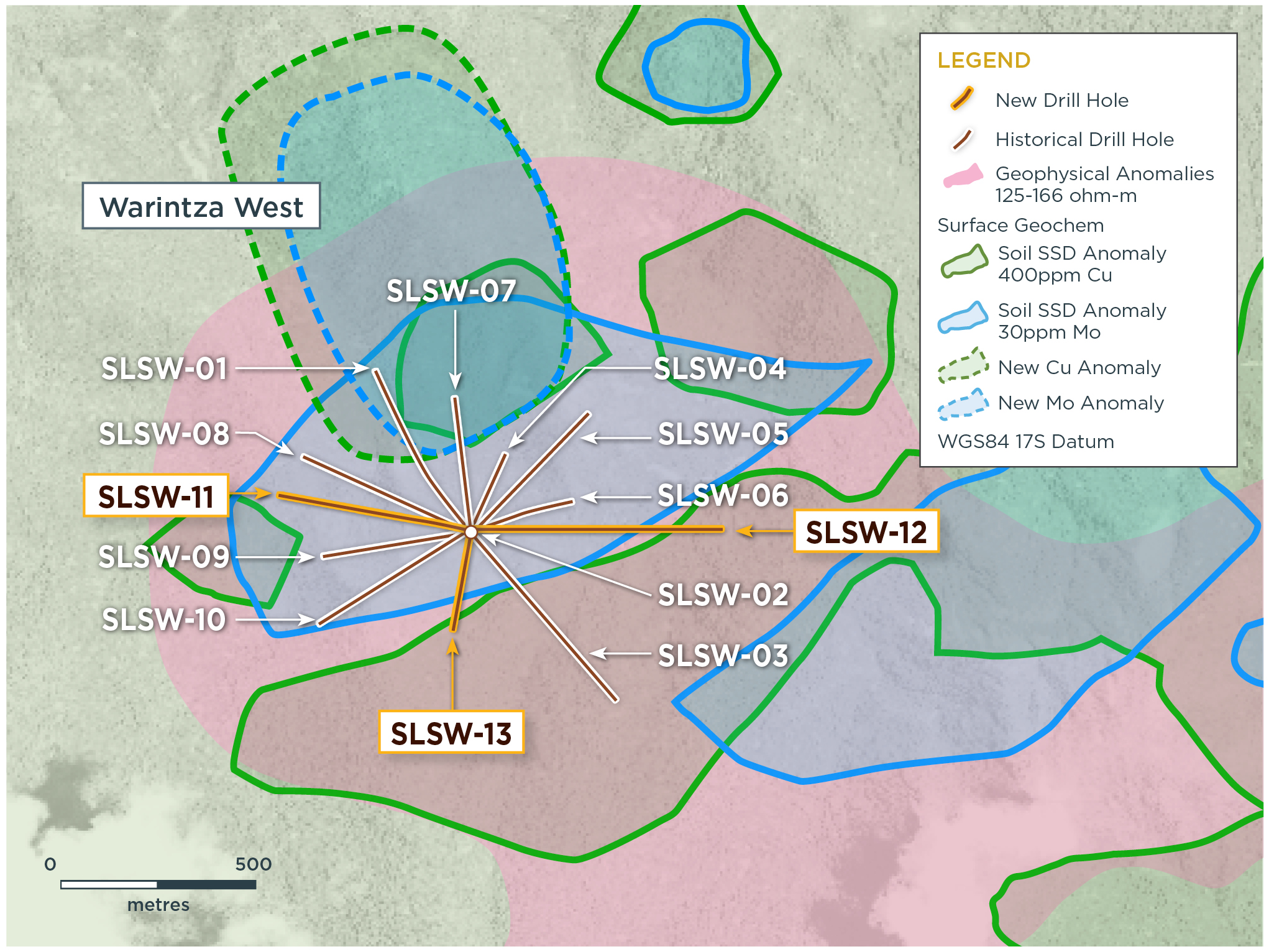
Solaris Resources (TSX:SLS) has reported new updated geochemical sampling and assay results from follow-up holes at Warintza West within the Warintza Project in Ecuador. The company has identified new potential at the zone, which was one of four discoveries made to-date in the Warintza porphyry cluster located 1km west of and outside the Warintza Mineral Resources (MRE).
The company has performed reconnaissance drilling with the initial holes from the centralized platform outlining a broad zone of porphyry mineralization measuring 1200m z 700m, and remains open. Geochemical sampling provided vectors toward more potential higher-grade mineralization to the north for step-out drilling, expanding on Warintza’s potential for further future discoveries.
Mr. Jorge Fierro, Vice President, Exploration, commented in a press release: “First pass reconnaissance drilling at Warintza West outlined a broad zone of porphyry mineralization, with subsequent sampling identifying new potential for higher-grade mineralization to the north for future step-out drilling. The ongoing drill program is targeting MRE growth within the high-grade starter pit at Warintza Central, where results are expected shortly, and expanding the Warintza East discovery which adjoins Warintza Central.”
Highlights from the results are as follows:
- Recent geochemical sampling has identified a new area of strong overlapping copper and molybdenum anomalies to the north measuring approximately 1000m x 500m with soil samples averaging 600 ppm Cu and 80 ppm Mo – this contrasts with the anomaly surrounding the original platform that is defined by strong Mo values at 65 ppm but weaker Cu below 400 ppm
- This new area of strong soil anomalism represents a potential target for higher-grade mineralization beyond the northern margin of prior exploration drilling (refer to press releases dated Oct 13, 2022 and Feb 16, 2021), including:
- SLSW-07 (drilled north) returned 686m of 0.46% CuEq²
- SLSW-04 (drilled northeast) returned 264m of 0.44% CuEq²
- SLSW-01 (drilled northwest) returned 260m of 0.42% CuEq³
- New drill results returned to the south, include SLSW-13, which was drilled southwest and returned 320m of 0.50% CuEq² from near surface within a broader interval of 496m of 0.40% CuEq², extending mineralization to the south where it remains open, and requires step-out drilling
- This hole expands on previously reported SLSE-10, which was drilled from the same platform to the southwest and returned 220m of 0.41% CuEq² from near surface (refer to press release dated Oct 13, 2022)
Table 1 – Assay Results
| Hole ID | Date Reported | From (m) | To (m) | Interval (m) | Cu (%) | Mo (%) | Au (g/t) | CuEq² (%) |
| SLSW-13 | Feb 13, 2023 | 24 | 520 | 496 | 0.32 | 0.02 | 0.03 | 0.40 |
| Including | 24 | 344 | 320 | 0.40 | 0.02 | 0.03 | 0.50 | |
| SLSW-12 | 58 | 592 | 534 | 0.15 | 0.01 | 0.01 | 0.20 | |
| Including | 58 | 246 | 188 | 0.24 | 0.01 | 0.02 | 0.30 | |
| SLSW-11 | 20 | 648 | 628 | 0.17 | 0.005 | 0.02 | 0.20 | |
| Including | 30 | 288 | 258 | 0.22 | 0.005 | 0.03 | 0.26 |
Notes to table: True widths of the mineralized zone are not known at this time.
Table 2 – Collar Location
| Hole ID | Easting | Northing | Elevation (m) | Depth (m) | Azimuth (degrees) | Dip (degrees) |
| SLSW-13 | 798507 | 9648465 | 1519 | 530 | 190 | -60 |
| SLSW-12 | 798507 | 9648465 | 1519 | 1005 | 90 | -50 |
| SLSW-11 | 798507 | 9648465 | 1519 | 708 | 280 | -46 |
| Notes to table: The coordinates are in WGS84 17S Datum. | ||||||
Endnotes
- Refer to technical report titled, “NI 43-101 Technical Report for the Warintza Project, Ecuador” with an effective date of April 1, 2022, prepared by Mario E. Rossi and filed on the Company’s SEDAR profile at www.sedar.com.
- Copper-equivalence for the MRE and drill holes SLSW 2-13 calculated as: CuEq (%) = Cu (%) + 4.0476 × Mo (%) + 0.487 × Au (g/t), utilizing metal prices of US$3.50/lb Cu, US$15.00/lb Mo, and US$1,500/oz Au, and assumes recoveries of 90% Cu, 85% Mo, and 70% Au based on preliminary metallurgical test work.
- Copper-equivalence calculated as: CuEq (%) = Cu (%) + 3.33 × Mo (%) + 0.73 × Au (g/t), utilizing metal prices of US$3.00/lb Cu, US$10.00/lb Mo, and US$1,500/oz Au. No adjustments were made for recovery prior to the updated MRE, as the metallurgical data to allow for estimation of recoveries was not yet available. Solaris defined CuEq for reporting purposes only.
The above references an opinion and is for information purposes only. It is not intended to be investment advice. Seek a licensed professional for investment advice. The author is not an insider or shareholder of any of the companies mentioned above.
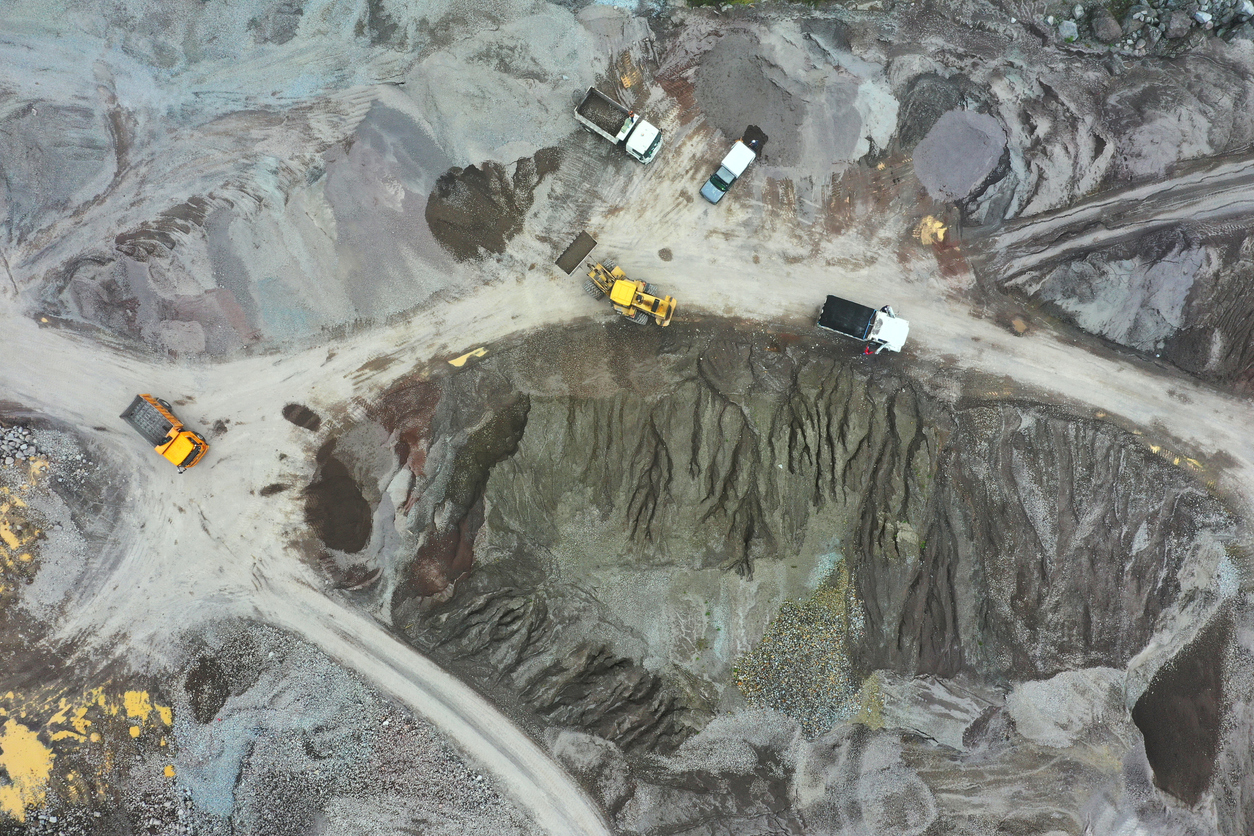
Ecuador has become one of the most attractive countries for mining investments in Latin America, with a favourable investment climate, attractive legal and tax frameworks, and a wide variety of mineral deposits. With this in mind, here are some of the mining companies in Ecuador to watch in 2023.
Solaris Resources (TSX:SLS) (OTCQB:SLSSF)
Solaris Resources is a junior mining company based in Canada, with its flagship Warintza Project located in southeastern Ecuador. The company has enjoyed multiple successful discoveries at the Warintza Project while building a positive relationship with the government and signing an important investment contract protecting the project.
On December 22, 2022, Solaris and the government of Ecuador signed an investment contract ratifying the Investment Protection Agreement announced on June 9, 2022. The important contract marked a major milestone for the company and displays how important the project is to the country. Some of the highlights of the agreement surrounding protections and incentives for the duration of the title of the Project which extends with renewal to 2066 are as follows:
- Security of investment
- Stability of mining law
- Stability of taxes at a reduced income tax rate of 20% (25% previously)
- Exemption from capital outflow tax (5% previously)
- Exemption from import duties (up to 5% previously)
- Detailed procedures for dispute resolution and international arbitration protection
Solaris also recently announced results from metallurgical test work at the project conducted by FLSmidth USA with high recoveries of over 90% copper and 80% molybdenum. The test work revealed and confirmed that the project holds further potential for high-grade copper discoveries and more.
Luminex Resources (TSXV:LR)
Luminex Resources recently reported new drill results from its Condor copper-gold project in Ecuador. Drilling confirmed a strike length of 350 metres, and the anomaly has now been mapped at surface for more than 500 metres at the Cuyes West step-out holes.
Highlights from the results are as follows:
- CU22-12 – 2.5 metres grading 18.54 g/t Au Eq
- CU22-13 – 36.0 metres grading 2.29 g/t Au Eq
- CU22-14 – 4.0 metres grading 19.35 g/t Au Eq; including 2.0 metres grading 36.59 g/t Au Eq
- CU22-15 – 17.5 metres grading 3.07 g/t Au Eq
Lundin Gold’s Fruta Del Norte mine in southeast Ecuador has also seen results from ongoing drilling. The company reported results from the 2022 near-mine expiration program identifying new zones of mineralization to the south and at depth of FDN’s currently defined Mineral Resources.
Highlights from the results are as follows:
- Drillhole FDN2022-009 intersected 5.11 g/t Au over 30.3m from a depth of 267.7m, including;
- 9.79 g/t Au over 14.0m from 284.0m
- Drillhole FDN2022-006 intersected 3.99 g/t Au over 4.8m from 181.7m, and 4.40 g/t Au over 8.1m from 213.9m
Highlights from holes drilled under the southern portion of the FDN mineral resource envelope:
- Drillhole UGE-DD-22-008 intersected 4.11 g/t Au over 23.0m from 197.7m, including;
- 6.03 g/t Au over 10.0m from 202.7m
- Drillhole UGE-DD-22-005 intersected 3.53 g/t Au over 44.9m from 134.8m, including;
- 5.25 g/t Au over 12.9m from 134.8m, and;
- 4.32 g/t Au over 15.0m from 164.7m
The above references an opinion and is for information purposes only. It is not intended to be investment advice. Seek a licensed professional for investment advice. The author is not an insider or shareholder of any of the companies mentioned above.
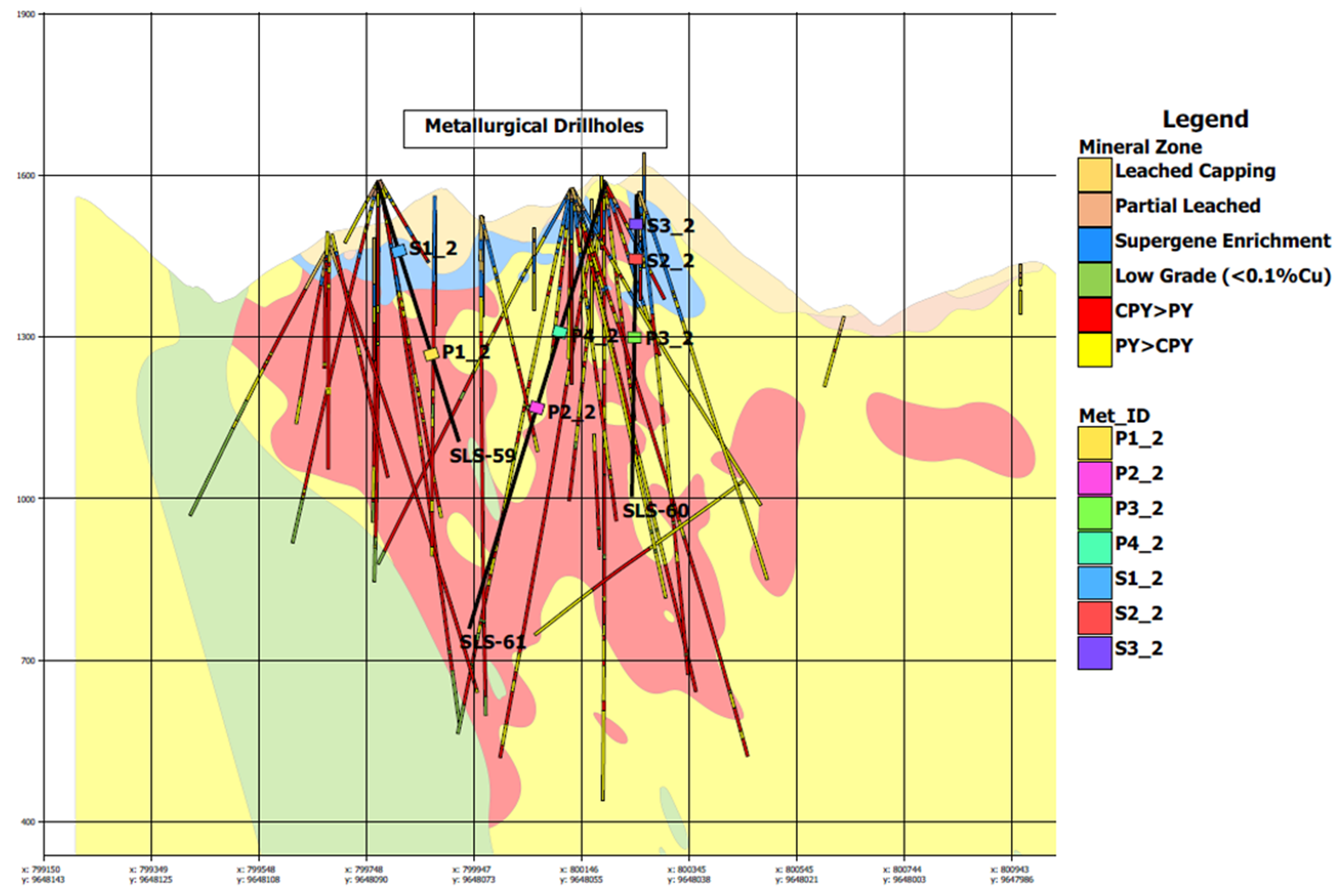
Solaris Resources (TSX:SLS) (OTCQB:SLSSF) has reported new results from metallurgical test work at the Warintza Project in Ecuador, showing high recoveries of copper, molybdenum, and gold in rougher flotation, cleaner flotation, and locked cycle testing. The company commissions FLSmidth USA Inc. to perform all comminution and metallurgical flotation test work programs.
Mr. Daniel Earle, President & CEO, commented in a press release: “Warintza is blessed with simple metallurgy that readily returns high recoveries of critical minerals from standard flotation processes into high-grade concentrates free of deleterious elements. Historical testing reported high recoveries of over 90% for copper and 70% for gold; our testing has reproduced these results and established high recoveries for molybdenum of over 80% at a time when molybdenum prices recently eclipsed $30/lb due to structural supply issues in the sector.”
Highlights from the results are as follows:
- High recoveries for copper (“Cu”), molybdenum (“Mo”) and gold (“Au”) in rougher flotation, cleaner flotation and locked cycle testing
- Low reagent dosages and short flotation times over a wide range of pH levels, and requiring only moderate to coarse grind sizes for both supergene and hypogene samples
- High copper concentrate grades expected from both supergene material at 40% Cu and hypogene material at 22% Cu with both concentrates containing in excess of 1 g/t Au
- High molybdenum concentrate grades expected to meet or exceed 51% Mo independent of feed type given excellent liberation of coarse grained molybdenite
- For context, the Warintza Mineral Resource Estimate (“MRE”)¹ includes a molybdenum byproduct estimate containing 150 kt Mo grading 0.03% Mo (Indicated) and 130 kt Mo grading 0.01% Mo (Inferred), in addition to gold
- Concentrates free of deleterious elements, with no significant values of arsenic, antimony, bismuth or mercury
- Optimization testing with larger sample sizes planned for hypogene material aimed at further increasing recoveries
Metallurgical Test Work Program Scope
The metallurgical test work program at FLS included comminution grind studies on two master composites, ore characterization, grinding indices, rougher and cleaner flotation tests, locked cycle testing and variability rougher kinetics flotation tests. The objective of the test work was to evaluate the metallurgical flotation response of the master composites and variability samples, establish metal recoveries, evaluate if any deleterious elements were present, and assess whether clean, high-grade concentrates could be produced with industry standard processing practices and reagents.
Sample Selection
The metallurgical samples were taken from three drill holes specifically drilled for metallurgical test work. The hole depths range from 500m to 960m with sample selection ranging from 46m below surface to a depth of 450m. Seven samples which consisted of 20m intervals of half core were selected for the test work program for a total weight of 651kg of sample material. The samples were selected from the Warintza Central deposit to represent the mineralization, metal grades, and lithology type which formed the first pit phases of the MRE.
Table 1: Sample Selection
| Met ID | Hole ID | From (m) | To (m) | Interval (m) | Mineralization |
| S1_2 | SLS-59 | 126 | 146 | 20 | Supergene |
| S2_2 | SLS-60 | 112 | 132 | 20 | Supergene |
| S3_2 | SLS-60 | 46 | 66 | 20 | Supergene |
| P1_2 | SLS-59 | 330 | 350 | 20 | Hypogene |
| P2_2 | SLS-61 | 428 | 448 | 20 | Hypogene |
| P3_2 | SLS-60 | 260 | 280 | 20 | Hypogene |
| P4_2 | SLS-61 | 280 | 300 | 20 | Hypogene |
| Total | 140 |
Table 2: Collar Location
| Hole ID | Easting | Northing | Elevation (m) | Depth (m) | Azimuth (degrees) | Dip (degrees) |
| SLS-61 | 800191 | 9648065 | 1573 | 967 | 255 | -72 |
| SLS-60 | 800258 | 9648097 | 1559 | 873 | 190 | -80 |
| SLS-59 | 799765 | 9648033 | 1571 | 513 | 65 | -70 |
| Notes to Table 2: The coordinates are in WGS84 17S Datum. | ||||||
The metallurgical samples were combined by mineralization type and classified as supergene and hypogene which formed two master composites (“MC”) for the flotation test work program. MC #1 represents the supergene material and MC #2 represents the hypogene material. Each MC was assayed to confirm the metal grades are within range of the grades expected in the first phases of a potential mine plan. The head grades for each MC can be found in Table 3.
Table 3: Master Composite Head Grade
| Composite | Head Grade | ||
| Cu, % | Mo, % | Au, g/t | |
| Supergene | |||
| MC #1 | 1.22 | 0.03 | 0.07 |
| MC #1B | 1.13 | 0.04 | 0.07 |
| Hypogene | |||
| MC #2 | 0.66 | 0.03 | 0.06 |
| MC#2B | 0.58 | 0.03 | 0.07 |
Rougher Flotation Testing
FLS completed six rougher flotation tests on MC #1 and five rougher flotation tests on MC #2. In both composites, the copper recovery does not appear to be influenced significantly by pH, grind size, or collector dosages. The rougher flotation tests focused on primary grind size, pH, and collector dosage as the variables for influencing the flotation behavior. The collector used in all tests is Cytec Aero 8989 for copper and burner oil as a molybdenum collector. Below is a summary of MC #1 and #2 tests at various grind sizes and pH.
Table 4: Rougher Recoveries and Grades
| MC #1 – Supergene | |||||||
| Actual Grind Size, µm | pH | Recovery | Grade | ||||
| Cu, % | Mo, % | Au, % | Cu, % | Mo, % | Au, g/t | ||
| 117 | 6.8 | 91.7 | 89.3 | 80.3 | 9.63 | 0.24 | 0.38 |
| 122 | 8.5 | 91.7 | 88.6 | 78.2 | 7.74 | 0.19 | 0.43 |
| 143 | 8.5 | 91.0 | 90.7 | 77.3 | 12.32 | 0.31 | 0.65 |
| 144 | 9.8 | 91.0 | 92.3 | 68.2 | 13.41 | 0.32 | 0.85 |
| 144 | 9.2 | 91.9 | 91.5 | 71.7 | 12.95 | 0.30 | 0.92 |
| 167 | 8.8 | 91.1 | 86.6 | 74.0 | 12.53 | 0.30 | 0.62 |
| Average | 91.4 | 89.8 | 75.0 | ||||
| MC #2 – Hypogene | |||||||
| Actual Grind Size, µm | pH | Recovery | Grade | ||||
| Cu, % | Mo, % | Au, % | Cu, % | Mo, % | Au, g/t | ||
| 98 | 8.5 | 95.0 | 94.4 | 78.0 | 4.39 | 0.20 | 0.38 |
| 129 | 8.6 | 95.1 | 91.6 | 78.8 | 4.37 | 0.20 | 0.39 |
| 177 | 8.6 | 94.5 | 93.9 | 78.7 | 4.32 | 0.18 | 0.39 |
| 147 | 9.4 | 95.5 | 91.4 | 70.0 | 4.44 | 0.15 | 0.45 |
| 147 | 8.9 | 94.8 | 91.6 | 68.8 | 4.78 | 0.18 | 0.47 |
| Average | 95.0 | 92.6 | 74.8 | ||||
Cleaner and Locked Cycle Flotation Testing
Batch cleaner tests were conducted to ensure that bulk concentrates could be produced without significant cleaner losses. One cleaner test was conducted on MC #1 and four cleaner tests were conducted on MC #2, with regrind size being the most significant variable tested. A second set of master composites were created with the same blend of variability samples as the original master composites labeled MC #1B and MC #2B and were used for seven locked cycle tests and copper-molybdenum separation tests. Batch cleaner and locked cycle testing produces high recoveries for the supergene composite of 90% Cu and 83% Mo and hypogene composite of 89% Cu and 75% Mo. FLS concluded that higher recoveries could be achieved for MC #2 and #2B with reagent optimization, which will be incorporated into the next phase of testing.
Copper-Molybdenum Concentrate Separation Test
The second set of master composites, MC #1B and MC #2B, were used for the copper-molybdenum separation of the bulk concentrates. The test work only included a rougher stage molybdenum float that was carried out for both MC #1B and MC #2B due to the size of the remaining sample. The molybdenum separated from the copper successfully into a rougher concentrate for both master composites given excellent liberation characteristics and coarse grain size for molybdenum, with the majority of grains by mass > 200 microns in size. Flotation testing of the supergene samples produced a copper concentrate grading approximately 40% Cu and containing in excess of 1 g/t Au. Flotation testing of the hypogene samples produced a copper concentrate grading approximately 22% Cu and containing in excess of 1 g/t Au. Molybdenum concentrate grades at 51% Mo independent of feed type.
Endnotes
- Refer to Solaris’ technical report titled, “NI 43-101 Technical Report for the Warintza Project, Ecuador” with an effective date of April 1, 2022, prepared by Mario E. Rossi and filed on the Company’s SEDAR profile at www.sedar.com.
The above references an opinion and is for information purposes only. It is not intended to be investment advice. Seek a licensed professional for investment advice. The author is not an insider or shareholder of any of the companies mentioned above.
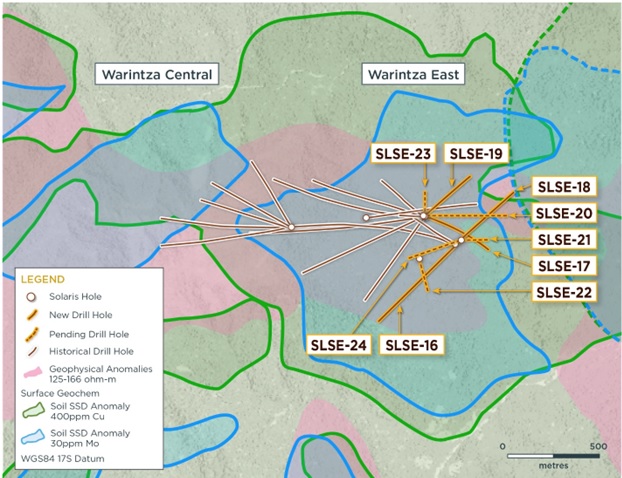
Solaris Resources (TSX:SLS) (OTCQB:SLSSF) has reported new assay results from a series of holes at the Warintza East Discovery aimed at growing mineral resources at the Warintza Project in Ecuador. The company made the initial discovery in July 2021, with a total of eight holes covering the overlapping periphery. These were included in the Warintza Central Mineral Resource Estimate (MRE) released in April 2022.
These new results expand the drilled dimensions of the Warintza East footprint to the northeast, east, and south. The deposit still remains open in those directions, with particularly strong soil anomalism to the south.
Mr. Jorge Fierro, Vice President, Exploration, commented in a press release: “Warintza East’s largely undrilled footprint is a target for major mineral resource growth in the ongoing drilling program where only minimal drilling was included in the MRE and adjoins with Warintza Central. Assays are pending from further extensional holes to the north and east and targeting strong soil anomalism in step-out drilling to the south.”
Highlights from the results are as follows:
- SLSE-16 was collared at the eastern limit of the grid and drilled southwest into an open volume, returning 108m of 0.57% CuEq² within a broader interval of 712m of 0.45% CuEq² from surface, extending mineralization to the south and southeast where it remains open
- This hole was collared approximately 250m to the southeast of SLSE-13 (refer to Company press release dated Nov 14, 2022), which previously returned 104m of 0.45% CuEq² from surface within a broader interval of 618m of 0.29% CuEq²
- SLSE-17 was collared in the middle of the Warintza East drill grid and drilled southeast into an open volume, returning 144m of 0.52% CuEq² from surface within a broader interval of 914m of 0.40% CuEq², extending mineralization to the east where it remains open
- This hole extends the drilled dimensions further to the east beyond SLSE-14 (refer to Company press release dated Nov 14, 2022), which previously returned 292m of 0.50% CuEq² from near surface within a broader interval of 694m of 0.40% CuEq²
- SLSE-19 was collared in the middle of the Warintza East drill grid and drilled northeast into an open volume, returning 270m of 0.40% CuEq² from surface within a broader interval of 580m of 0.31% CuEq², expanding the footprint to the northeast where it remains open
- Drilling to date confirms Warintza East as a significant porphyry deposit that adjoins Warintza Central and remains open for expansion, with assays pending from a series of extensional holes to the north, east, south and southeast
Table 1 – Assay Results
| Hole ID | Date Reported | From (m) | To (m) | Interval (m) | Cu (%) | Mo (%) | Au (g/t) | CuEq² (%) |
| SLSE-19 | Jan 17, 2023 | 0 | 580 | 580 | 0.24 | 0.01 | 0.03 | 0.31 |
| Including | 0 | 270 | 270 | 0.31 | 0.02 | 0.04 | 0.40 | |
| SLSE-18 | 30 | 524 | 494 | 0.16 | 0.01 | 0.04 | 0.20 | |
| SLSE-17 | 0 | 914 | 914 | 0.32 | 0.01 | 0.04 | 0.40 | |
| Including | 0 | 144 | 144 | 0.45 | 0.01 | 0.05 | 0.52 | |
| SLSE-16 | 8 | 720 | 712 | 0.36 | 0.02 | 0.05 | 0.45 | |
| Including | 76 | 184 | 108 | 0.46 | 0.02 | 0.06 | 0.57 |
Notes to table: True widths of the mineralized zone are not known at this time.
Table 2 – Collar Location
| Hole ID | Easting | Northing | Elevation (m) | Depth (m) | Azimuth (degrees) | Dip (degrees) |
| SLSE-19 | 801485 | 9648192 | 1170 | 816.48 | 48 | -65 |
| SLSE-18 | 801684 | 9648074 | 1221 | 1018.74 | 48 | -65 |
| SLSE-17 | 801485 | 9648192 | 1170 | 1011.39 | 105 | -70 |
| SLSE-16 | 801684 | 9648074 | 1221 | 844.61 | 225 | -45 |
| Notes to table: The coordinates are in WGS84 17S Datum. | ||||||
The above references an opinion and is for information purposes only. It is not intended to be investment advice. Seek a licensed professional for investment advice. The author is not an insider or shareholder of any of the companies mentioned above.
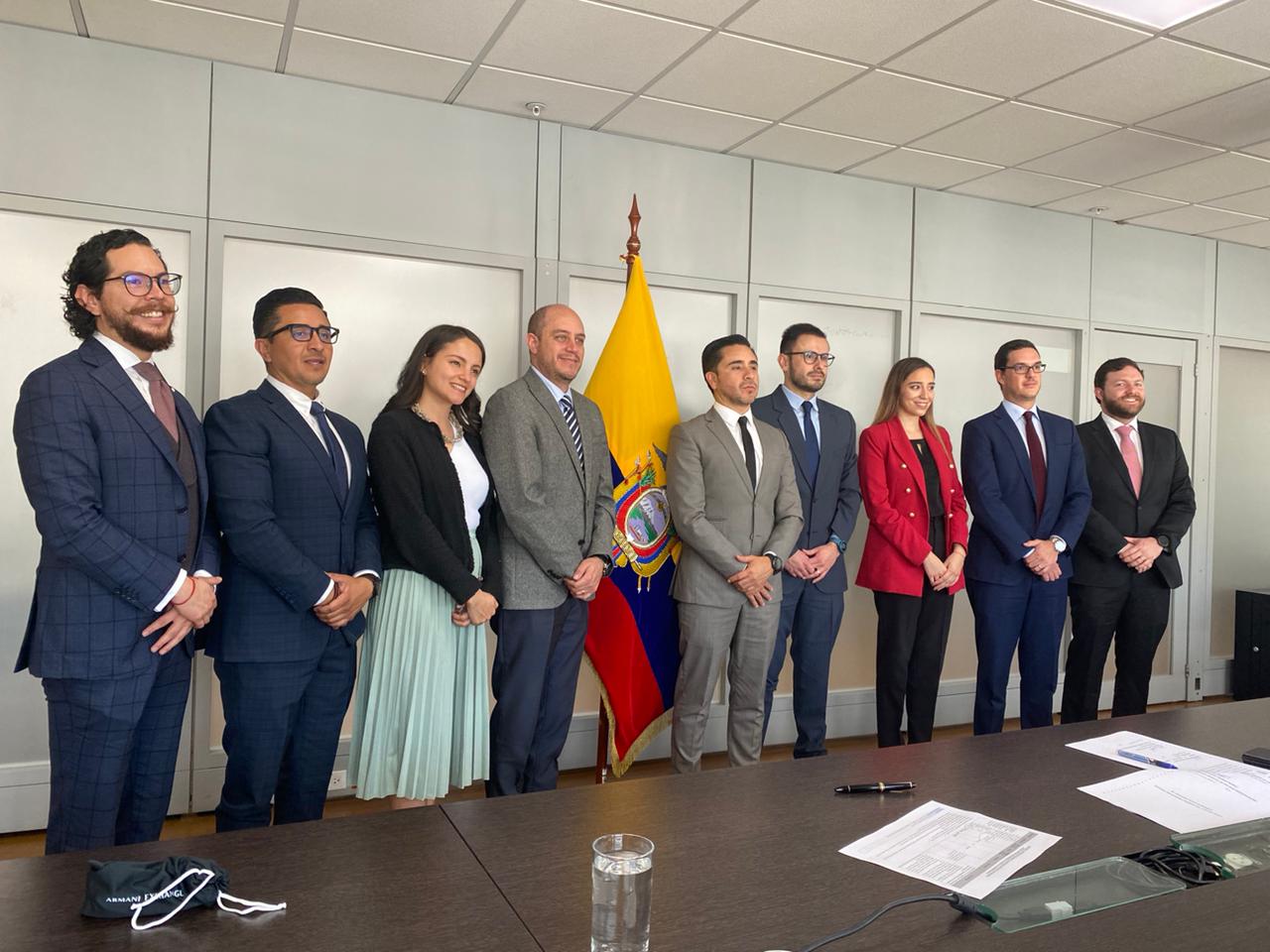
Solaris Resources (TSX:SLS) (OTCQB:SLSSF) has announced that a major Investment Contract for the Warintza Project has been signed. The contract ratifies the Investment Protection Agreement announced on June 9, 2022. The IPA provides a strong foundation of certainty for the company as it relates to the legal framework governing the project, including stable mining regulations, security of title and investment, and new tax incentives to accelerate development.
It includes specific protections related to the prohibitions of all forms of confiscation, non-discriminatory treatment, legal security, and tax stability. The agreement notes a 5% income tax reduction, fixes the income tax rate at 20% and includes an exemption from capital outflow tax and import duties for the import of goods needed for new investments. It also includes important detailed procedures for the dispute resolution process and stipulations for international arbitration protection.
Mr. Daniel Earle, President & CEO, commented: “We are very grateful to the Government of Ecuador and our host communities for their support in reaching this major milestone. The Investment Contract provides a foundation of certainty, significantly de-risking the Warintza Project by securing a stable regulatory and fiscal framework with international legal protections for the Project while also enhancing its returns through permanent new tax incentives.”
Mr. Julio José Prado, Minister of Production, Foreign Trade, Investment, and Fisheries of the Government of Ecuador, stated, “I want to thank Solaris for the commitment with the country and with Morona Santiago, it is an example of sustainable mining, responsible with the environment and the communities. Since the first contacts in the Ecuador Open for Business event, we have worked for a year and today we signed the Investment Contract. The Warintza Project has a very important influence, and they are working with the community in an exemplary manner; this will allow more development and prosperity for the zone and for Ecuador.”
Mr. Fernando Santos Alvite, Minister of Energy and Mines of the Government of Ecuador, stated, “I wish the best of success to the Warintza Project. This is a very important project for the country in terms of scale and investment. It is also important for what it represents, which is a great commitment and understanding between the communities and the Company.”
Mr. Vicente Tsakimp, Lead Coordinator of the Warintza Project Strategic Alliance, stated, “The Warints and Yawi Shuar Centers are glad that the Warintza Project is advancing and that we are part of it. Our work and coordination with the Company are an example that participatory mining can be done, and we are proud of everything we have achieved.”
Highlights from the agreement are as follows:
The Investment Contract provides for the following protections and incentives for the duration of the title of the Project which extends with renewal to 2066:
- Security of investment
- Stability of mining law
- Stability of taxes at a reduced income tax rate of 20% (25% previously)
- Exemption from capital outflow tax (5% previously)
- Exemption from import duties (up to 5% previously)
- Detailed procedures for dispute resolution and international arbitration protection
The above references an opinion and is for information purposes only. It is not intended to be investment advice. Seek a licensed professional for investment advice. The author is not an insider or shareholder of any of the companies mentioned above.
Solaris Resources (TSX:SLS) (OTCQB:SLSSF) has reported assay results from a series of holes aimed at growing the Northeast Extension of its ‘Indicative Starter Pit’ at the Warintza Project. The company has defined a 1.5Bt copper inventory in an open pit with a low strip ratio at the Warintza Central deposit, and within that, a high-grade starter pit driving really robust economics, which makes it one of the best greenfield development copper opportunities available globally.
The newest results from the project continue to build on past successes of four significant discoveries, and expand the ‘Indicative Starter Pit’ previously estimated at 180Mt at 0.82% CuEq.
Mr. Jorge Fierro, Vice President, Exploration, commented in a press release: “The Northeast Extension remains open to the north with assays pending from recently completed holes. Further extensional drilling is planned with a 200m step-out platform on the northeastern margin of the drill grid aimed at expanding the zone in this direction. We’re also expecting assays from the remaining holes drilled from the discovery platform at Warintza West outlining a mineralized porphyry with minimum dimensions of 900m x 600m and open outside the MRE for future resource drilling, and the next series of holes targeting the expansion of Warintza East.”
Highlights from the results are as follows:
Resource expansion drilling continues to build on the Northeast Extension of the ‘Indicative Starter Pit’ which was estimated at 180 Mt at 0.82% CuEq¹ (Indicated) and 107 Mt at 0.73% CuEq¹ (Inferred) within the Warintza Mineral Resource Estimate² (“MRE”) based on drilling to the end of 2021. Follow-up drilling this year has significantly expanded the dimensions of the zone as a priority for high-impact growth with further drilling ongoing.
- SLS-67 was collared at the north-central limit of Warintza Central and drilled southwest into a partially open volume, returning 108m of 1.20% CuEq¹ within a broader interval of 604m of 0.51% CuEq¹ from near surface
- This hole expands on the area of high-grade near surface mineralization in combination with SLS-48 which was collared from the same platform but drilled south, returning 100m of 1.64% CuEq³ within a broader interval of 852m of 0.56% CuEq³ from near surface (refer to press release dated Feb 28, 2022)
- SLS-68 was collared from the same platform as SLS-67 and drilled steeply to the northwest into an open volume, returning 72m of 1.00% CuEq¹ within a broader interval of 616m of 0.44% CuEq¹ from near surface, expanding this area of higher-grade mineralization from near surface
- SLS-65 was collared from a recently constructed 250m step-out platform at the northeast limit of the Warintza Central grid and drilled northwest into a partially open volume, returning 286m of 0.55% CuEq¹ from near surface
- Assays are pending from a series of holes from this new drill platform aimed at further expanding resource growth in the Northeast Extension zone, with additional extension and step-out drilling underway
Figure 1 – Plan View of Warintza Central Drilling Released to Date
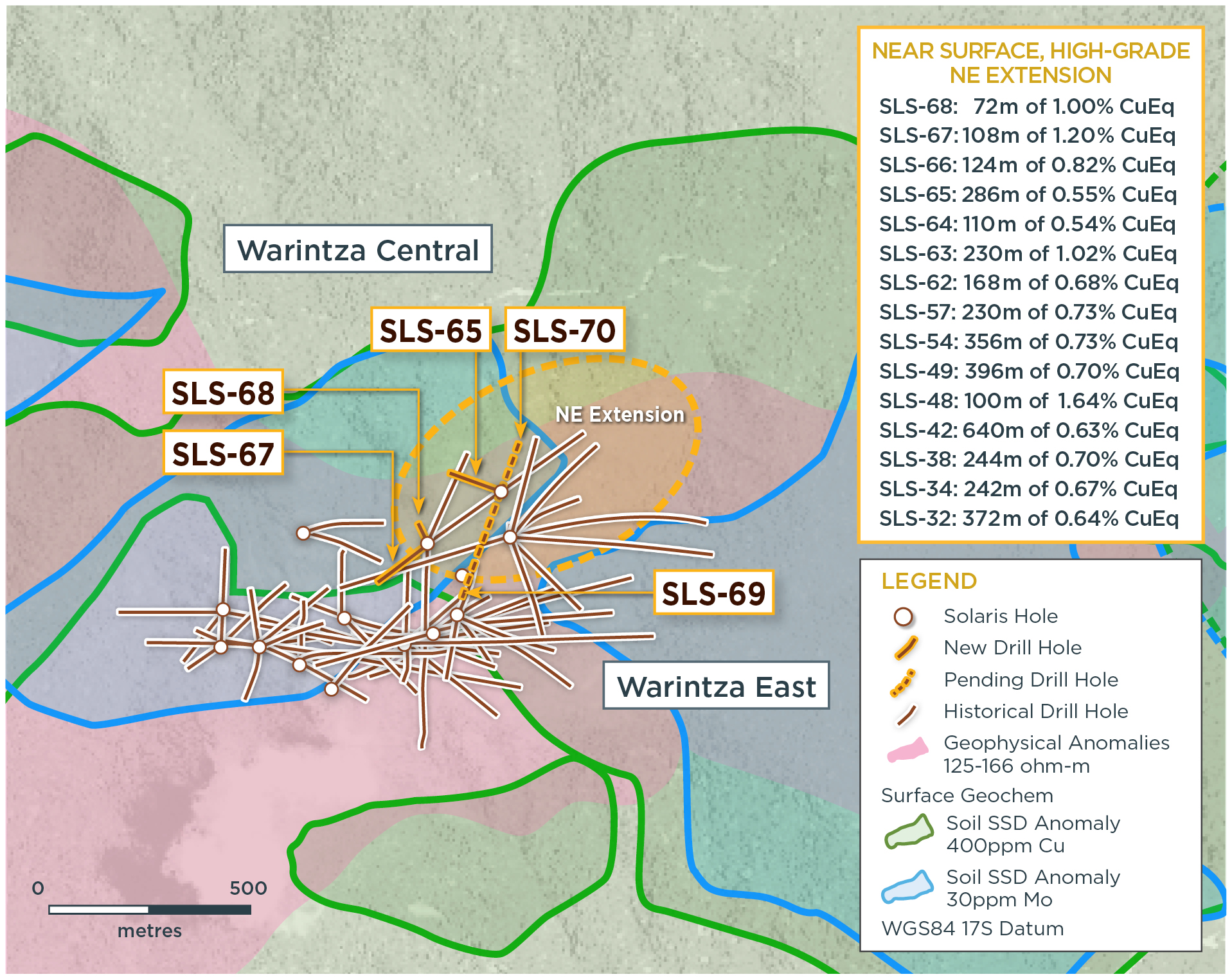
Table 1 – Assay Results
| Hole ID | Date Reported | From (m) | To (m) | Interval (m) | Cu (%) | Mo (%) | Au (g/t) | CuEq¹ (%) |
| SLS-68 | Dec 5, 2022 | 44 | 660 | 616 | 0.34 | 0.02 | 0.04 | 0.44 |
| Including | 68 | 140 | 72 | 0.88 | 0.02 | 0.06 | 1.00 | |
| SLS-67 | 42 | 646 | 604 | 0.40 | 0.02 | 0.05 | 0.51 | |
| Including | 42 | 150 | 108 | 1.06 | 0.03 | 0.09 | 1.20 | |
| SLS-65 | 88 | 374 | 286 | 0.38 | 0.04 | 0.06 | 0.55 | |
| Notes to table: True widths of the mineralized zone are not known at this time. | ||||||||
Table 2 – Collar Location
| Hole ID | Easting | Northing | Elevation (m) | Depth (m) | Azimuth (degrees) | Dip (degrees) |
| SLS-68 | 800178 | 9648285 | 1439 | 662 | 332 | -85 |
| SLS-67 | 800178 | 9648285 | 1439 | 673 | 230 | -76 |
| SLS-65 | 800347 | 9648415 | 1346 | 401 | 290 | -70 |
| Notes to table: The coordinates are in WGS84 17S Datum. | ||||||
The above references an opinion and is for information purposes only. It is not intended to be investment advice. Seek a licensed professional for investment advice. The author is not an insider or shareholder of any of the companies mentioned above.
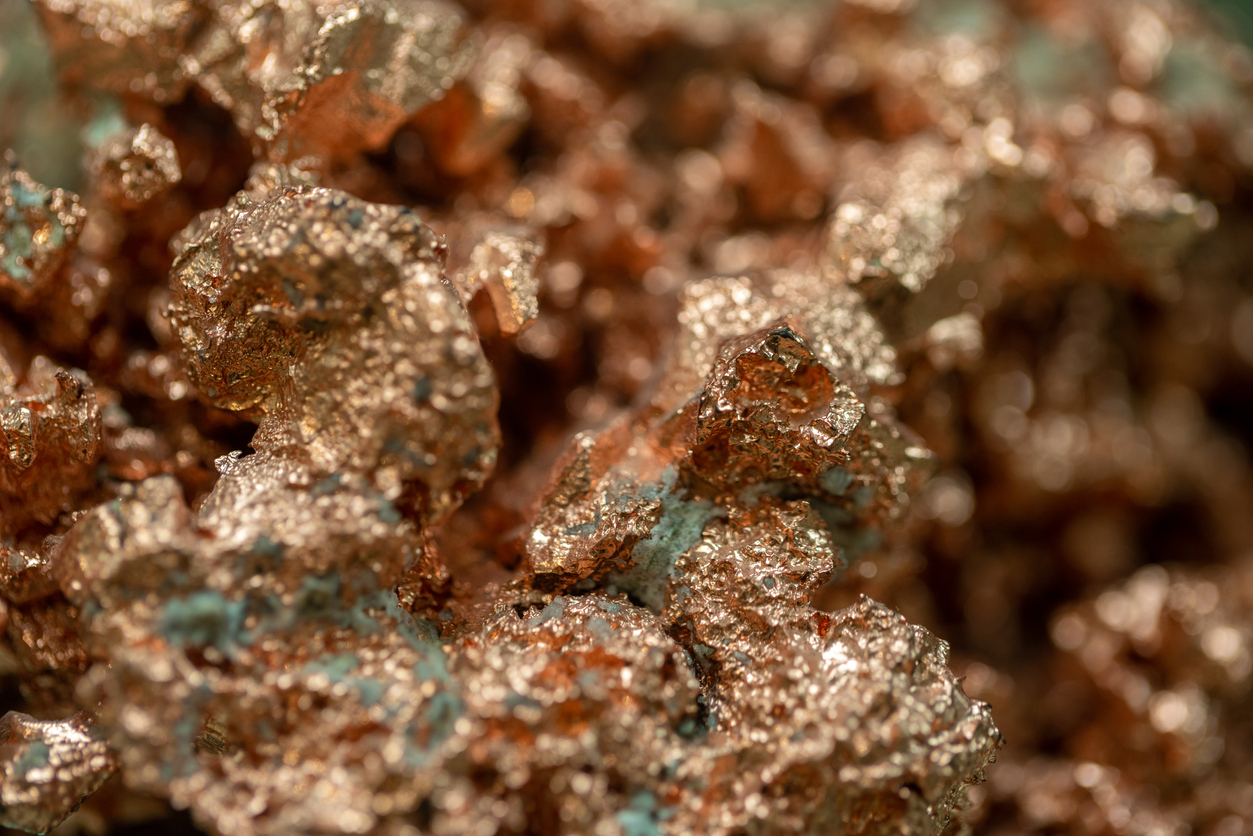
The mining sector has put itself in a difficult position, underinvesting in new copper projects when copper demand is rising. The good news for those looking for a copper investment is that there are still a number of new copper projects in the works.
One of these projects is the Warintza copper project in southeastern Ecuador. Warintza is a world-class large-scale resource with expansion and discovery potential. There have been four major discoveries since the project started and the Mineral Resource Estimate at the project has been expanded from earlier in 2022. Most recently, Canadian mining company Solaris Resources (TSX:SLS) (OTCQB:SLSSF), which owns Warintza, reported new assay results from a series of holes aimed at delineating resources at the Warintza East discovery.
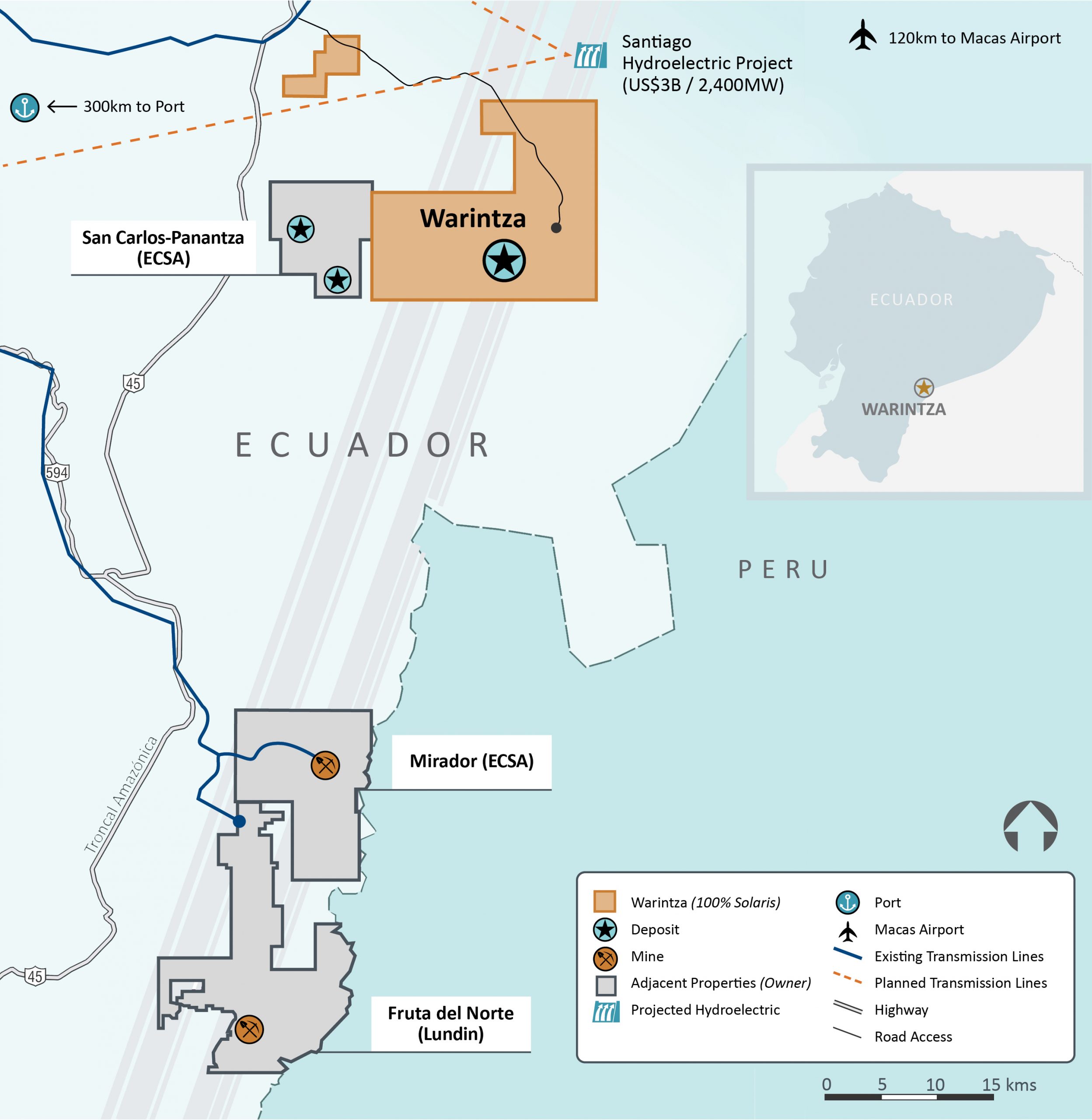
Highlights from the results are as follows:
Warintza East was discovered in July 2021, with eight holes covering the overlapping periphery included in the Warintza Central Mineral Resource Estimate (“MRE”)¹ in April 2022. These follow-up drilling results significantly expand the drilled dimensions of the Warintza East footprint to the east and southwest, with the deposit remaining entirely open towards strong soil anomalism to the northeast and southeast.
- SLSE-15 was collared in the middle of the Warintza East grid and drilled east into a partially open volume, returning 204m of 0.60% CuEq² within a broader interval of 910m of 0.40% CuEq² from near surface, extending mineralization to the east where it remains open
- SLSE-14, stepped out approximately 250m from the eastern limit of the grid and drilled northwest into an open volume, returning 292m of 0.50% CuEq² within a broader interval of 694m of 0.40% CuEq² from near surface, extending mineralization in this direction where it remains open
- SLSE-12 was collared at the eastern limit of the grid and drilled southwest into an open volume, returning 48m of 0.53% CuEq² within a broader interval of 508m of 0.40% CuEq² from surface, extending mineralization in this direction
- SLSE-13 was collared from the same platform and drilled southwest into an open volume, returning 104m of 0.45% CuEq² within a broader interval of 618m of 0.29% CuEq² from surface, expanding the footprint to the south where it remains open
- SLSE-10 and SLSE-11 were collared in the overlapping portion with Warintza Central and drilled northwest into partially open volumes, returning 282m of 0.53% CuEq² and 270m of 0.55% CuEq², respectively, within broader intervals from near surface
- Drilling to date confirms Warintza East as a significant porphyry deposit which remains open for expansion in multiple areas, with assays pending from a series of extensional holes to the northeast, east and south
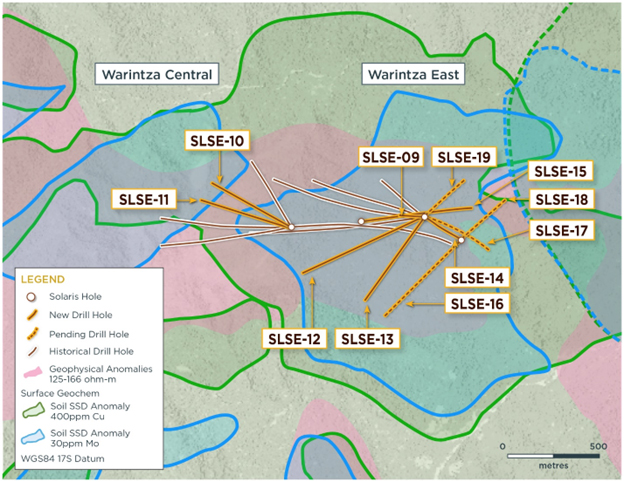
Warintza stands out in an environment where under-investment in new copper mines and exploration is jeopardizing the metal-intensive energy transition. Massive amounts of copper will be needed for everything from electric vehicles to renewable energy infrastructure.
Companies have instead focused on expanding mines with stronger guarantees of shareholder returns, playing it safe, but in turn, neglecting to invest in new projects. This focus on short-term shareholder returns and paying out dividends or using cash for share buybacks has left the discoveries to junior mining companies that are developing some of the most promising projects in the world. New copper mines take decades to achieve commercial production, and only exploration being done at projects right now has a chance of coming online in time for it to make a difference for future production levels.
Additionally, new discoveries have typically been of lower grades, making the Warintza Project an exceptional outlier in an environment when alarms are sounding for supply and demand dynamics. Lower grades ultimately make the copper more expensive to extract, but the potential for the high-grade “superpit” at Warintza is exactly what companies are looking for.
The future of copper is bright, but only if we see more investments in new projects like Warintza. Solaris Resources is one of the few mining companies that is making such investments, and the prospects for the Warintza project look very promising.
The above references an opinion and is for information purposes only. It is not intended to be investment advice. Seek a licensed professional for investment advice. The author is not an insider or shareholder of any of the companies mentioned above.
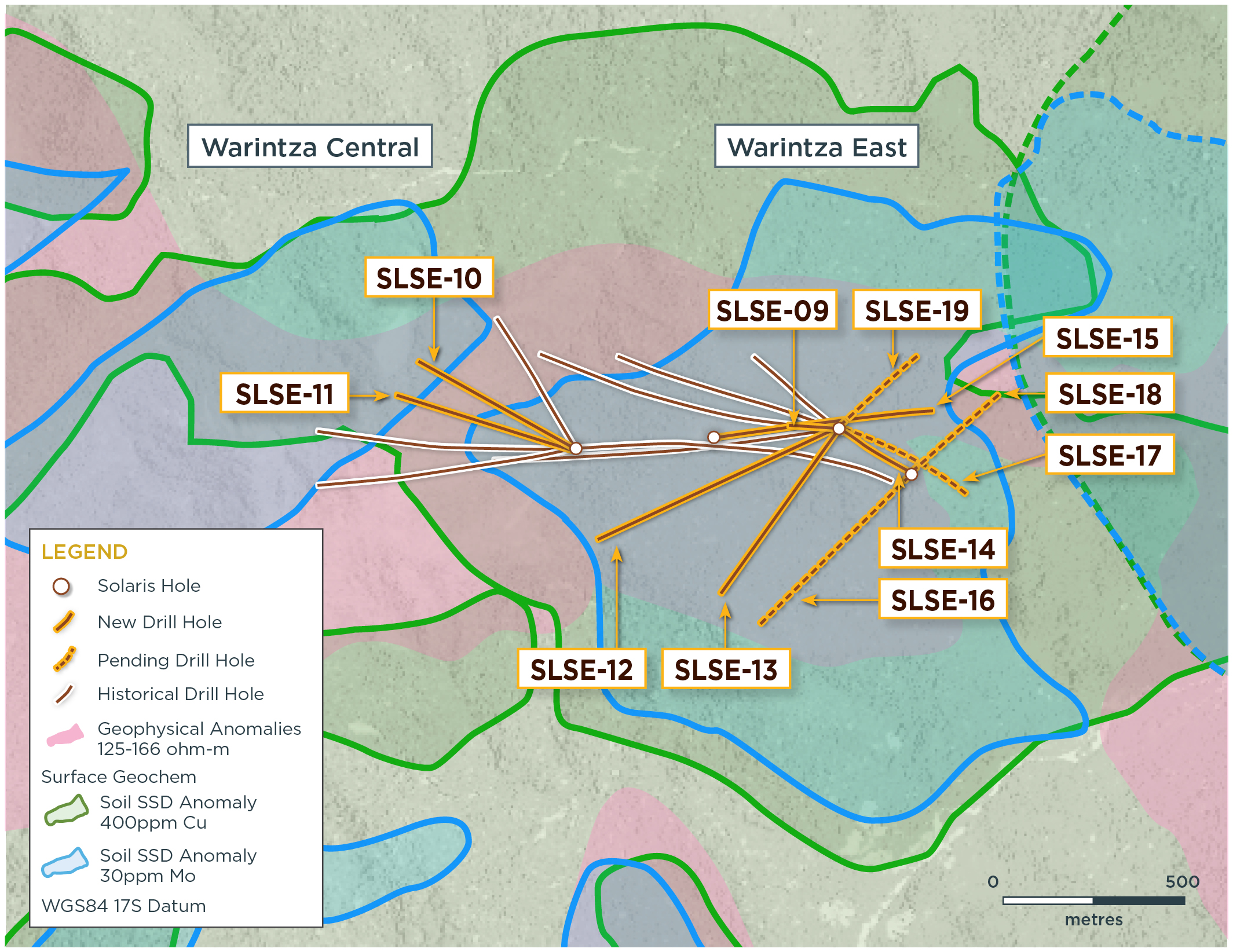
Solaris Resources (TSX:SLS) (OTCQB:SLSSF) has reported assay results from a series of holes aimed at delineating resources at the Warintza East discovery at the Warintza Project. These results significantly expand the Warintza East discovery originally discovered in July 2021, and included eight holes covering the overlapping periphery included in the Warintza Central Mineral Resource Estimate from April 2022. The results expand the dimensions of the Warintza East footprint to the east and southwest, and the deposit remains open towards strong soil anomalism to the northeast and southeast.
Mr. Jorge Fierro, Vice President, Exploration, commented in a press release: “Drilling to date covers only a small portion of the Warintza East discovery, which represents a target for major resource growth. Further extensional and step-out drilling is planned to the east and southeast with a 400m step-out platform located on the southern margin of the drill grid targeting strong soil anomalism in this area.”
Highlights from the results include:
- SLSE-15 was collared in the middle of the Warintza East grid and drilled east into a partially open volume, returning 204m of 0.60% CuEq² within a broader interval of 910m of 0.40% CuEq² from near surface, extending mineralization to the east where it remains open
- SLSE-14, stepped out approximately 250m from the eastern limit of the grid and drilled northwest into an open volume, returning 292m of 0.50% CuEq² within a broader interval of 694m of 0.40% CuEq² from near surface, extending mineralization in this direction where it remains open
- SLSE-12 was collared at the eastern limit of the grid and drilled southwest into an open volume, returning 48m of 0.53% CuEq² within a broader interval of 508m of 0.40% CuEq² from surface, extending mineralization in this direction
- SLSE-13 was collared from the same platform and drilled southwest into an open volume, returning 104m of 0.45% CuEq² within a broader interval of 618m of 0.29% CuEq² from surface, expanding the footprint to the south where it remains open
- SLSE-10 and SLSE-11 were collared in the overlapping portion with Warintza Central and drilled northwest into partially open volumes, returning 282m of 0.53% CuEq² and 270m of 0.55% CuEq², respectively, within broader intervals from near surface
- Drilling to date confirms Warintza East as a significant porphyry deposit which remains open for expansion in multiple areas, with assays pending from a series of extensional holes to the northeast, east and south
Figure 1 – Plan View of Warintza East Drilling Released to Date
Table 1 – Assay Results
| Hole ID | Date Reported | From (m) | To (m) | Interval (m) | Cu (%) | Mo (%) | Au (g/t) | CuEq² (%) |
| SLSE-15 | Nov 14, 2022 | 124 | 1,034 | 910 | 0.31 | 0.02 | 0.04 | 0.40 |
| Including | 252 | 456 | 204 | 0.50 | 0.02 | 0.05 | 0.60 | |
| SLSE-14 | 24 | 718 | 694 | 0.29 | 0.02 | 0.04 | 0.40 | |
| Including | 24 | 316 | 292 | 0.40 | 0.02 | 0.05 | 0.50 | |
| SLSE-13 | 4 | 622 | 618 | 0.22 | 0.01 | 0.03 | 0.29 | |
| Including | 0 | 104 | 104 | 0.31 | 0.03 | 0.03 | 0.45 | |
| SLSE-12 | 0 | 508 | 508 | 0.29 | 0.02 | 0.04 | 0.40 | |
| Including | 0 | 48 | 48 | 0.46 | 0.01 | 0.04 | 0.53 | |
| SLSE-11 | 112 | 600 | 488 | 0.30 | 0.01 | 0.03 | 0.38 | |
| Including | 330 | 600 | 270 | 0.43 | 0.03 | 0.04 | 0.55 | |
| SLSE-10 | 78 | 576 | 498 | 0.33 | 0.01 | 0.05 | 0.39 | |
| Including | 294 | 576 | 282 | 0.44 | 0.01 | 0.06 | 0.53 | |
| SLSE-09 | 0 | 773 | 773 | 0.18 | 0.03 | 0.03 | 0.30 | |
| Including | 0 | 212 | 212 | 0.30 | 0.02 | 0.04 | 0.42 |
Notes to table: True widths of the mineralized zone are not known at this time.
Table 2 – Collar Location
| Hole ID | Easting | Northing | Elevation (m) | Depth (m) | Azimuth (degrees) | Dip (degrees) |
| SLSE-15 | 801134 | 9648177 | 1382 | 1070 | 85 | -62 |
| SLSE-14 | 801684 | 9648074 | 1221 | 872 | 300 | -75 |
| SLSE-13 | 801481 | 9648205 | 1170 | 800 | 215 | -45 |
| SLSE-12 | 801485 | 9648192 | 1170 | 981 | 245 | -46 |
| SLSE-11 | 800749 | 9648146 | 1282 | 862 | 285 | -60 |
| SLSE-10 | 800749 | 9648146 | 1282 | 691 | 300 | -50 |
| SLSE-09 | 801485 | 9648192 | 1170 | 774 | 271 | -80 |
| Notes to table: The coordinates are in WGS84 17S Datum. |
Endnotes
- Refer to Solaris’ press release dated April 18, 2022 and technical report titled, “NI 43-101 Technical Report for the Warintza Project, Ecuador” with an effective date of April 1, 2022, prepared by Mario E. Rossi and filed on the Company’s SEDAR profile at www.sedar.com.
- Copper-equivalence calculated as: CuEq (%) = Cu (%) + 4.0476 × Mo (%) + 0.487 × Au (g/t), utilizing metal prices of US$3.50/lb Cu, US$15.00/lb Mo, and US$1,500/oz Au, and assumes recoveries of 90% Cu, 85% Mo, and 70% Au based on preliminary metallurgical test work.
The above references an opinion and is for information purposes only. It is not intended to be investment advice. Seek a licensed professional for investment advice. The author is not an insider or shareholder of any of the companies mentioned above.
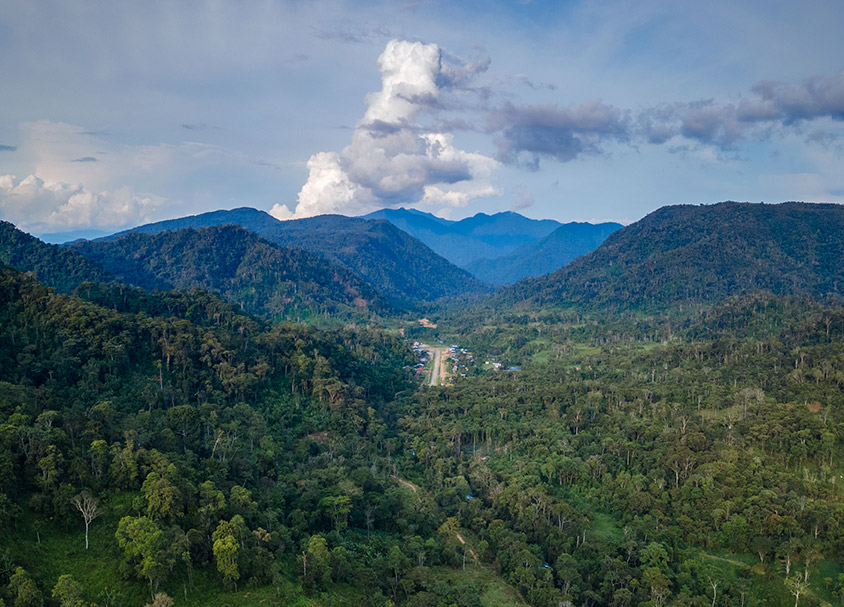
Solaris Resources (TSX:SLS) (OTCQB:SLSSF) has announced that it received exercises of common share purchase warrants for a total of C$18.7 million since the last quarterly results dated August 9, 2022. Mr. Richard Warke represented the majority of the warrants exercised, and exercised 2.3 million at a price of C$6.75, a 37% premium to the close of trading on Friday, October 28, 2022. On top of those warrants, Mr. Warke also exercised 0.6 million warrants at C$1.20 for proceeds of C$0.7 million.
More warrants remain outstanding and are set to expire by the end of 2022. There are 3.1 warrants at a price of C$1.20 and 0.2 million warrants at a price of C$6.75 outstanding which would generate proceed of C$4.9 million. 50% of those warrants are held by company insiders. By May 2023, 25 million warrants will expire at C$1.20, which if exercised in full, would generate C$30 million, with 98% of those warrants held by company insiders.
The above references an opinion and is for information purposes only. It is not intended to be investment advice. Seek a licensed professional for investment advice. The author is not an insider or shareholder of any of the companies mentioned above.
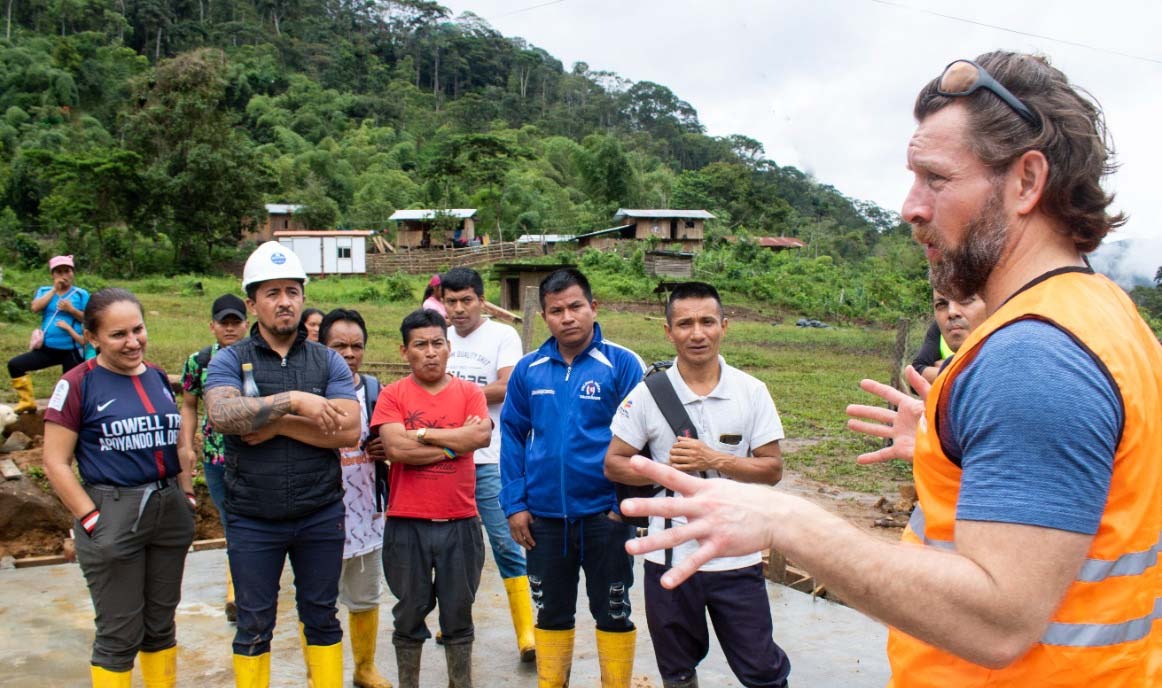

The copper market has been on a tear in recent years and is expected to continue to do well in the near future. This is good news for Warintza Project’s (TSX:SLS) (OTCQB:SLSSF) copper project, as it will take advantage of the market’s tailwinds in a way that most other junior mining companies’ projects won’t be able to. Solaris recently published results from Warintza West, marking the fourth discovery within the Warintza porphyry cluster.
Located just 1 kilometre west of the Warintza Central Mineral Resource Estimate (MRE), the discovery was reported with the results of SLSW-01. Another big discovery for the company, it outlines a broad porphyry deposit of at least 900m x 600m and till open and miles adjacent to but not included within the MRE. This significantly expands the opportunities at the project which has the potential to be a “super-pit”.
Exciting results from the report included:
- SLSW-07 (drilled north) returned 686m of 0.46% CuEq¹ within a broader interval of 912m of 0.41% CuEq¹ from near surface
- SLSW-02 (drilled vertically) returned 246m of 0.47% CuEq¹ from near surface
- SLSW-09 (drilled west) returned 202m of 0.45% CuEq¹ within a broader interval of 444m of 0.36% CuEq¹ from near surface
- SLSW-08 (drilled northwest) returned 78m of 0.56% CuEq¹ within a broader interval of 812m of 0.32% CuEq¹ from near surface
- SLSW-04 (drilled northeast) returned 264m of 0.44% CuEq¹ from near surface
- SLSW-10 (drilled southwest) returned 220m of 0.41% CuEq¹ from near surface
- SLSW-03 (drilled southeast) returned 102m of 0.39% CuEq¹ within a broader interval of 911m of 0.24% CuEq¹ from near surface
- SLSW-05 (drilled northeast) returned 272m of 0.38% CuEq¹ within a broader interval of 570m of 0.30% CuEq¹ from near surface
- SLSW-06 (drilled east) returned 732m of 0.32% CuEq¹ from near surface
These results and the project also stand out for a few reasons:
The project is located in a key copper-producing region
The project is located in a key copper-producing region The project is located in a key copper-producing region of southeastern Ecuador.
The company has committed to fully transparent disclosure
With a good copper price forecast and a commitment to fully disclose all exploration results, Warintza Project is well-positioned to benefit from the market’s current momentum and investor enthusiasm through each new discovery.
ESG strategy
Solaris Resources has a strong environmental, social and governance (ESG) strategy. This includes consultation with local communities and sustainable mining practices.
A project developed at just the right time
As the green energy transition gains momentum, copper is becoming an increasingly important component of sustainable infrastructure. Copper is also a critical component of many modern technologies, including renewable energy and electric vehicles.
While spot copper prices are all over the place due to larger market forces, the long-term trend remains strongly in place. As potentially one of the largest new projects of its kind, Warintza Project and Solaris Resources are ideally situated to capitalize.
The above references an opinion and is for information purposes only. It is not intended to be investment advice. Seek a licensed professional for investment advice. The author is not an insider or shareholder of any of the companies mentioned above.



100% sustainable energy is the goal of environmentalists and lawmakers alike. However, a sticking point in achieving this goal is finding enough raw materials to create solar panels without damaging the environment. This is where Solaris Resources (TSX:SLS) (OTCQB:SLSSF) comes in. Solaris Resources is a copper mining company that specializes in finding and extracting copper, one of the key metals in the renewable energy transition, with minimal impact on the environment.
Solaris’ flagship Warintza project in Ecuador is operated according to the most stringent of ESG principles, without compromising the performance of the drill program. The company has just made its fourth discovery at the project of a broad porphyry deposit of at least 900m x 600 m and still open. This deposit is adjacent to and is not included in the Mineral Resource Estimate (MRE) from Warintza Central. The project is also set to be supplied by the Electric Corporation of Ecuador with low-cost, locally-sourced hydroelectric power.
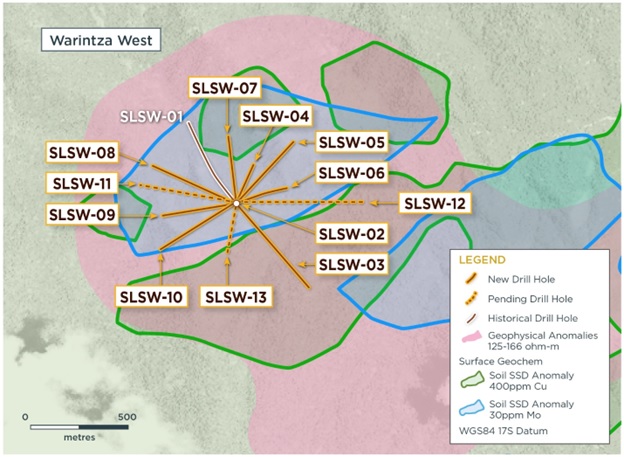

Copper projects are set to power the increase in manufacturing for solar panels, however, new projects are scarce, and shortages threaten to drive up prices. Solaris Resources is working to alleviate this issue by mining copper in a way that is respectful of the environment. Those same shortages could even delay the transition to renewable energy.
Despite this, the growth in solar power has been exponential in recent years, with the market projected to grow by over a hundred billion dollars in the coming years.
Copper at the Crossroads
Renewable energy sources, such as solar and wind, rely on certain metals to create electrical currents. Copper is one of the key metals that is needed in large quantities to make these sources of energy work. Copper is one of the most important metals in this area, as it is not just critical to solar power but all of the energy infrastructure, putting it at an important crossroads.
The infrastructure that is needed to support renewable energy is also reliant on copper. Copper cables, for example, are essential for transmitting power from the solar panels to the places where it is needed. Copper is also used in batteries to store energy.
The material used to create solar panels is also important. Solar panels are made from a variety of materials, but the most common is polysilicon. Polysilicon is a type of plastic that is used to create solar panels. Polysilicon is made from a variety of materials, but the most common is silicon. Silicon is not suffering the same shortages as other minerals and metals.
The shortage of copper has also driven up the price of copper. If the price of copper continues to increase, it could delay the transition to renewable energy.
Mining Industry Scramble
Rising prices, tight markets, and environmental concerns have all contributed to the unprecedented scramble by the mining industry to bring new projects to production. The first way this is being done is through exploration. Exploration is when miners look for new deposits to extract copper from. This is an expensive and time-consuming process, so it is often only done when there is a good chance that a deposit will be profitable.
Another way that the mining industry is trying to bring new projects to production is by renegotiating contracts. When a company has a contract to produce copper, it may be able to renegotiate the contract to produce other materials as well. For example, a company may have a contract to produce copper, but if the price of copper increases, it may be able to renegotiate the contract to produce aluminum.
The mining industry is also trying to bring new projects to production faster by investing in new technologies. This is often done by investing in new mining equipment. For example, the mining industry is trying to bring new projects to production by investing in new hydraulic fracturing technology. hydraulic fracturing is a process that is used to break down rocks to extract minerals.
As the mining industry scrambles to bring new projects to production, it is important that the regulators are aware of these efforts and are able to provide the necessary permits and licenses. If the regulators are not aware of these efforts, it could lead to delays in the production of the new projects. Concerns in the United States that permitting laws are not changing fast enough to move in lockstep with growing investment in battery metal and copper mining projects also remain.
However, projects around the world, including the Warintza Project in southeastern Ecuador, are moving forward with a focus on sustainability and social responsibility. Solaris Resources is one of the few mining companies that have a long track record of operating according to the most stringent of ESG principles, without compromising the performance of its drill programs.
The above references an opinion and is for information purposes only. It is not intended to be investment advice. Seek a licensed professional for investment advice. The author is not an insider or shareholder of any of the companies mentioned above.
Solaris Resources (TSX:SLS) has reported new assay results today from the first series of drill holes during follow-up drilling on the discovery of Warintza West. The results outline a new deposit that remains open in the Warintza cluster, just adjacent to the Mineral Resource Estimate (MRE) the company published in April 2022.
These follow-up holes fan out in all directions, outlining a broad porphyry deposit of at least 900m x 600m and still open and lies adjacent to and not included within the MRE. The company is focusing on targeting growth for the high-grade starter pit at Warintza Central and expanding the Warintza East discovery next while continuing the planned drilling at Warintza West. The Warintza Project is located in southeastern Ecuador, and Warintza West is the fourth and latest discovery at the project.
Highlights from the results are as follows:
Warintza West is one of four discoveries made to date within the Warintza porphyry cluster and is located 1km west of the Warintza Central Mineral Resource Estimate (“MRE”)¹ reported in April. The discovery was reported with the results of SLSW-01 (see press release dated February 16, 2021) – these follow-up holes fan out in all directions, outlining a broad porphyry deposit of at least 900m x 600m and still open and lies adjacent to and not included within the MRE. Follow-up drilling to test the further extent of the deposit is planned after priority drilling at Warintza Central aimed at expanding the starter pit and higher-grade resource expansion potential at Warintza East.
- SLSW-07 (drilled north) returned 686m of 0.46% CuEq¹ within a broader interval of 912m of 0.41% CuEq¹ from near surface
- SLSW-02 (drilled vertically) returned 246m of 0.47% CuEq¹ from near surface
- SLSW-09 (drilled west) returned 202m of 0.45% CuEq¹ within a broader interval of 444m of 0.36% CuEq¹ from near surface
- SLSW-08 (drilled northwest) returned 78m of 0.56% CuEq¹ within a broader interval of 812m of 0.32% CuEq¹ from near surface
- SLSW-04 (drilled northeast) returned 264m of 0.44% CuEq¹ from near surface
- SLSW-10 (drilled southwest) returned 220m of 0.41% CuEq¹ from near surface
- SLSW-03 (drilled southeast) returned 102m of 0.39% CuEq¹ within a broader interval of 911m of 0.24% CuEq¹ from near surface
- SLSW-05 (drilled northeast) returned 272m of 0.38% CuEq¹ within a broader interval of 570m of 0.30% CuEq¹ from near surface
- SLSW-06 (drilled east) returned 732m of 0.32% CuEq¹ from near surface
- Drilling at Warintza West confirms the interpretation of a broad porphyry deposit that remains open in all directions, with assays pending from a series of three additional holes testing the zone further to the west, east and south
- Step-out drilling is planned targeting high-grade surface sampling
Figure 1 – Plan View of Warintza West Drilling Released to Date
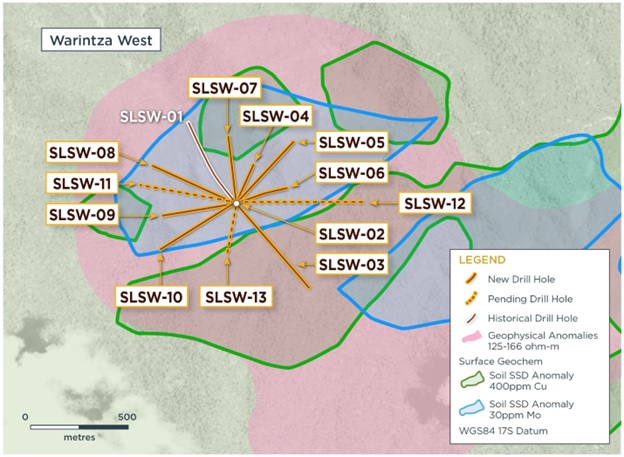

Table 1 – Assay Results
| Hole ID | Date Reported | From (m) | To (m) | Interval (m) | Cu (%) | Mo (%) | Au (g/t) | CuEq¹ (%) |
| SLSW-10 | 24 | 244 | 220 | 0.36 | 0.01 | 0.02 | 0.41 | |
| SLSW-09 | 24 | 468 | 444 | 0.31 | 0.01 | 0.03 | 0.36 | |
| Including | 24 | 226 | 202 | 0.41 | 0.01 | 0.03 | 0.45 | |
| SLSW-08 | 32 | 844 | 812 | 0.26 | 0.01 | 0.02 | 0.32 | |
| Including | 32 | 110 | 78 | 0.51 | 0.01 | 0.02 | 0.56 | |
| SLSW-07 | 24 | 936 | 912 | 0.32 | 0.02 | 0.03 | 0.41 | |
| Including | Oct 13, 2022 | 30 | 716 | 686 | 0.37 | 0.02 | 0.03 | 0.46 |
| SLSW-06 | 34 | 766 | 732 | 0.25 | 0.01 | 0.02 | 0.32 | |
| SLSW-05 | 34 | 604 | 570 | 0.23 | 0.01 | 0.02 | 0.30 | |
| Including | 34 | 306 | 272 | 0.31 | 0.01 | 0.02 | 0.38 | |
| SLSW-04 | 38 | 302 | 264 | 0.36 | 0.02 | 0.03 | 0.44 | |
| SLSW-03 | 38 | 949 | 911 | 0.19 | 0.01 | 0.02 | 0.24 | |
| Including | 40 | 142 | 102 | 0.33 | 0.01 | 0.03 | 0.39 | |
| SLSW-02 | 24 | 270 | 246 | 0.38 | 0.02 | 0.02 | 0.47 |
Notes to table: True widths of the mineralized zone are not known at this time.
Table 2 – Collar Location
| Hole ID | Easting | Northing | Elevation (m) | Depth (m) | Azimuth (degrees) | Dip (degrees) |
| SLSW-10 | 798507 | 9648465 | 1519 | 713 | 238 | -51.25 |
| SLSW-09 | 798507 | 9648465 | 1519 | 767 | 260 | -60.31 |
| SLSW-08 | 798507 | 9648465 | 1519 | 974 | 295 | -60.50 |
| SLSW-07 | 798507 | 9648465 | 1519 | 945 | 352 | -70.56 |
| SLSW-06 | 798507 | 9648465 | 1519 | 767 | 70 | -70.72 |
| SLSW-05 | 798507 | 9648465 | 1519 | 807 | 45 | -60.73 |
| SLSW-04 | 798507 | 9648465 | 1519 | 455 | 22 | -60.89 |
| SLSW-03 | 798507 | 9648465 | 1519 | 949 | 140 | -55.50 |
| SLSW-02 | 798507 | 9648465 | 1519 | 1227 | 0 | -90.00 |
| Notes to table: The coordinates are in WGS84 17S Datum. | ||||||
Endnotes
- Refer to Solaris’ press release dated April 18, 2022 and technical report titled, “NI 43-101 Technical Report for the Warintza Project, Ecuador” with an effective date of April 1, 2022, prepared by Mario E. Rossi and filed on the Company’s SEDAR profile at www.sedar.com.
- Copper-equivalence calculated as: CuEq (%) = Cu (%) + 4.0476 × Mo (%) + 0.487 × Au (g/t), utilizing metal prices of US$3.50/lb Cu, US$15.00/lb Mo, and US$1,500/oz Au, and assumes recoveries of 90% Cu, 85% Mo, and 70% Au based on preliminary metallurgical test work.
The above references an opinion and is for information purposes only. It is not intended to be investment advice. Seek a licensed professional for investment advice. The author is not an insider or shareholder of any of the companies mentioned above.
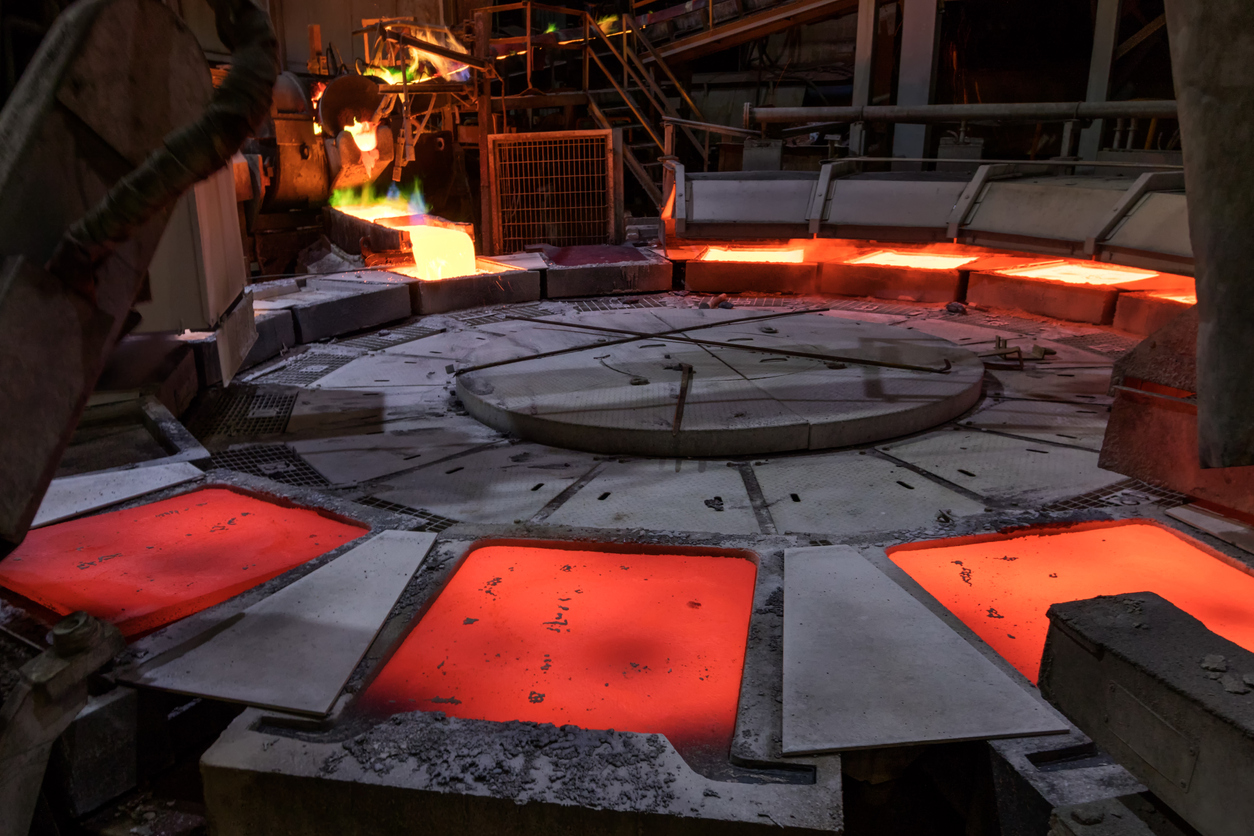

The global demand for minerals has placed a spotlight on the need for a stronger industrial base, one that includes more domestic production and processing of metals that are critical for a modern society. Energy security is strongly linked to mining, as minerals are essential ingredients in the production of energy technologies. Despite the critical role of minerals in securing economic futures and the protection of our planet, the U.S. continues to delay many high-value mining projects while deepening import dependence on the materials they provide.
Current energy disruptions have made it even more clear that a mineral and metals supply chain that relies heavily on a handful of countries can make the whole chain weak. Since Russia’s invasion of Ukraine, the U.S. and EU have looked for ways to reduce their dependence on Russian natural gas. One promising solution is to develop shale gas resources in the United States, which would help create jobs and reduce greenhouse gas emissions. However, this process requires large amounts of minerals, such as sand, clay, and limestone – all of which are in short supply.
Copper is another tight market being squeezed due to other supply chain issues that were exacerbated during the COVID-19 pandemic. New projects are in short supply, so companies are often eager to acquire new high-grade copper projects when they become available. The Warintza Project in southeastern Ecuador is operated by Solaris Resources (TSX:SLS) a junior mining company that is currently advancing the project towards production.
The Warintza Project has the potential to fill some of the gaps in the current copper market. The project is expected to produce approximately 100 million pounds of copper per year, making it one of the largest copper mines in Ecuador. In addition, the Warintza Project has been called a potential “super pit”, and has released a mineral resource estimate for a significant ‘Indicative Starter Pit’. The company reported in-pit resources of 579 Mt at 0.59% CuEq (Ind) and 887 Mt at 0.47% CuEq (Inf), and 180 Mt at 0.82% CuEq (Ind) and 107 Mt at 0.73% CuEq (Inf) at the time. Most recently, Solaris reported assay results from a series of holes aimed at growing the Northeast Extension of the ‘Indicative Starter Pit’.
Copper is another area the United States and many other countries are looking to lower import dependence. Companies like Tesla, a large consumer of copper for car and battery technology, have been vocal about their desire to source minerals from North America. The Warintza Project could play a role in meeting this demand, as it is located in an area with good infrastructure and a skilled workforce.
The vulnerability of the energy industry has accelerated the calls for renewable energy sources that would reduce or eliminate the dependence on oil and gas from other countries. To bolster domestic supply, it will require projects like the Warintza Project to fill the demand that continues to grow faster than supply. Junior mining companies will play a larger role in a future of energy security than ever before.
The above references an opinion and is for information purposes only. It is not intended to be investment advice. Seek a licensed professional for investment advice. The author is not an insider or shareholder of any of the companies mentioned above.
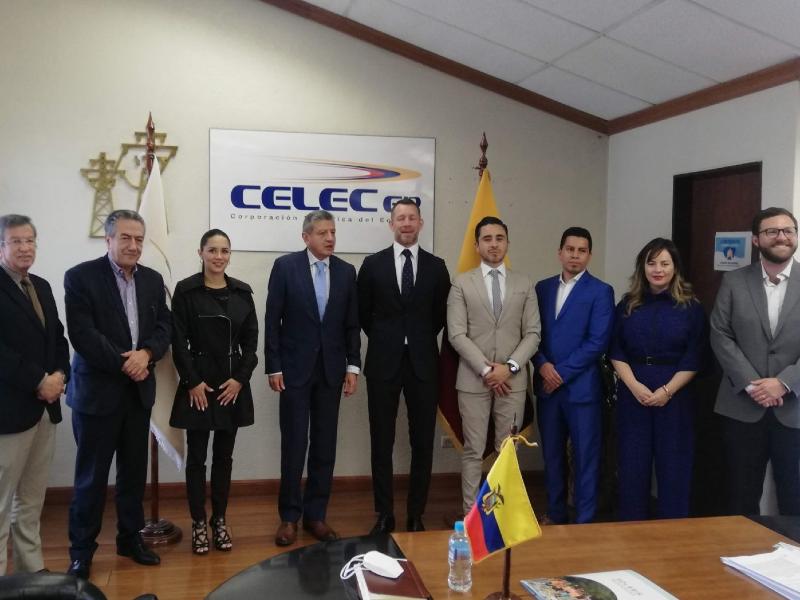

As the world becomes increasingly digitized and reliant on technology, the demand for copper continues to grow. Copper is used in everything from smartphones to power grids, and the mining and production of this valuable metal has a significant environmental impact. However, thanks to recent innovations in mining and production technology, we may be able to meet this growing demand without harming the environment.
Companies engaged in copper exploration are currently leading the charge toward a greener future for the industry. One such company is Rio Tinto, which has been working on developing a new method of extracting copper from ore that doesn’t require smelting. Smelting is a process that releases harmful greenhouse gases into the atmosphere, so eliminating it would be a major step forward in terms of reducing the environmental impact of copper mining.
Another great example is Solaris Resources (TSX:SLS) which has signed a Memorandum of Understanding with Electric Corporation of Ecuador (“CELEC EP”) to supply low-cost, locally sourced hydroelectric power to the Warintza Project (“Warintza” or “the Project”) in southeastern Ecuador.
CELEC EP will source hydroelectric power from the National Transmission System in Ecuador to provide primary power required for the Warintza Project. This initiative is consistent with the “Ecuador Zero Carbon Program” developed by the Ministry of Environment, Water and Ecological Transition and Solaris was the first mining signatory of September 2021.
Solaris wants to make the most of this efficient, renewable, and cheap energy source by investigating how to electrify infrastructure like mobile mining equipment (e.g., drills, trucks), goods transportation (including gravity-assisted solutions), and processing and pumping systems.
Daniel Earle, President & CEO, commented in a press release: “The MOU with CELEC supports our vision to study the potential for electrified operations that maximize the structural benefits of the Warintza Project within an infrastructure-rich mining district with the aim of lowering costs, increasing efficiencies, reducing emissions, and broadly positioning the Project as a leading development opportunity across a range of financial and ESG metrics in the industry.”
Supplying power for the infrastructure and mining activities at Warintza with renewable energy will help to offset the environmental impact of the project, and could set a precedent for other mines in the area.
Other companies have also looked at switching transportation to a net-zero emissions model, in which electric vehicles are powered by renewable energy sources. This would not only reduce emissions from the mining process itself, but also from the transportation of copper ore to processing plants.
Considering copper is one of the key elements powering the transition to renewable energy, it’s encouraging to see the exploration and production industry working hard to reduce its environmental impact. With continued research and development, companies like Solaris Resources are driving the mission toward net-zero forward faster than ever.
The above references an opinion and is for information purposes only. It is not intended to be investment advice. Seek a licensed professional for investment advice. The author is not an insider or shareholder of any of the companies mentioned above.
Solaris Resources (TSX:SLS) has reported new assay results from a series of holes at the Warintza Project in southeastern Ecuador. The holes are aimed at growing the Northeast Extension of the previously announced “Indicative Starter Pit”. The company is moving forward with drilling platforms in the Northeast Extention that are set to drive the latest high-grade results from the project.
Mr. Jorge Fierro, Vice President of Exploration, commented in a press release: “Drilling from existing and recently-completed platforms in the Northeast Extension zone is a key driver in the expansion of the ‘Indicative Starter Pit’, and we look forward to reporting the next set of results in the near future as the backlog of assays pending is now resolved.”
The “Indicative Starter Pit” was noted in an April 18, 2022 announcement from the company in a mineral resource estimate for the Warintza Central Deposit, in which the company reported in-pit resources of 579 Mt at 0.59% CuEq (Ind) and 887 Mt at 0.47% CuEq (Inf), and 180 Mt at 0.82% CuEq (Ind) and 107 Mt at 0.73% CuEq (Inf) for the “Indicative Starter Pit”.
Solaris also intends to spin out its non-core assets in Ecuador outside of the Warintza porphyry cluster, Peru, Chile, and Mexico into a new incorporated wholly-owned subsidiary of Solaris named Solaris Exploration Inc. Following the internal re-organization, it is expected that 100% of the common shares of Solaris Exploration Inc. will be spun out to shareholders of Solaris relative to their shareholdings.
Figure 1 – Plan View of Warintza Central Drilling Released to Date


Highlights from the results are as follows:
Additional drilling has expanded the Northeast Extension of the ‘Indicative Starter Pit’ recently estimated at 180 Mt at 0.82% CuEq¹ (Indicated) and 107 Mt at 0.73% CuEq¹ (Inferred) within the Warintza Mineral Resource Estimate² (“MRE”). This zone is characterized by near surface, high-grade mineralization and remains open for further growth with follow-up drilling underway.
- SLS-66 was collared on a platform at the northeastern limit of the Warintza Central grid and drilled southwest into an open volume, returning 124m of 0.82% CuEq¹ within a broader interval of 622m of 0.42% CuEq¹ starting from surface
- SLS-66 follows from previous holes SLS-63 and SLS-54, which were drilled from the same pad to the north and southeast and respectively returned high-grade intervals of 230m of 1.02% CuEq¹ and 356m of 0.73% CuEq³ within broader intervals (refer to press releases dated Jul 20, 2022 and Apr 4, 2022 for details)
- SLS-64 was collared on a platform at the northern limit of Warintza Central and drilled north-northeast into an open volume, returning 110m of 0.54% CuEq¹ from near surface within a broader interval of 440m of 0.48% CuEq¹, extending and broadening the zone to the north in this area
- SLS-64 follows from previous holes SLS-62 and SLS-48, which were drilled from the same pad to the northeast and south and respectively returned high-grade intervals of 168m of 0.68% CuEq¹ and 100m of 1.64% CuEq³ within broader intervals (refer to press releases dated Jul 20, 2022 and Feb 28, 2022 for details)
- SLS-65, which is a step out hole from a new platform 200m to the north, has now been completed after operational delays with adjustments to the platform for drilling and assays are expected within the next four weeks
Table 1 – Assay Results
| Hole ID | Date Reported | From (m) | To (m) | Interval (m) | Cu (%) | Mo (%) | Au (g/t) | CuEq¹ (%) |
| SLS-66 | Sep 07, 2022 | 0 | 622 | 622 | 0.32 | 0.02 | 0.05 | 0.42 |
| Including | 66 | 190 | 124 | 0.71 | 0.02 | 0.09 | 0.82 | |
| SLS-64 | 78 | 518 | 440 | 0.32 | 0.04 | 0.04 | 0.48 | |
| Including | 78 | 188 | 110 | 0.38 | 0.04 | 0.03 | 0.54 |
Notes to table: True widths of the mineralized zone are not known at this time.
Table 2 – Collar Location
| Hole ID | Easting | Northing | Elevation (m) | Depth (m) | Azimuth (degrees) | Dip (degrees) |
| SLS-66 | 800383 | 9648303 | 1412 | 689 | 255 | -48 |
| SLS-64 | 800178 | 9648285 | 1439 | 571 | 26 | -66 |
Notes to table: The coordinates are in WGS84 17S Datum.
Endnotes
- Copper-equivalence calculated as: CuEq (%) = Cu (%) + 4.0476 × Mo (%) + 0.487 × Au (g/t), utilizing metal prices of US$3.50/lb Cu, US$15.00/lb Mo, and US$1,500/oz Au, and assumes recoveries of 90% Cu, 85% Mo, and 70% Au based on preliminary metallurgical test work.
- Refer to Solaris’ technical report titled, “NI 43-101 Technical Report for the Warintza Project, Ecuador” with an effective date of April 1, 2022, prepared by Mario E. Rossi and filed on the Company’s SEDAR profile at www.sedar.com.
- Copper-equivalence calculated as: CuEq (%) = Cu (%) + 3.33 × Mo (%) + 0.73 × Au (g/t), utilizing metal prices of US$3.00/lb Cu, US$10.00/lb Mo, and US$1,500/oz Au. No adjustments were made for recovery prior to the updated Warintza Mineral Resource Estimate, as the metallurgical data to allow for estimation of recoveries was not yet available. Solaris defined CuEq for reporting purposes only.
The above references an opinion and is for information purposes only. It is not intended to be investment advice. Seek a licensed professional for investment advice. The author is not an insider or shareholder of any of the companies mentioned above.
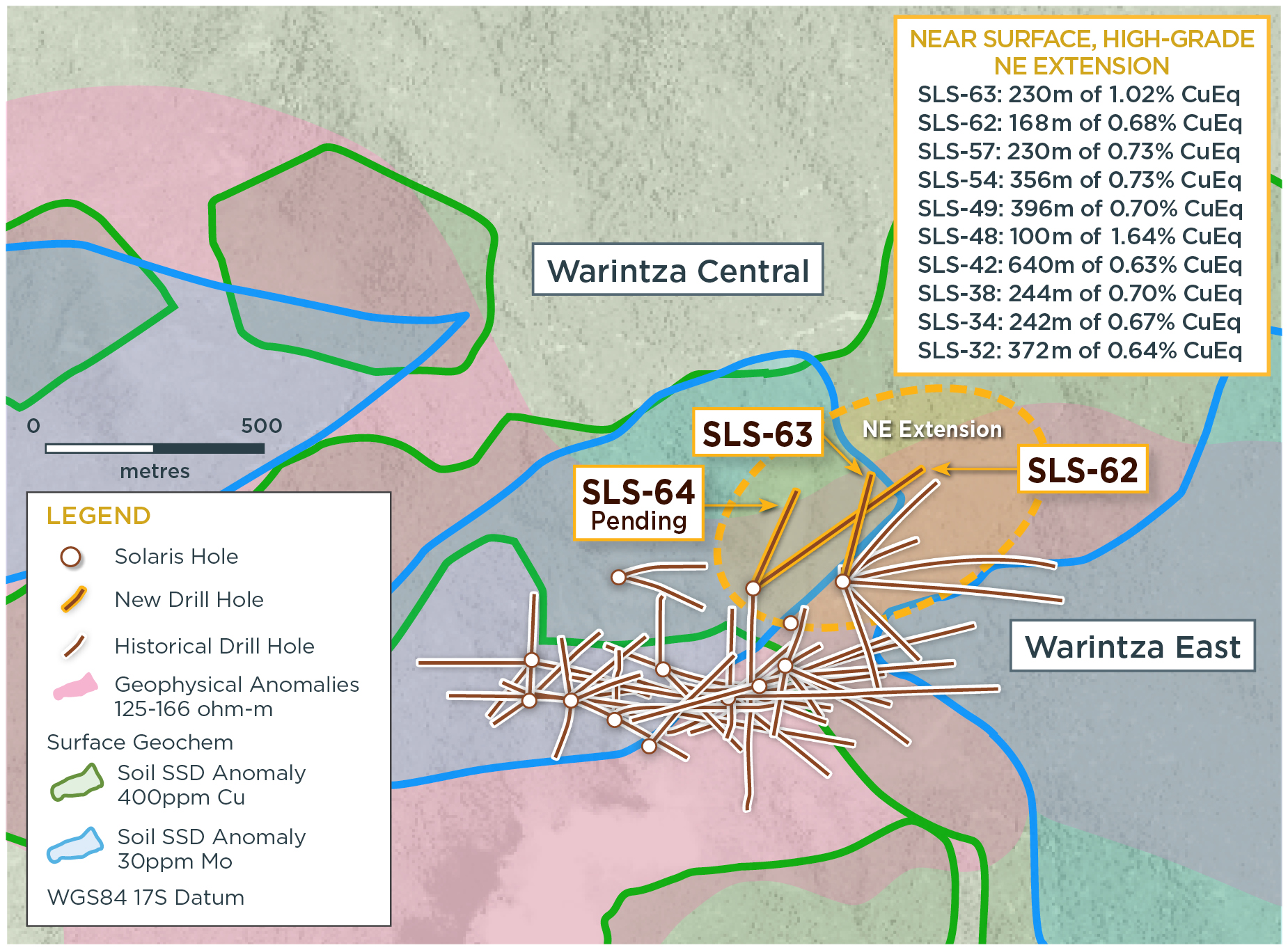

Solaris Resources (TSX:SLS) (OTCQB:SLSSF) has announced this morning new assay results from a series of holes aimed at growing the Northeast Extension of the “Indicative Starter pit” at the Warintza Project. The “Indicative Starter Pit” was noted in an April 18, 2022 announcement from the company in a mineral resource estimate for the Warintza Central Deposit, in which the company reported in-pit resources of 579 Mt at 0.59% CuEq (Ind) and 887 Mt at 0.47% CuEq (Inf), and 180 Mt at 0.82% CuEq (Ind) and 107 Mt at 0.73% CuEq (Inf) for the “Indicative Starter Pit”. The company has been targeting high-grade extensions and major growth in cluster at the project, with ongoing drilling focused on open extensions of near surface, high-grade mineralization to the northeast and southeast of Warintza Central.
Mr. Jorge Fierro, Vice President, Exploration, commented in a press release: “Ongoing drilling from existing and newly constructed platforms aims to expand on the Northeast Extension zone, which is one of the key target areas for the expansion of the ‘Indicative Starter Pit,’ along with higher grade, near surface mineralization being targeted at Warintza East, where results are pending.”
Highlights from the results are as follows:
Additional drilling has expanded the Northeast Extension of the ‘Indicative Starter Pit’ recently estimated at 180 Mt at 0.82% CuEq1 (Indicated) and 107 Mt at 0.73% CuEq1 (Inferred) within the Warintza Mineral Resource Estimate² (“MRE”). This zone is characterized by near surface, high-grade mineralization and remains open for further growth with follow-up and step-out drilling underway.
- SLS-62 was collared at the northern limit of Warintza Central and drilled northeast into an open volume, returning 168m of 0.68% CuEq¹ from 102m depth within a broader interval of 900m of 0.45% CuEq¹ from surface, expanding on prior drilling further to the east
- This hole represents the first follow-up to SLS-48, collared from the same pad but drilled to the south, which returned 100m of 1.64% CuEq³ from 50m depth within a broader interval of 852m of 0.56% CuEq³ (refer to press release dated Feb 28, 2022)
- SLS-63 was collared at the northeastern limit of the Warintza Central grid approximately 200m to the east and drilled into an open volume to the north-northeast, returning 230m of 1.02% CuEq¹ from 118m depth within a broader interval of 472m of 0.76% CuEq¹ from surface
- This hole follows on SLS-57, which was drilled northeast from the same pad, returning 230m of 0.73% CuEq¹ from 56m depth within a broader interval of 926m of 0.61% CuEq¹ from surface and SLS-54, drilled to the south and returning 356m of 0.73% CuEq³ from 50m depth within a broader interval of 1,093m of 0.56% CuEq³ from surface (refer to press releases dated May 26 and Apr 4, 2022)
- Follow-up drilling is underway and aims to test the Northeast Extension zone further to the north and northeast, with assays expected shortly for SLS-64, representing a follow-up hole from the same pad as SLS-62 and SLS-48
Table 1 – Assay Results
| Hole ID | Date Reported | From (m) | To (m) | Interval (m) | Cu (%) | Mo (%) | Au (g/t) | CuEq¹ (%) |
| SLS-63 | Jul 20, 2022 | 0 | 472 | 472 | 0.60 | 0.02 | 0.12 | 0.76 |
| Including | 118 | 348 | 230 | 0.87 | 0.02 | 0.12 | 1.02 | |
| SLS-62 | 10 | 910 | 900 | 0.33 | 0.02 | 0.07 | 0.45 | |
| Including | 102 | 270 | 168 | 0.51 | 0.03 | 0.07 | 0.68 |
Table 2 – Collar Location
| Hole ID | Easting | Northing | Elevation (m) | Depth (m) | Azimuth (degrees) | Dip (degrees) |
| SLS-63 | 800383 | 9648303 | 1412 | 498 | 17 | -61 |
| SLS-62 | 800178 | 9648285 | 1439 | 943 | 55 | -60 |
| Notes to table: The coordinates are in WGS84 17S Datum. | ||||||
Endnotes
- Copper-equivalence calculated as: CuEq (%) = Cu (%) + 4.0476 × Mo (%) + 0.487 × Au (g/t), utilizing metal prices of US$3.50/lb Cu, US$15.00/lb Mo, and US$1,500/oz Au, and assumes recoveries of 90% Cu, 85% Mo, and 70% Au based on preliminary metallurgical test work.
- Refer to Solaris press release dated April 18, 2022, stating updated Warintza Mineral Resource Estimate.
- Copper-equivalence calculated as: CuEq (%) = Cu (%) + 3.33 × Mo (%) + 0.73 × Au (g/t), utilizing metal prices of US$3.00/lb Cu, US$10.00/lb Mo, and US$1,500/oz Au. No adjustments were made for recovery prior to the updated Warintza Mineral Resource Estimate, as the metallurgical data to allow for estimation of recoveries was not yet available. Solaris defined CuEq for reporting purposes only.
Source: Solaris Resources
The above references an opinion and is for information purposes only. It is not intended to be investment advice. Seek a licensed professional for investment advice. The author is not an insider or shareholder of any of the companies mentioned above.
Solaris Resources (TSX:SLS) has provided an update for the Warintza Project in southeastern Ecuador, and announced that it has identified a number of new targets for further exploration in the support of the drill program. The company also provided a report on the progress of the proposed asset spin-out to create Solaris Exploration Inc. Ecuador’s recent protests concluded on June 30, and the company’s samples have now been able to flow from the core processing facility to the prep lab, which has resumed operations. The samples are continuing on for final assays in Lima, Peru, although there is a considerable backlog of assays still pending.
The company is continuing its regional exploration program and identified new porphyry, skarn, and epithermal targets. A large high sulphidation epithermal target was identified adjacent to the Warintza porphyry cluster where overlapping mineralized porphyries have intruded a layered sequence of carbonate and volcanic rocks. This has given the mineralization a very fertile setting to be able to develop.
Solaris also provided an update of the proposed Solaris Exploration spin-out, and when completed, it is expected that 100% of the common shares of Solaris Exploration will be spun out to shareholders of Solaris relative to their current shareholdings. Details of the corporate update are as follows:
Corporate Update on Proposed Solaris Exploration Spin-Out
Solaris continues to advance the proposed spin-out and has made considerable progress with the internal re-organization of the Company, its subsidiaries and mineral concessions including the transfer of its non-core assets held in Ecuador outside of the Warintza porphyry cluster (involving the authorization of the Ministry of Energy and Mines), Peru, Chile and Mexico into a newly incorporated wholly-owned subsidiary of Solaris named Solaris Exploration Inc. Following the internal re-organization, it is expected that 100% of the common shares of Solaris Exploration Inc. will be spun out to shareholders of Solaris relative to their shareholdings (refer to press release dated December 6, 2021).
Source: Solaris Resources
A full update from Warintza and the regional exploration program is as follows:
Warintza Update
Exploration activities at the Warintza Project continue with seven drill rigs targeting high value growth of the recently reported Warintza Mineral Resource Estimate (refer to press release dated April 18, 2022), with drilling at Warintza Central targeting extensions to near surface, high-grade mineralization, and major growth targeted from the expansion of drill coverage at Warintza East within a largely undrilled footprint. With the protests in Ecuador having concluded on June 30, the flow of samples from the Company’s core processing facility to its prep lab, which has now resumed operations, and onward for final assay in Lima has restarted, with a considerable backlog of assays pending.
Regional Exploration Update
Solaris has undertaken the first significant program of regional exploration at Warintza since the original stream sediment sampling program that identified the Warintza porphyry cluster in the 1990s. This work has identified additional porphyry targets (refer to Figure 1), potentially expanding the footprint of the cluster to the northeast, and possibly a new area of porphyry emplacement to the west, approximately halfway to the adjacent San Carlos copper porphyry deposit.
In addition, this work has established a series of skarn targets, as well as a large high sulphidation epithermal target adjacent to the Warintza porphyry cluster where overlapping mineralized porphyries have intruded a layered sequence of carbonate and volcanic rocks that have provided a fertile setting to develop these styles of mineralization.
Porphyry Targets:
- Mateo: 3km x 1.4km area of copper-molybdenum enrichment in soil samples located approximately 5km to the east of Warintza East. A program of detailed mapping and sampling is underway to refine the target in support of drilling.
- Cora: 1.2km x 1.4km copper-molybdenum-gold soil anomaly in andesitic volcanic sequences cut by porphyry dikes approximately 3km to the northeast of Warintza East. This anomaly resembles those that defined the Warintza East and Warintza South discoveries. Detailed mapping and sampling are planned to refine the target in support of drilling.
- Medio Camino: 3.5km x 1.5km area of porphyry-related alteration, and copper-molybdenum veining 5km to the west of Warintza West and 7km east of the adjacent San Carlos copper porphyry deposit. An extensive program of soil and rock chip sampling has been completed to refine the large target area, with results pending.
Skarn Targets:
Five skarn targets have been identified with three of these forming a partial arc on the northeastern side of the Warintza porphyry cluster, which is typical of skarn mineralization related to porphyry systems.
- Playas and Justo: Extensive mineral alteration typical of skarn systems has been identified in an area of copper mineralization concentrated in a permeable horizon 3.5km northwest of Warintza West. Soil sampling of the 10km2 area surrounding the Justo target has been completed in an effort to refine the target, with results pending. Soil sampling is also planned at the Playas target, along with detailed mapping at both targets based on the results of soil sampling.
- Betty and Yawi: Betty, a 1.2km x 1.4km skarn and potential carbonate replacement target located 0.5km north of Warintza Central, features significant copper values in rock samples in carbonate horizons within volcano-sedimentary sequences. Within the Yawi target, a 2km x 1km skarn/carbonate replacement target features strongly anomalous zinc values in limited soil sampling within a high conductivity anomaly interpreted from ZTEM. Additional soil sampling is planned at both targets.
- La Celestina: Marble exposed in streams in this 1.7km x 1.2km area host copper-zinc veinlets that may represent leakage from a mineralized zone below, with soil geochemistry showing enrichment of pathfinder elements and anomalous copper. Two windows of garnet-bearing skarn containing copper mineralization are exposed through the marble. Detailed mapping and sampling of marble and exposed skarn are underway to help define drill targets.
High Sulphidation Epithermal Gold Target
- Caya: Large 5km x 3km gold anomaly in stream sediments, 6km to the northeast of Warintza East, where recent follow-up soil and rock sampling in the southern part of the anomaly has identified a flat-lying volcano-sedimentary layer that has a high permeability over at least 300m in thickness. In this portion of the anomaly, an area of 0.7km x 1.3km features anomalous gold, copper and pathfinder element values in soil and rock samples, and a concentration of dickite clay and vuggy silica, characteristic of high sulphidation systems.
Figure 1 – Regional Map of Solaris Land Package in Ecuador
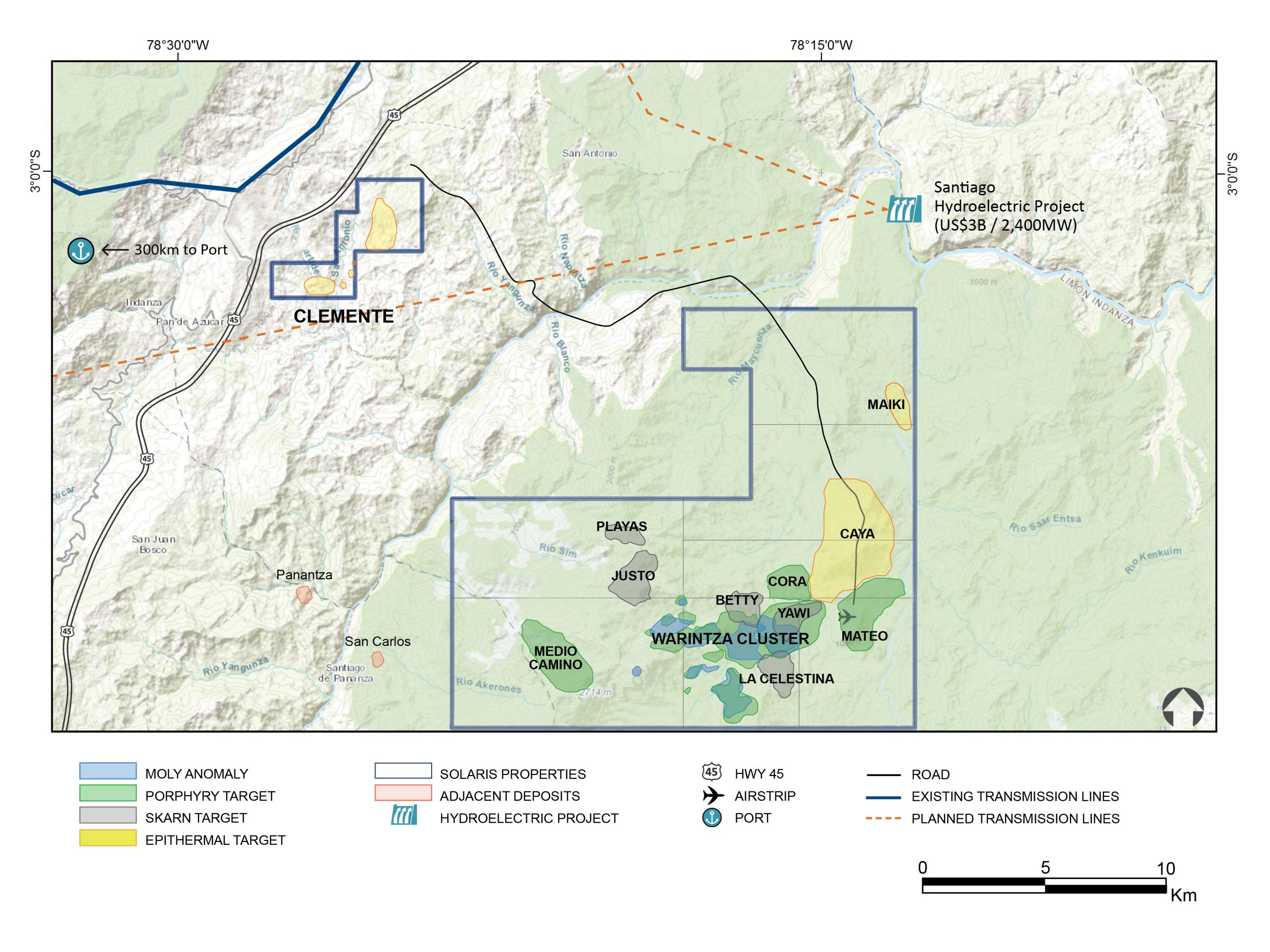

The above references an opinion and is for information purposes only. It is not intended to be investment advice. Seek a licensed professional for investment advice. The author is not an insider or shareholder of any of the companies mentioned above.
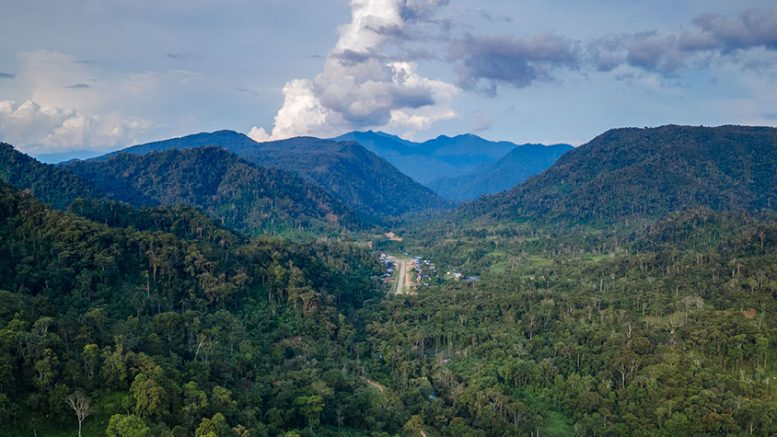

Solaris Resources (TSX:SLS) has announced an agreement with the Government of Ecuador that will secure the stability of its Warintza Project in southeastern Ecuador. The company has signed an Investment Protection Agreement that provides a foundation of certainty for the legal framework governing the Warintza Project. The agreement outlines further affirmation of stable mining regulations, security of title, and investment for the term of the agreement, on top of significant new tax incentives to accelerate development at the project.
Highlights from the agreement:
- The IPA provides a foundation of certainty with respect to the legal framework governing the Project, including stable mining regulations, security of title and investment, and new tax incentives to accelerate development
- 5% reduction of income tax, fixing the income tax rate at 20% (applicable to SLS), exemption from capital outflow tax, and exemption of all import duties for the import of goods needed for new investments
- Specific protections relate to the prohibition of all forms of confiscation, non-discriminatory treatment and equal playing field, legal security, tax stability and international arbitration
- IPA signing ceremony to take place with the Warints and Yawi communities at the Project in July. SLS recently amended its Impact and Benefits Agreement with these communities reaffirming their support for the responsible advancement of Warintza
Ms. Lorena Konanz, Vice Minister of Export and Investment Promotion of the Government of Ecuador, stated, “From day one, our administration has been focused on encouraging sustainable and transparent economic growth in Ecuador with incentives to facilitate major investments in the country. In the mining sector, our most important goal is to ensure that development is responsible, environmentally friendly, and socially-committed, as at the Warintza Project.”
Mr. Vicente Tsakimp, Coordinator of the Warintza Project Strategic Alliance, stated, “We are excited to be part of the successful advancement of Warintza and show the industry that it is possible to develop a mining project in a responsible and inclusive way. The people of Warints and Yawi welcome President Lasso’s approach which promotes the development of remote communities as this has had a direct impact on our families’ economy, living conditions and opportunities.”
Mr. Daniel Earle, President & CEO, commented, “President Lasso´s administration continues to take consequential action to accelerate the development of the formal mining sector in Ecuador. Its positive approach of regulatory reform and meaningful tax relief focused on major new projects like Warintza, which embrace responsible approaches to community development and environmental protection, will pay great dividends to the people of Ecuador for generations to come. We are humbled to operate in service of its vision.”
The agreement will include a 5% income tax reduction, fixing the total income tax rate applicable to Solaris Resources at 20%. There will also be an exemption from the capital outflow tax and all import duties for any import of goods needed for new investments in the Warintza project. The signing ceremony for the agreement will take place with the participation of the Warints and Yawi communities, two important community partners for the Warintza Project and Solaris, in the village of Warintza sometime in July 2022.
The other notable parts of the agreement are the specific protections related to the prohibition of all forms of confiscation, non-discriminatory treatment and equal playing field, legal security, tax stability, and international arbitration if there are any disputes about the Warintza Project. With countries like Peru experiencing upheaval in the mining industry and nationalization of resources and projects in Mexico, Ecuador and the communities of Warints and Yawi have shown that collaborative, collective work is not only possible, but the most beneficial form of business for all stakeholders.
The above references an opinion and is for information purposes only. It is not intended to be investment advice. Seek a licensed professional for investment advice. The author is not an insider or shareholder of any of the companies mentioned above.
Solaris Resources (TSX:SLS) (OTCQB:SLSSF) has reported assay results from a series of holes at the Warintza Project. The drilling at the holes is aimed at upgrading and growing mineral resources at the project, which was recently released.
Mr. Jorge Fierro, Vice President, Exploration, commented in a press release: “Ongoing follow-up drilling from existing and newly constructed platforms aims to expand on the Northeast Extension zone and grow the high-grade indicative starter pit, while also targeting areas within Warintza Central where resource classification can be upgraded with targeted drilling. In addition, we have completed a considerable amount of drilling from our recent Warintza East discovery targeting major growth with assays pending.”
Highlights are listed below, with a corresponding image in Figure 1 and detailed results in Tables 1-2.
Northeast Extension
SLS-57 was collared at the northeastern limit of the Warintza Central grid and drilled northeast into an entirely open volume, returning 230m of 0.73% CuEq¹ from 56m depth within a broader interval of 926m of 0.61% CuEq¹ from surface, extending the zone 200m to the northeast where it remains open.
Additional drilling aimed at expanding the zone to the north from this platform and broadening the zone with holes from the platform located 200m to the west where SLS-48 returned 100m of 1.64% CuEq² from 50m depth within 852m of 0.56% CuEq² have been completed with assays pending.
The Northeast Extension zone is characterized by near surface, high-grade mineralization, and represents a priority target for growth of the ‘Indicative Starter Pit’ recently estimated at 180 Mt at 0.82% CuEq1 (Indicated) and 107 Mt at 0.73% CuEq1 (Inferred) within the Warintza Mineral Resource Estimate³ (“MRE”).
Warintza Central
A limited program of follow-up drilling at Warintza Central within the MRE envelope is aimed at upgrading targeted volumes that the geological model predicts hold potential for higher grades than the MRE reflects, as well as increasing the confidence of mineral resources in the Inferred category.
SLS-56 was collared from the southeastern portion of the grid and drilled east, returning 102m of 0.90% CuEq¹ from 48m depth within a broader interval aimed at adding definition to the southern portion of the overlap between the Warintza Central and Warintza East deposits.
SLS-60 was collared from the central portion of the grid and drilled south, returning 154m of 0.90% CuEq¹ from 70m depth within a broader interval of 829m of 0.58% CuEq¹ from 44m depth.
SLS-61 was collared from the south-central portion of the grid and drilled southwest, returning 930m of 0.77% CuEq¹ from surface, successfully infilling data in this area.
SLS-58 was collared from the south-central portion of the grid and drilled northeast into an area that the exploration model predicted could be upgraded, and successfully returned 741m of 0.62% CuEq¹ from 102m depth, improving on the grade modelled in this volume.
SLS-59 was collared from the southwestern portion of the grid and drilled northeast, returning 238m of 0.85% CuEq¹ from near surface within a broader interval of 511m of 0.73% CuEq¹ from surface.
Figure 1 – Plan View of Warintza Central Drilling Released to Date


Table 1 – Assay Results
| Hole ID | Date Reported | From (m) | To (m) | Interval (m) | Cu (%) | Mo (%) | Au (g/t) | CuEq¹ (%) |
| SLS-61 | May 26, 2022 | 2 | 932 | 930 | 0.62 | 0.03 | 0.07 | 0.77 |
| SLS-60 | 44 | 873 | 829 | 0.50 | 0.01 | 0.04 | 0.58 | |
| Including | 70 | 224 | 154 | 0.81 | 0.02 | 0.05 | 0.90 | |
| SLS-59 | 2 | 513 | 511 | 0.54 | 0.04 | 0.07 | 0.73 | |
| Including | 34 | 272 | 238 | 0.67 | 0.03 | 0.08 | 0.85 | |
| SLS-58 | 102 | 843 | 741 | 0.48 | 0.03 | 0.06 | 0.62 | |
| SLS-57 | 0 | 926 | 926 | 0.49 | 0.02 | 0.08 | 0.61 | |
| Including | 56 | 286 | 230 | 0.59 | 0.03 | 0.08 | 0.73 | |
| SLS-56 | 48 | 606 | 558 | 0.33 | 0.01 | 0.03 | 0.38 | |
| Including | 48 | 150 | 102 | 0.80 | 0.02 | 0.04 | 0.90 |
Table 2 – Collar Location
| Hole ID | Easting | Northing | Elevation (m) | Depth (m) | Azimuth (degrees) | Dip (degrees) |
| SLS-61 | 800191 | 9648065 | 1573 | 967 | 255 | -72 |
| SLS-60 | 800258 | 9648097 | 1559 | 873 | 190 | -80 |
| SLS-59 | 799765 | 9648033 | 1571 | 513 | 65 | -70 |
| SLS-58 | 799942 | 9647932 | 1643 | 843 | 40 | -70 |
| SLS-57 | 800383 | 9648303 | 1412 | 964 | 40 | -71 |
| SLS-56 | 800126 | 9648032 | 1566 | 920 | 88 | -50 |
| Notes to table: The coordinates are in WGS84 17S Datum. | ||||||
Endnotes
- Copper-equivalence calculated as: CuEq (%) = Cu (%) + 4.0476 × Mo (%) + 0.487 × Au (g/t), utilizing metal prices of US$3.50/lb Cu, US$15.00/lb Mo, and US$1,500/oz Au, and assumes recoveries of 90% Cu, 85% Mo, and 70% Au based on preliminary metallurgical test work.
- Refer to press release dated February 28, 2022. Copper-equivalence calculated as: CuEq (%) = Cu (%) + 3.33 × Mo (%) + 0.73 × Au (g/t), utilizing metal prices of US$3.00/lb Cu, US$10.00/lb Mo, and US$1,500/oz Au. No adjustments were made for recovery prior to the updated Warintza Mineral Resource Estimate, as the metallurgical data to allow for estimation of recoveries was not yet available. Solaris defined CuEq for reporting purposes only.
- Refer to Solaris press release dated April 18, 2022, stating updated Warintza Mineral Resource Estimate.
Source: Solaris Resources
The above references an opinion and is for information purposes only. It is not intended to be investment advice. Seek a licensed professional for investment advice. The author is not an insider or shareholder of any of the companies mentioned above.
Solaris Resources (TSX:SLS) has had the highest insider buying for its industry group, leading all issuers in the TSX materials sector, and that rate continues to climb. The company has announced that it received about C$30.4 million from the exercise of common share purchase warrants. The company is now fully funded through to mid-2023 for its drill program at the Warintza Project in Ecuador.
Mr. Daniel Earle, President & CEO, commented in a press release: “With last year’s intensive resource drilling program at Warintza Central having established a voluminous mineral resource estimate and robust starter pit, we are now directing our efforts to immediate high-impact drilling aimed at expanding the starter pit in open extensions of near surface, high-grade mineralization at Warintza Central, expanding the minimally-drilled Warintza East discovery, and testing the potential of the nearby Warintza West discovery.”
The total insider buying has now crossed $170 million dollars in the past 24 months, as a portion of the warrants has been exercised by Solaris management. Executive Chairman Richard Warke is the main shareholder exercising the most warrants. In the second half of 2022 and the first half of 2023, more warrant expires will occur. Should holders choose to exercise all of them, the company would bring in another C$54.1 million, with approximately 63% of the still outstanding warrants held by management.
A recent mineral resource update for Warintza Central showed in-pit resources of 579 Mt at 0.59% CuEq (Ind) and 887 Mt at 0.47% CuEq (Inf). This also includes an ‘indicative starter pit’ of 180 Mt at 0.82% CuEq (Ind) & 107 Mt at 0.73% CuEq (Inf). Additionally, the company is now targeting high-grade extensions and major growth in cluster. Warintza East and Warintza West will now become the focus for the company as it advances its flagship project.
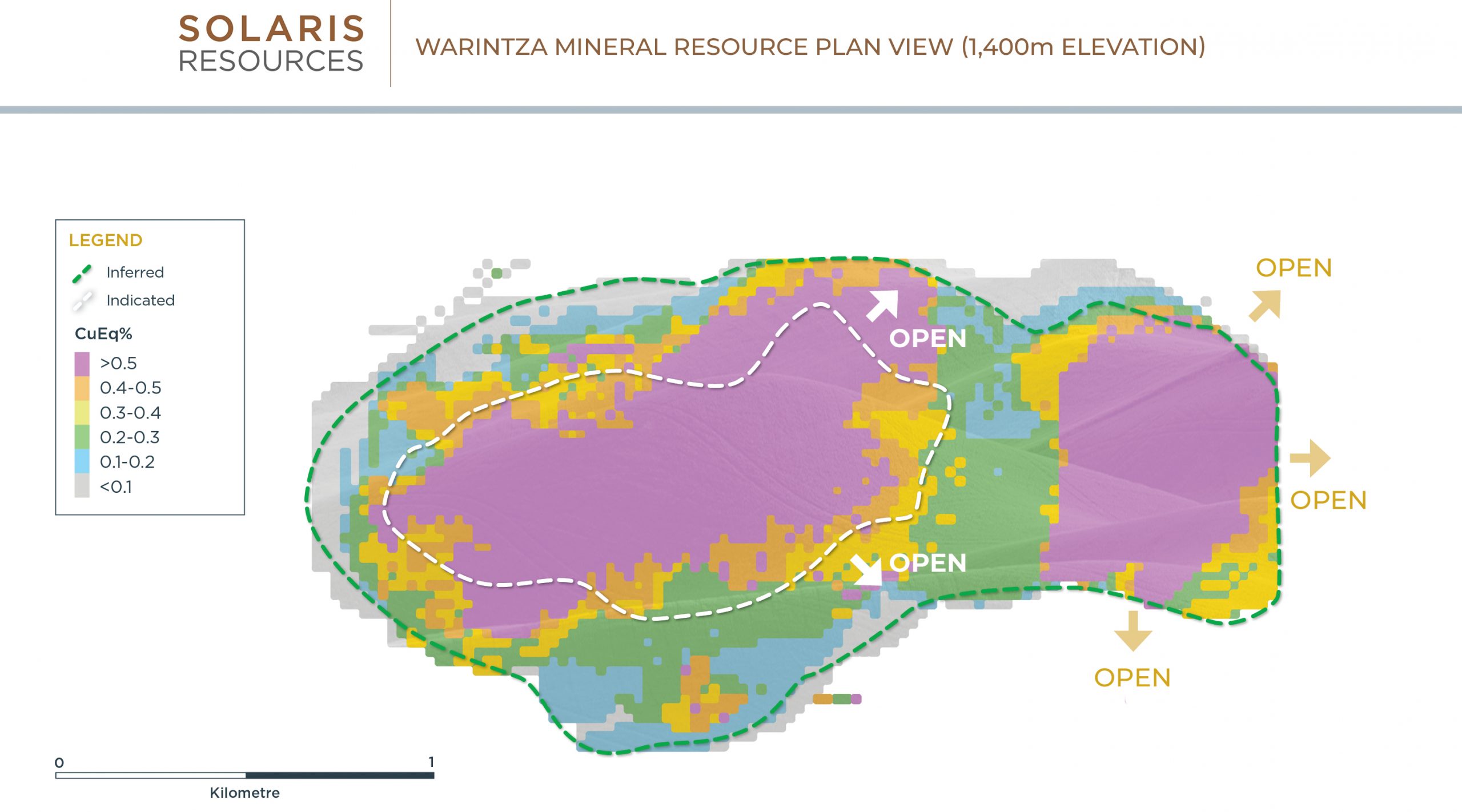

Highlights from the Warintza Central mineral resource update are as follows:
- In-Pit Indicated mineral resources of 579 million tonnes (“Mt”) at 0.59% copper equivalent¹ (“CuEq”) and Inferred mineral resources of 887 Mt at 0.47% CuEq¹ above a 0.3% CuEq cut-off grade
- Includes ‘Indicative Starter Pit’ comprised of Indicated mineral resources of 180 Mt at 0.82% CuEq² and Inferred mineral resources of 107 Mt at 0.73% CuEq² above 0.6% CuEq cut-off grade
- High Quality – Expected low strip ratio ‘Indicative Starter Pit’ and ultimate pit, zoned from high-grade at surface to low grade at depth, consistent, clean sulphide mineralogy free of deleterious elements
- High-Grade Growth – Ongoing drilling focused on open extensions of near surface, high-grade mineralization to the northeast and southeast of Warintza Central
- ‘Super Pit’ Growth – Warintza Central pit shell includes overlapping portion of Warintza East, discovered mid-2021, a target wide open for major growth potential within a shared pit
- Cluster Potential – Warintza Central forms part of a 7km x 5km cluster of porphyry deposits, where in addition to East, recent discoveries at West and South offer major growth potential
- Structural Advantages – Set within mining district featuring access to highway, abundant and low-cost hydroelectric power, fresh water, labour and low elevation
Source: Solaris Resources
The above references an opinion and is for information purposes only. It is not intended to be investment advice. Seek a licensed professional for investment advice. The author is not an insider or shareholder of any of the companies mentioned above.
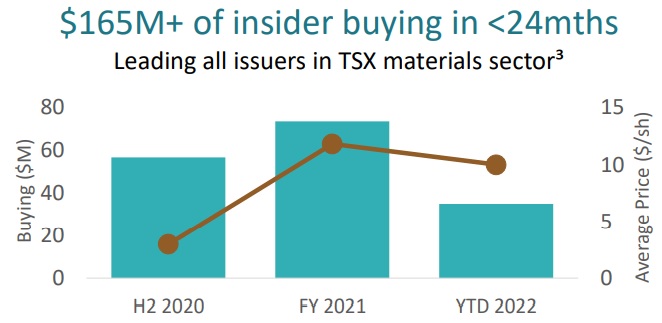

Insider buying at Solaris Resources (TSX:SLS) continues to show a large amount of stock being purchased throughout the last two years. On April 20, 2022, Richard Warke, Executive Chairman, bought C$35 million of Solaris stock through the exercise of 3,500,000 warrants. Warrants were set at $10 to buy 5 million shares of Solaris Resources from Equinox Gold. The warrants would have expired on April 26th, 2022.
Christian Milau, CEO of Equinox Gold, stated: “As a strategic and supportive shareholder, Equinox Gold is pleased to accommodate Solaris in this transaction, which benefits both companies. The proceeds from this sale will further strengthen Equinox Gold’s already solid balance sheet as we continue to execute on our expansion and growth objectives.”
A recent mineral resource update and the ongoing success of the drill program at Warintza may have insiders optimistic about the future of the company since they have been net buyers of shares since the IPO. The total insider shareholding of any given company gives investors an overall view of whether management and other inside investors are aligned with other shareholders.


Sunny Lowe, CFO of Solaris Resources (TSX:SLS), also purchased approximately C$100K in Solaris shares on the open market on Monday, April 25th, 2022. Total insider investment has reached over C$165 million in less than 24 months now, demonstrating a significant amount of confidence in the company by those in charge of its success. In the TSX materials sector, this places Solaris Resources (TSX:SLS) in the lead for insider buying. The company has seen strong interest in the stock since its IPO, up nearly 700%.
The above references an opinion and is for information purposes only. It is not intended to be investment advice. Seek a licensed professional for investment advice. The author is not an insider or shareholder of any of the companies mentioned above.
Solaris Resources (TSX:SLS) (OTC:SLSSF) has announced a highly-anticipated mineral resource update to Warintza Central at the Warintza Project in Ecuador. The company reported in-pit resources of 579 Mt at 0.59% CuEq (Ind) & 887 Mt at 0.47% CuEq (Inf). This also includes an ‘indicative starter pit’ of 180 Mt at 0.82% CuEq (Ind) & 107 Mt at 0.73% CuEq (Inf). Additionally, the company is now targeting high-grade extensions and major growth in cluster.
Daniel Earle, President & CEO of Solaris Resources, commented in a press release: “After only eighteen months of drilling, primarily in Warintza Central, one of the four major discoveries made on the property to date, the MRE establishes baseline credentials for the Project of hosting a robust inventory, featuring a high-grade indicative starter pit and low strip ratio, within a mining district offering major structural advantages from highway access, abundant and low-cost hydroelectric power, fresh water, labour and low elevation. Ongoing drilling is targeting further rapid growth, with an emphasis on the open extensions of near surface, high-grade mineralization at Warintza Central and expanding our recent Warintza East discovery to include it within a shared pit, while testing the further potential within the cluster.”
Highlights from the mineral resource update are as follows:
Highlights
- In-Pit Indicated mineral resources of 579 million tonnes (“Mt”) at 0.59% copper equivalent¹ (“CuEq”) and Inferred mineral resources of 887 Mt at 0.47% CuEq¹ above a 0.3% CuEq cut-off grade
- Includes ‘Indicative Starter Pit’ comprised of Indicated mineral resources of 180 Mt at 0.82% CuEq² and Inferred mineral resources of 107 Mt at 0.73% CuEq² above 0.6% CuEq cut-off grade
- High Quality – Expected low strip ratio ‘Indicative Starter Pit’ and ultimate pit, zoned from high-grade at surface to low grade at depth, consistent, clean sulphide mineralogy free of deleterious elements
- High-Grade Growth – Ongoing drilling focused on open extensions of near surface, high-grade mineralization to the northeast and southeast of Warintza Central
- ‘Super Pit’ Growth – Warintza Central pit shell includes overlapping portion of Warintza East, discovered mid-2021, a target wide open for major growth potential within a shared pit
- Cluster Potential – Warintza Central forms part of a 7km x 5km cluster of porphyry deposits, where in addition to East, recent discoveries at West and South offer major growth potential
- Structural Advantages – Set within mining district featuring access to highway, abundant and low-cost hydroelectric power, fresh water, labour and low elevation
Table 1: Warintza Mineral Resource Estimate Summary and Cut-Off Grade Sensitivity
| Cut-off | Category | Tonnage | Grade | Contained Metal | |||||||
| CuEq (%) |
(Mt) | CuEq (%) |
Cu (%) |
Mo (%) |
Au (g/t) |
CuEq (Mt) |
Cu (Mt) |
Mo (Mt) |
Au (Moz) |
||
| 0.2 | % | Indicated | 736 | 0.52 | 0.40 | 0.02 | 0.05 | 3.84 | 2.95 | 0.18 | 1.11 |
| Inferred | 1,558 | 0.37 | 0.31 | 0.01 | 0.03 | 5.80 | 4.80 | 0.19 | 1.63 | ||
| 0.3% (Base) | Indicated | 579 | 0.59 | 0.47 | 0.03 | 0.05 | 3.45 | 2.70 | 0.15 | 0.93 | |
| Inferred | 887 | 0.47 | 0.39 | 0.01 | 0.04 | 4.17 | 3.48 | 0.13 | 1.08 | ||
| 0.4 | % | Indicated | 442 | 0.67 | 0.54 | 0.03 | 0.05 | 2.97 | 2.38 | 0.12 | 0.77 |
| Inferred | 539 | 0.55 | 0.47 | 0.01 | 0.04 | 2.96 | 2.53 | 0.08 | 0.71 | ||
| ‘Indicative Starter Pit’ | |||||||||||
| 0.6 | % | Indicated | 180 | 0.82 | 0.67 | 0.03 | 0.07 | 1.49 | 1.20 | 0.06 | 0.38 |
| Inferred | 107 | 0.73 | 0.64 | 0.02 | 0.05 | 0.79 | 0.69 | 0.02 | 0.17 | ||
Notes to Table 1:
- The mineral resource estimates are reported in accordance with the CIM Definition Standards for Mineral Resources & Mineral Reserves, adopted by CIM Council May 10, 2014.
- Reasonable prospects for eventual economic extraction assume open-pit mining with conventional flotation processing and were tested using NPV Scheduler™ pit optimization software with the following assumptions: metal prices of US$3.50/lb Cu, US$15.00/lb Mo, and US$1,500/oz Au; operating costs of US$1.50/t + US$0.02/t per bench for mining, US$4.50/t milling, US$0.90/t G&A; recoveries of 90% Cu, 85% Mo, and 70% Au.
- Resource includes grade capping and internal dilution. Grade was interpolated by ordinary kriging populating a block model with block dimensions of 25m x 25m x 15m.
- The ‘Indicative Starter Pit’ is based on the same assumptions as the Resource except utilized metal prices of US$1.00/lb Cu, US$7.50/lb Mo, and US$750/oz Au. No economic analysis has been completed by the Company and there is no guarantee than an ‘Indicative Starter Pit’ will be realized or prove to be economic.
- Mineral resources that are not mineral reserves do not have demonstrated economic viability.
- Copper equivalent assumes recoveries of 90% Cu, 85% Mo, and 70% Au based on preliminary metallurgical testwork, and metal prices of US$3.50/lb Cu, US$15.00/lb Mo, and US$1,500/oz Au. CuEq formula: CuEq (%) = Cu (%) + 4.0476 × Mo (%) + 0.487 × Au (g/t).
- The Qualified Person is Mario E. Rossi, FAusIMM,RM-SME, Principal Geostatistician of Geosystems International Inc.
- All figures are rounded to reflect the relative accuracy of the estimate.
- The effective date of the mineral resource estimate is April 1, 2022.
The corresponding Technical Report disclosing the MRE in accordance with National Instrument 43-101 – Standards of Disclosure for Mineral Projects (“NI 43-101”) will be prepared by Mr. Rossi and available on SEDAR under the Company’s profile at www.sedar.com within 45 days of this news release.
- Copper equivalent assumes recoveries of 90% Cu, 85% Mo, and 70% Au based on preliminary metallurgical testwork, and metal prices of US$3.50/lb Cu, US$15.00/lb Mo, and US$1,500/oz Au. CuEq formula: CuEq (%) = Cu (%) + 4.0476 × Mo (%) + 0.487 × Au (g/t).
- The Company anticipates that a near surface, high grade portion of the Resource may form the basis of an ‘Indicative Starter Pit’ once an economic analysis of the Project is complete. No economic analysis has been completed by the Company and there is no guarantee an ‘Indicative Starter Pit’ will be realized or prove to be economic. The ‘Indicative Starter Pit’ is based on the same assumptions as the Resource except utilized metal prices of US$1.00/lb Cu, US$7.50/lb Mo, and US$750/oz Au.
Resource Estimation Methodology and Parameters
Indicated mineral resources were defined where the nominal drill hole spacing is 120m. The classification reflects not only the drill spacing, but the confidence level in the continuity of the grade and the geometry of the deposit. Inferred mineral resources were defined by blocks which were estimated with less stringent requirements within search ellipses defined for each domain to a maximum distance of 350m. Resources include grade capping and internal dilution. Grade was interpolated by ordinary kriging populating a block model with block dimensions of 25m x 25m x 15m. The Indicated and Inferred mineral resources are classified in a manner that is consistent with the May 10, 2014 CIM Definition Standards for Mineral Resources and Mineral Reserves. Mineral resources that are not mineral reserves do not have demonstrated economic viability. In Mr. Rossi’s opinion, there are currently no relevant factors or legal, political, environmental, or other risks that could materially affect the potential development of the mineral resources.
Source: Solaris Resources
Figure 1 – Warintza Mineral Resource Plan View (1,400m Elevation)
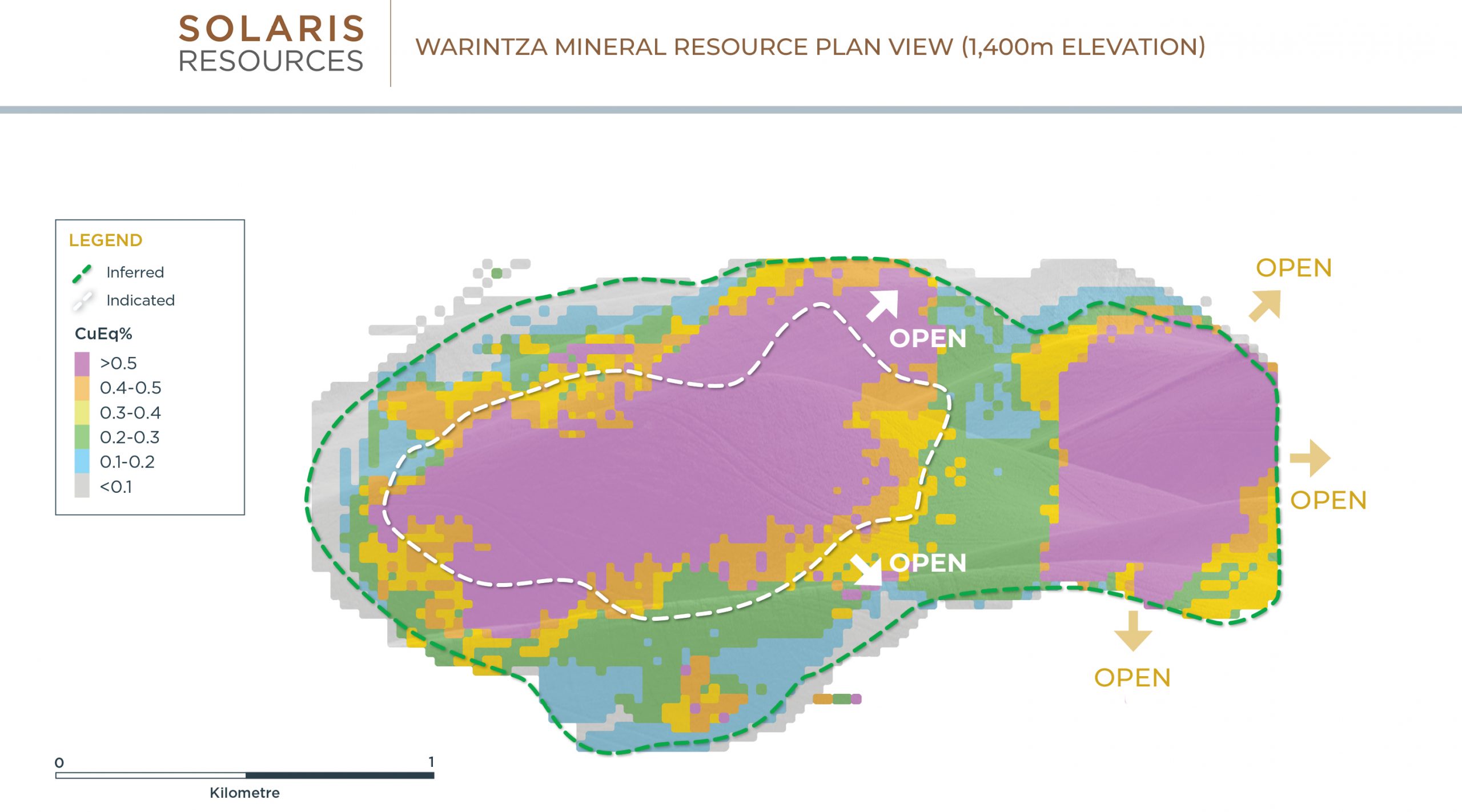

Figure 2 – Warintza Mineral Resource Long Section
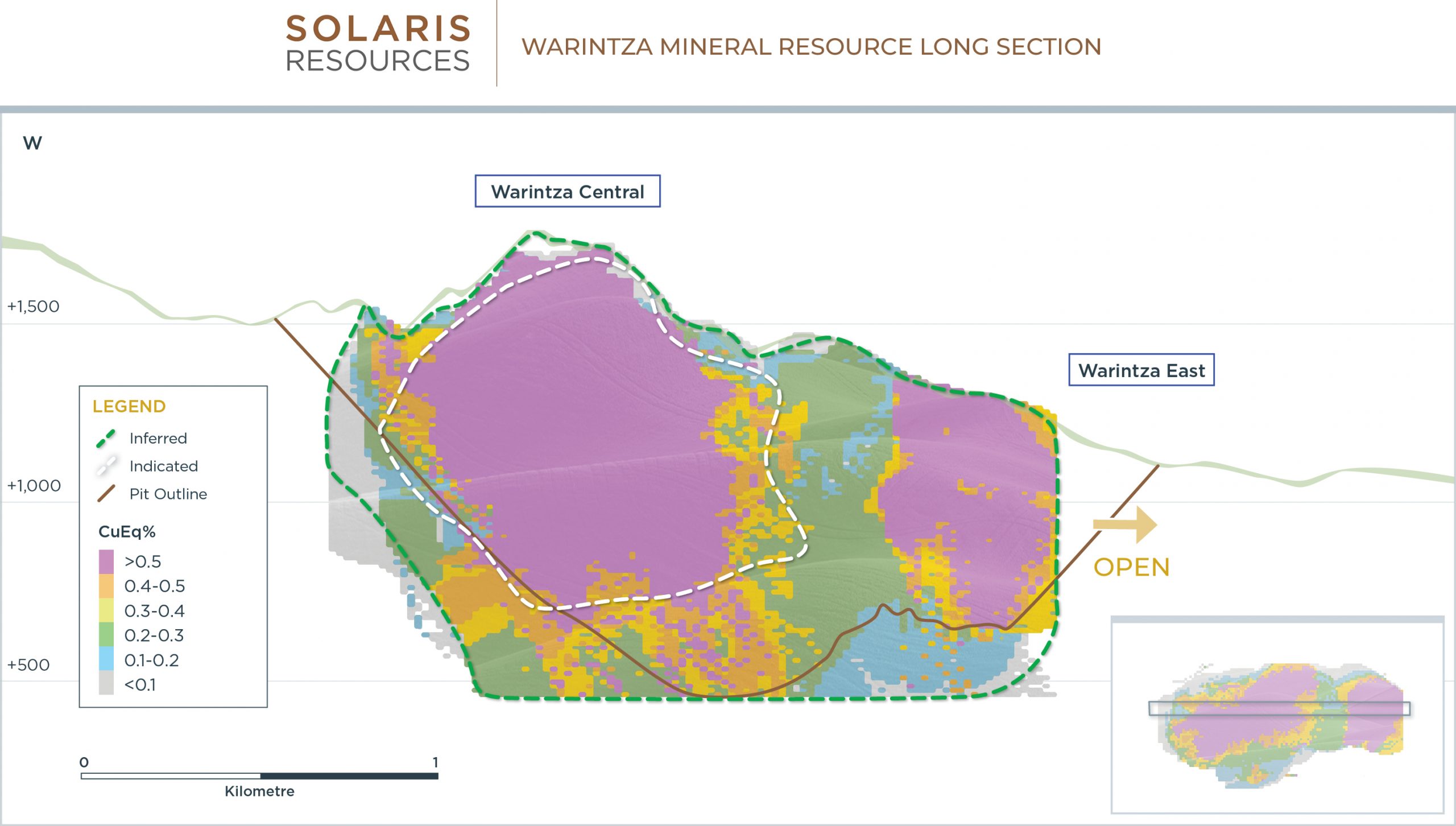

Figure 3 – Warintza Mineral Resource Cross Section
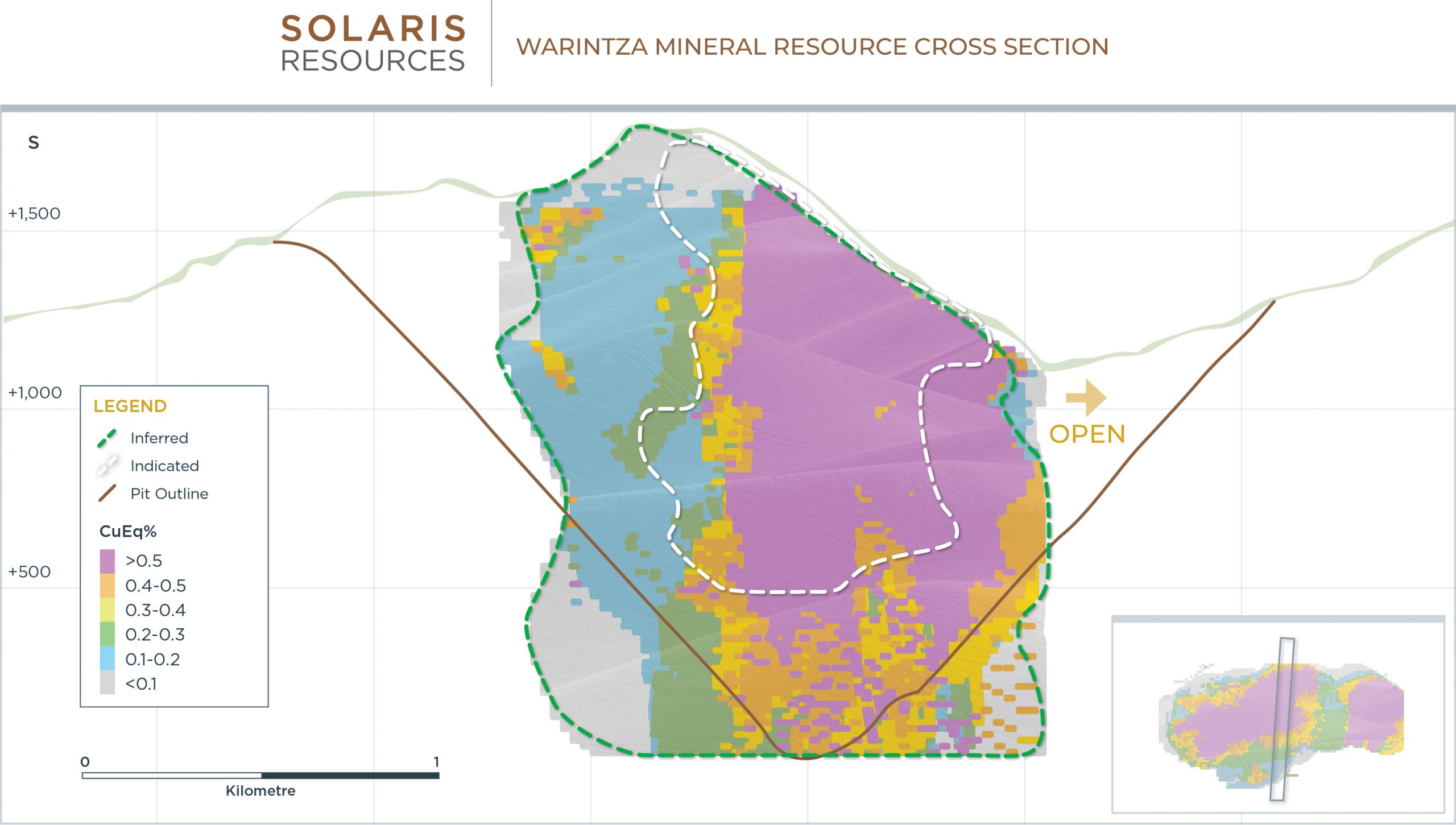

The above references an opinion and is for information purposes only. It is not intended to be investment advice. Seek a licensed professional for investment advice. The author is not an insider or shareholder of any of the companies mentioned above.
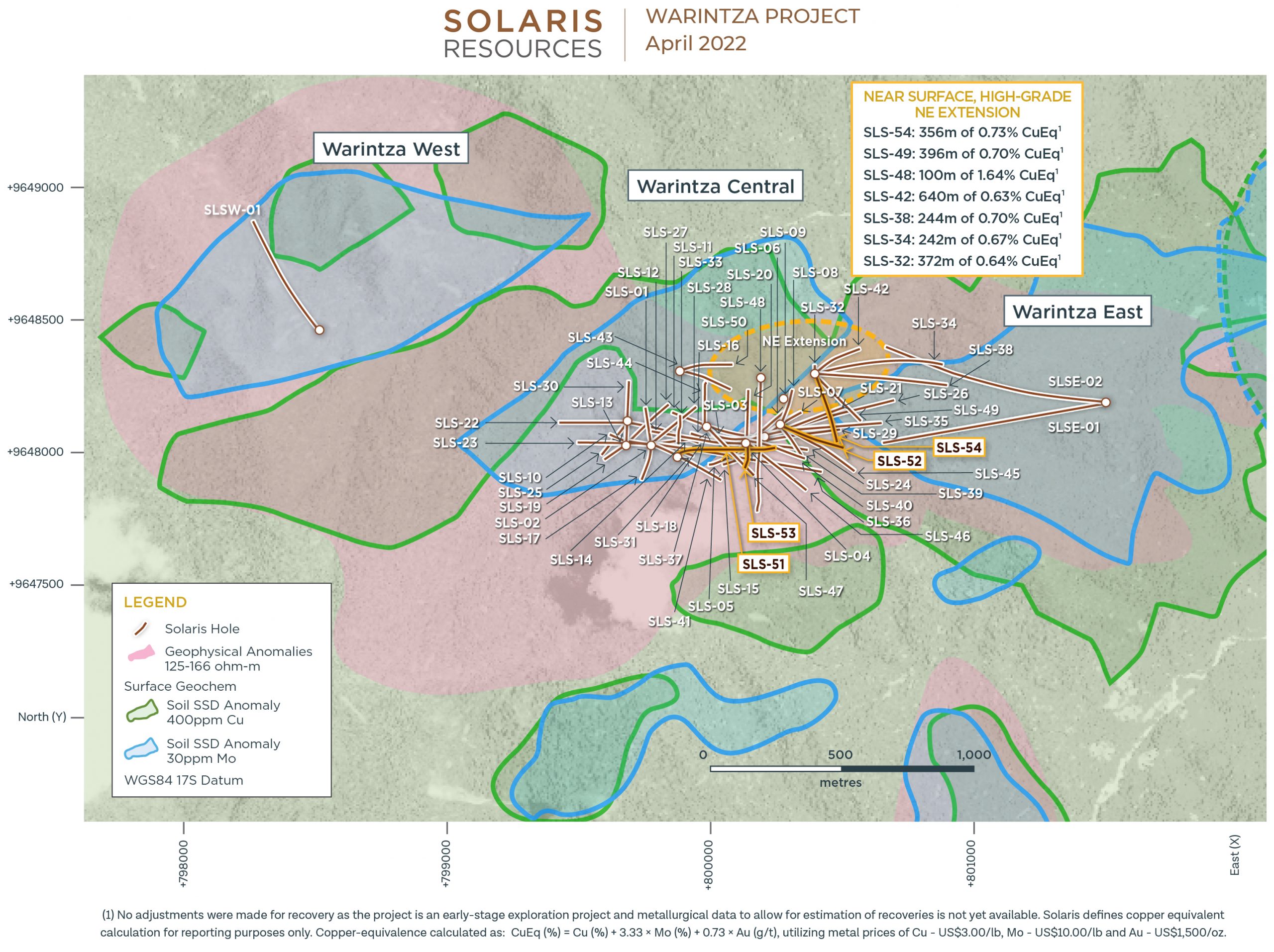


Solaris Resources (TSX:SLS) (OTC:SLSSF) has reported assay results from additional holes at Warintza Project as part of its mineral resources growth drilling. The company also recently added to near-surface, high-grade northeast and southeast extension. Solaris has said that the extension to the northeast and southeast are not priority targets and therefore will be targeted for further growth through step-out drilling.
Highlights from drilling are as follows:
Key Takeaways
Since the discovery of Warintza East in mid-2021, approximately 1km east of Warintza Central, limited drilling has been completed on the open area between the two deposits that would fall into the eastern sector of the conceptual pit design for Warintza Central as uncategorized waste – these results now establish continuity of mineralization between the two deposits with Warintza East remaining entirely open and undrilled to the north, south and east for future potential growth
- SLSE-06 was collared from the original platform in the middle of Warintza East and drilled west-northwest into an entirely open volume, returning 484m of 0.42% CuEq¹ from surface
- SLSE-08 was collared from the same platform and drilled northwest into an open volume, returning 142m of 0.65% CuEq¹ from near surface within a broader interval of 536m of 0.43% CuEq¹ from surface
- SLSE-04 was collared between Warintza Central and Warintza East and drilled west-southwest into a partially open volume, returning 616m of 0.63% CuEq¹ from 276m depth within a broader interval of 892m of 0.50% CuEq¹ from surface, establishing the overlap of the two deposits within the Warintza Central pit shell
- SLSE-03 was collared from the same platform and drilled west-northwest into a partially open volume, returning 326m of 0.62% CuEq¹ from 276m depth within a broader interval of 818m of 0.38% CuEq¹ from 38m depth, further confirming the overlap of the two deposits
- SLSE-05, collared from the same platform, was drilled north-northwest into a partially open area, returning 268m of 0.53% CuEq¹ from 446m depth within a broader interval of 714m of 0.32% CuEq¹ from surface
Updated Warintza Central Mineral Resource Estimate expected to be issued in April
To date, 62 holes have been completed at Warintza Central with assays reported for 54 of these and 8 holes have been completed at Warintza East with results reported for all holes
Mr. Jorge Fierro, Vice President, Exploration, commented: “Following the final Warintza Central results released April 4, these results represent the final holes from Warintza East to be included in the forthcoming mineral resource update, and serve to convert what would otherwise be uncategorized waste within the expected pit shell in the area where Warintza Central and Warintza East overlap.”
Table 1 – Assay Results
| Hole ID | Date Reported | From (m) | To (m) | Interval (m) | Cu (%) | Mo (%) | Au (g/t) | CuEq¹ (%) | ||
| SLSE-08 | Apr 11, 2022 | 8 | 544 | 536 | 0.35 | 0.02 | 0.04 | 0.43 | ||
| Including | 18 | 160 | 142 | 0.56 | 0.01 | 0.06 | 0.65 | |||
| SLSE-07 | 632 | 1069 | 437 | 0.29 | 0.02 | 0.04 | 0.37 | |||
| SLSE-06 | 0 | 484 | 484 | 0.33 | 0.02 | 0.04 | 0.42 | |||
| SLSE-05 | 0 | 714 | 714 | 0.26 | 0.01 | 0.05 | 0.32 | |||
| Including | 446 | 714 | 268 | 0.42 | 0.02 | 0.08 | 0.53 | |||
| SLSE-04 | 0 | 892 | 892 | 0.43 | 0.01 | 0.04 | 0.50 | |||
| Including | 276 | 892 | 616 | 0.54 | 0.02 | 0.04 | 0.63 | |||
| SLSE-03 | 38 | 856 | 818 | 0.29 | 0.02 | 0.03 | 0.38 | |||
| Including | 276 | 602 | 326 | 0.48 | 0.03 | 0.05 | 0.62 | |||
| SLS-54 | Apr 4, 2022 | 0 | 1093 | 1093 | 0.45 | 0.02 | 0.04 | 0.56 | ||
| Including | 50 | 406 | 356 | 0.62 | 0.02 | 0.05 | 0.73 | |||
| SLS-53 | 10 | 967 | 957 | 0.39 | 0.01 | 0.03 | 0.46 | |||
| Including | 16 | 192 | 176 | 0.65 | 0.03 | 0.04 | 0.78 | |||
| SLS-52 | 42 | 1019 | 977 | 0.39 | 0.01 | 0.03 | 0.45 | |||
| Including | 96 | 578 | 482 | 0.55 | 0.01 | 0.03 | 0.62 | |||
| SLS-51 | 36 | 1048 | 1012 | 0.38 | 0.01 | 0.06 | 0.47 | |||
| Including | 130 | 1048 | 918 | 0.41 | 0.01 | 0.05 | 0.50 | |||
| SLS-50 | 336 | 458 | 122 | 0.14 | 0.04 | 0.03 | 0.30 | |||
| SLS-49 | Feb 28, 2022 | 50 | 867 | 817 | 0.50 | 0.02 | 0.04 | 0.60 | ||
| SLS-48 | 50 | 902 | 852 | 0.45 | 0.02 | 0.05 | 0.56 | |||
| SLS-47 | 48 | 859 | 811 | 0.41 | 0.02 | 0.05 | 0.51 | |||
| SLS-46 | 48 | 680 | 632 | 0.27 | 0.01 | 0.03 | 0.31 | |||
| SLS-45 | 44 | 608 | 564 | 0.37 | 0.01 | 0.03 | 0.41 | |||
| SLS-44 | 6 | 524 | 518 | 0.16 | 0.05 | 0.03 | 0.35 | |||
| SLS-43 | 138 | 350 | 212 | 0.17 | 0.03 | 0.03 | 0.30 | |||
| SLS-42 | 52 | 958 | 906 | 0.42 | 0.02 | 0.06 | 0.53 | |||
| SLSS-01 | Jan 18, 2022 | 0 | 755 | 755 | 0.28 | 0.02 | 0.02 | 0.36 | ||
| SLS-41 | Dec 14, 2021 | 0 | 592 | 592 | 0.42 | 0.02 | 0.06 | 0.52 | ||
| SLS-40 | 8 | 1056 | 1048 | 0.39 | 0.01 | 0.03 | 0.46 | |||
| SLS-39 | 28 | 943 | 915 | 0.49 | 0.01 | 0.04 | 0.56 | |||
| SLS-38 | 58 | 880 | 822 | 0.28 | 0.01 | 0.05 | 0.35 | |||
| SLS-37 | 28 | 896 | 868 | 0.39 | 0.05 | 0.05 | 0.58 | |||
| SLS-36 | Nov 15, 2021 | 2 | 1082 | 1080 | 0.33 | 0.01 | 0.04 | 0.41 | ||
| SLS-35 | 48 | 968 | 920 | 0.53 | 0.02 | 0.04 | 0.62 | |||
| SLS-34 | Oct 25, 2021 | 52 | 712 | 660 | 0.36 | 0.02 | 0.06 | 0.47 | ||
| SLS-33 | 40 | 762 | 722 | 0.55 | 0.03 | 0.05 | 0.69 | |||
| SLSE-02 | 0 | 1160 | 1160 | 0.20 | 0.01 | 0.04 | 0.25 | |||
| SLS-32 | Oct 12, 2021 | 0 | 618 | 618 | 0.38 | 0.02 | 0.05 | 0.48 | ||
| SLS-31 | 8 | 1008 | 1000 | 0.68 | 0.02 | 0.07 | 0.81 | |||
| SLS-30 | 2 | 374 | 372 | 0.57 | 0.06 | 0.06 | 0.82 | |||
| SLSE-01 | Sep 27, 2021 | 0 | 1213 | 1213 | 0.21 | 0.01 | 0.03 | 0.28 | ||
| SLS-29 | Sep 7, 2021 | 6 | 1190 | 1184 | 0.58 | 0.02 | 0.05 | 0.68 | ||
| SLS-28 | 6 | 638 | 632 | 0.51 | 0.04 | 0.06 | 0.68 | |||
| SLS-27 | 22 | 484 | 462 | 0.70 | 0.04 | 0.08 | 0.91 | |||
| SLS-26 | July 7, 2021 | 2 | 1002 | 1000 | 0.51 | 0.02 | 0.04 | 0.60 | ||
| SLS-25 | 62 | 444 | 382 | 0.62 | 0.03 | 0.08 | 0.77 | |||
| SLS-24 | 10 | 962 | 952 | 0.53 | 0.02 | 0.04 | 0.62 | |||
| SLS-19 | 6 | 420 | 414 | 0.21 | 0.01 | 0.06 | 0.31 | |||
| SLS-23 | May 26, 2021 | 10 | 558 | 548 | 0.31 | 0.02 | 0.06 | 0.42 | ||
| SLS-22 | 86 | 324 | 238 | 0.52 | 0.03 | 0.06 | 0.68 | |||
| SLS-21 | 2 | 1031 | 1029 | 0.63 | 0.02 | 0.04 | 0.73 | |||
| SLS-20 | April 19, 2021 | 18 | 706 | 688 | 0.35 | 0.04 | 0.05 | 0.51 | ||
| SLS-18 | 78 | 875 | 797 | 0.62 | 0.05 | 0.06 | 0.83 | |||
| SLS-17 | 12 | 506 | 494 | 0.39 | 0.02 | 0.06 | 0.50 | |||
| SLS-16 | Mar 22, 2021 | 20 | 978 | 958 | 0.63 | 0.03 | 0.06 | 0.77 | ||
| SLS-15 | 2 | 1231 | 1229 | 0.48 | 0.01 | 0.04 | 0.56 | |||
| SLS-14 | 0 | 922 | 922 | 0.79 | 0.03 | 0.08 | 0.94 | |||
| SLS-13 | Feb 22, 2021 | 6 | 468 | 462 | 0.80 | 0.04 | 0.09 | 1.00 | ||
| SLS-12 | 22 | 758 | 736 | 0.59 | 0.03 | 0.07 | 0.74 | |||
| SLS-11 | 6 | 694 | 688 | 0.39 | 0.04 | 0.05 | 0.57 | |||
| SLS-10 | 2 | 602 | 600 | 0.83 | 0.02 | 0.12 | 1.00 | |||
| SLS-09 | 122 | 220 | 98 | 0.60 | 0.02 | 0.04 | 0.71 | |||
| SLSW-01 | Feb 16, 2021 | 32 | 830 | 798 | 0.25 | 0.02 | 0.02 | 0.31 | ||
| SLS-08 | Jan 14, 2021 | 134 | 588 | 454 | 0.51 | 0.03 | 0.03 | 0.62 | ||
| SLS-07 | 0 | 1067 | 1067 | 0.49 | 0.02 | 0.04 | 0.60 | |||
| SLS-06 | Nov 23, 2020 | 8 | 892 | 884 | 0.50 | 0.03 | 0.04 | 0.62 | ||
| SLS-05 | 18 | 936 | 918 | 0.43 | 0.01 | 0.04 | 0.50 | |||
| SLS-04 | 0 | 1004 | 1004 | 0.59 | 0.03 | 0.05 | 0.71 | |||
| SLS-03 | Sep 28, 2020 | 4 | 1014 | 1010 | 0.59 | 0.02 | 0.10 | 0.71 | ||
| SLS-02 | 0 | 660 | 660 | 0.79 | 0.03 | 0.10 | 0.97 | |||
| SLS-01 | Aug 10, 2020 | 1 | 568 | 567 | 0.80 | 0.04 | 0.10 | 1.00 | ||
| Notes to table: True widths cannot be determined at this time. | ||||||||||
Table 2 – Collar Location
| Hole ID | Easting | Northing | Elevation (m) | Depth (m) | Azimuth (degrees) | Dip (degrees) |
| SLSE-08 | 801485 | 9648192 | 1170 | 959 | 305 | -70 |
| SLSE-07 | 800749 | 9648146 | 1282 | 1069 | 84 | -50 |
| SLSE-06 | 801485 | 9648192 | 1170 | 1078 | 285 | -55 |
| SLSE-05 | 800749 | 9648146 | 1282 | 737 | 330 | -65 |
| SLSE-04 | 800749 | 9648146 | 1282 | 893 | 257 | -45 |
| SLSE-03 | 800749 | 9648146 | 1282 | 909 | 270 | -45 |
| Notes to table: The coordinates are in WGS84 17S Datum. | ||||||
(1) No adjustments were made for recovery as the project is an early-stage exploration project and metallurgical data to allow for estimation of recoveries is not yet available. Solaris defines copper equivalent calculation for reporting purposes only. Copper-equivalence calculated as: CuEq (%) = Cu (%) + 3.33 × Mo (%) + 0.73 × Au (g/t), utilizing metal prices of Cu – US$3.00/lb, Mo – US$10.00/lb and Au – US$1,500/oz.
Source: Solaris Resources
The above references an opinion and is for information purposes only. It is not intended to be investment advice. Seek a licensed professional for investment advice. The author is not an insider or shareholder of any of the companies mentioned above.



Solaris Resources (TSX:SLS) has reported assay results from a series of additional holes from mineral resource growth drilling at its Warintza Project in southeastern Ecuador. The results highlighted expansion of the growing northeastern extension area, and that drilling has expanded the southeastern extension area. The southeastern extension remains open in near surface, high-grade mineralization.
Mr. Jorge Fierro, Vice President of Exploration for Solaris, said in a press release: “These final holes expand on two key growth areas with near surface, high-grade mineralization on the edge of resource drilling that remains open. These holes will be included in the forthcoming resource update; further extensions to the northeast and southeast represent priority targets for further growth with step-out drilling commencing shortly.”
On top of the exciting assay results, the company has noted that an updated Warintza Central Mineral Resource Estimate is expected to be issued in April. This is a highly anticipated catalyst for the company and the Warintza Project.
Highlights
Additional drilling has expanded the growing northeast extension area, which remains open with follow-up and step-out drilling underway. This zone is characterized by near surface, high-grade mineralization, as detailed below, at the northeastern limit of drilling at Warintza Central and represents a priority target for further growth.
- SLS-54 was collared at the northeastern limit of the grid and drilled into an open volume near surface, returning 356m of 0.73% CuEq¹ from 50m depth within a broader interval of 1,093m of 0.56% CuEq¹ from surface
- This follows from near surface, high-grade mineralization previously reported (refer to press releases dated February 28, 2022, December 14, 2021 and October 25 & 12, 2021) from:
- SLS-49 – 396m of 0.70% CuEq¹ from 50m depth within 817m of 0.60% CuEq¹
- SLS-48 – 100m of 1.64% CuEq¹ from 50m depth within 852m of 0.56% CuEq¹
- SLS-42 – 740m of 0.60% CuEq¹ from 52m depth within 906m of 0.53% CuEq¹
- SLS-38 – 244m of 0.70% CuEq¹ from 58m depth within 822m of 0.35% CuEq¹
- SLS-34 – 242m of 0.67% CuEq¹ from 52m depth within 660m of 0.47% CuEq¹
- SLS-32 – 372m of 0.64% CuEq¹ from 46m depth within 618m of 0.48% CuEq¹
- Follow-up drilling from existing platforms is underway, with a 260m northeast step-out platform recently completed and a second platform stepping out further to the northeast under construction
Additional drilling has expanded the growing southeast extension area, which remains open in near surface, high-grade mineralization.
- SLS-52 was collared on the eastern side of the grid and drilled southeast into an open volume near surface, returning 482m of 0.62% CuEq¹ from 96m depth, within a broader interval of 977m of 0.45% CuEq¹ from near surface that infilled drilling at depth
- SLS-53 was collared from a southeastern platform and drilled south into an open volume near surface, returning 176m of 0.78% CuEq¹ from 16m depth, within a broader interval of 957m of 0.46% CuEq¹ from 10m depth that infilled drilling at depth
- This follows from near surface, high-grade mineralization previously reported (refer to press releases dated February 28, 2022, December 14, 2021 and November 15, 2021) from:
- SLS-45 – 236m of 0.56% CuEq¹ from 44m depth within 564m of 0.41% CuEq¹
- SLS-39 – 368m of 0.73% CuEq¹ from 90m depth within 915m of 0.56% CuEq¹
- SLS-35 – 326m of 0.80% CuEq¹ from 50m depth within 920m of 0.62% CuEq¹
- Additional platform construction to support follow-up and step-out drilling to test the further southeast extension of near surface, high-grade mineralization is planned, following the release of the updated mineral resource estimate
- SLS-51 was collared from the south-central portion of the grid and drilled east into an open volume at surface, returning 918m of 0.50% CuEq¹ from 130m depth within a broader interval of 1,012m of 0.47% CuEq¹ from near surface that infilled drilling at depth
Updated Warintza Central Mineral Resource Estimate expected to be issued in April.
To date, 62 holes have been completed at Warintza Central with assays reported for 54 of these.
Table 1 – Assay Results
| Hole ID | Date Reported | From (m) | To (m) | Interval (m) | Cu (%) | Mo (%) | Au (g/t) | CuEq¹ (%) | ||
| SLS-54 | Apr 4, 2022 | 0 | 1093 | 1093 | 0.45 | 0.02 | 0.04 | 0.56 | ||
| Including | 50 | 406 | 356 | 0.62 | 0.02 | 0.05 | 0.73 | |||
| SLS-53 | 10 | 967 | 957 | 0.39 | 0.01 | 0.03 | 0.46 | |||
| Including | 16 | 192 | 176 | 0.65 | 0.03 | 0.04 | 0.78 | |||
| SLS-52 | 42 | 1019 | 977 | 0.39 | 0.01 | 0.03 | 0.45 | |||
| Including | 96 | 578 | 482 | 0.55 | 0.01 | 0.03 | 0.62 | |||
| SLS-51 | 36 | 1048 | 1012 | 0.38 | 0.01 | 0.06 | 0.47 | |||
| Including | 130 | 1048 | 918 | 0.41 | 0.01 | 0.05 | 0.50 | |||
| SLS-50 | 336 | 458 | 122 | 0.14 | 0.04 | 0.03 | 0.30 | |||
| SLS-49 | Feb 28, 2022 | 50 | 867 | 817 | 0.50 | 0.02 | 0.04 | 0.60 | ||
| SLS-48 | 50 | 902 | 852 | 0.45 | 0.02 | 0.05 | 0.56 | |||
| SLS-47 | 48 | 859 | 811 | 0.41 | 0.02 | 0.05 | 0.51 | |||
| SLS-46 | 48 | 680 | 632 | 0.27 | 0.01 | 0.03 | 0.31 | |||
| SLS-45 | 44 | 608 | 564 | 0.37 | 0.01 | 0.03 | 0.41 | |||
| SLS-44 | 6 | 524 | 518 | 0.16 | 0.05 | 0.03 | 0.35 | |||
| SLS-43 | 138 | 350 | 212 | 0.17 | 0.03 | 0.03 | 0.30 | |||
| SLS-42 | 52 | 958 | 906 | 0.42 | 0.02 | 0.06 | 0.53 | |||
| SLSS-01 | Jan 18, 2022 | 0 | 755 | 755 | 0.28 | 0.02 | 0.02 | 0.36 | ||
| SLS-41 | Dec 14, 2021 | 0 | 592 | 592 | 0.42 | 0.02 | 0.06 | 0.52 | ||
| SLS-40 | 8 | 1056 | 1048 | 0.39 | 0.01 | 0.03 | 0.46 | |||
| SLS-39 | 28 | 943 | 915 | 0.49 | 0.01 | 0.04 | 0.56 | |||
| SLS-38 | 58 | 880 | 822 | 0.28 | 0.01 | 0.05 | 0.35 | |||
| SLS-37 | 28 | 896 | 868 | 0.39 | 0.05 | 0.05 | 0.58 | |||
| SLS-36 | Nov 15, 2021 | 2 | 1082 | 1080 | 0.33 | 0.01 | 0.04 | 0.41 | ||
| SLS-35 | 48 | 968 | 920 | 0.53 | 0.02 | 0.04 | 0.62 | |||
| SLS-34 | Oct 25, 2021 | 52 | 712 | 660 | 0.36 | 0.02 | 0.06 | 0.47 | ||
| SLS-33 | 40 | 762 | 722 | 0.55 | 0.03 | 0.05 | 0.69 | |||
| SLSE-02 | 0 | 1160 | 1160 | 0.20 | 0.01 | 0.04 | 0.25 | |||
| SLS-32 | Oct 12, 2021 | 0 | 618 | 618 | 0.38 | 0.02 | 0.05 | 0.48 | ||
| SLS-31 | 8 | 1008 | 1000 | 0.68 | 0.02 | 0.07 | 0.81 | |||
| SLS-30 | 2 | 374 | 372 | 0.57 | 0.06 | 0.06 | 0.82 | |||
| SLSE-01 | Sep 27, 2021 | 0 | 1213 | 1213 | 0.21 | 0.01 | 0.03 | 0.28 | ||
| SLS-29 | Sep 7, 2021 | 6 | 1190 | 1184 | 0.58 | 0.02 | 0.05 | 0.68 | ||
| SLS-28 | 6 | 638 | 632 | 0.51 | 0.04 | 0.06 | 0.68 | |||
| SLS-27 | 22 | 484 | 462 | 0.70 | 0.04 | 0.08 | 0.91 | |||
| SLS-26 | July 7, 2021 | 2 | 1002 | 1000 | 0.51 | 0.02 | 0.04 | 0.60 | ||
| SLS-25 | 62 | 444 | 382 | 0.62 | 0.03 | 0.08 | 0.77 | |||
| SLS-24 | 10 | 962 | 952 | 0.53 | 0.02 | 0.04 | 0.62 | |||
| SLS-19 | 6 | 420 | 414 | 0.21 | 0.01 | 0.06 | 0.31 | |||
| SLS-23 | May 26, 2021 | 10 | 558 | 548 | 0.31 | 0.02 | 0.06 | 0.42 | ||
| SLS-22 | 86 | 324 | 238 | 0.52 | 0.03 | 0.06 | 0.68 | |||
| SLS-21 | 2 | 1031 | 1029 | 0.63 | 0.02 | 0.04 | 0.73 | |||
| SLS-20 | April 19, 2021 | 18 | 706 | 688 | 0.35 | 0.04 | 0.05 | 0.51 | ||
| SLS-18 | 78 | 875 | 797 | 0.62 | 0.05 | 0.06 | 0.83 | |||
| SLS-17 | 12 | 506 | 494 | 0.39 | 0.02 | 0.06 | 0.50 | |||
| SLS-16 | Mar 22, 2021 | 20 | 978 | 958 | 0.63 | 0.03 | 0.06 | 0.77 | ||
| SLS-15 | 2 | 1231 | 1229 | 0.48 | 0.01 | 0.04 | 0.56 | |||
| SLS-14 | 0 | 922 | 922 | 0.79 | 0.03 | 0.08 | 0.94 | |||
| SLS-13 | Feb 22, 2021 | 6 | 468 | 462 | 0.80 | 0.04 | 0.09 | 1.00 | ||
| SLS-12 | 22 | 758 | 736 | 0.59 | 0.03 | 0.07 | 0.74 | |||
| SLS-11 | 6 | 694 | 688 | 0.39 | 0.04 | 0.05 | 0.57 | |||
| SLS-10 | 2 | 602 | 600 | 0.83 | 0.02 | 0.12 | 1.00 | |||
| SLS-09 | 122 | 220 | 98 | 0.60 | 0.02 | 0.04 | 0.71 | |||
| SLSW-01 | Feb 16, 2021 | 32 | 830 | 798 | 0.25 | 0.02 | 0.02 | 0.31 | ||
| SLS-08 | Jan 14, 2021 | 134 | 588 | 454 | 0.51 | 0.03 | 0.03 | 0.62 | ||
| SLS-07 | 0 | 1067 | 1067 | 0.49 | 0.02 | 0.04 | 0.60 | |||
| SLS-06 | Nov 23, 2020 | 8 | 892 | 884 | 0.50 | 0.03 | 0.04 | 0.62 | ||
| SLS-05 | 18 | 936 | 918 | 0.43 | 0.01 | 0.04 | 0.50 | |||
| SLS-04 | 0 | 1004 | 1004 | 0.59 | 0.03 | 0.05 | 0.71 | |||
| SLS-03 | Sep 28, 2020 | 4 | 1014 | 1010 | 0.59 | 0.02 | 0.10 | 0.71 | ||
| SLS-02 | 0 | 660 | 660 | 0.79 | 0.03 | 0.10 | 0.97 | |||
| SLS-01 | Aug 10, 2020 | 1 | 568 | 567 | 0.80 | 0.04 | 0.10 | 1.00 | ||
| Notes to table: True widths cannot be determined at this time. | ||||||||||
Table 2 – Collar Location
| Hole ID | Easting | Northing | Elevation (m) | Depth (m) | Azimuth (degrees) | Dip (degrees) |
| SLS-54 | 800383 | 9648303 | 1412 | 1093 | 160 | -74 |
| SLS-53 | 800126 | 9648032 | 1566 | 967 | 170 | -82 |
| SLS-52 | 800258 | 9648097 | 1559 | 1019 | 110 | -75 |
| SLS-51 | 799873 | 9648008 | 1632 | 1048 | 85 | -70 |
| SLS-50 | 799870 | 9648315 | 1414 | 768 | 80 | -75 |
| Notes to table: The coordinates are in WGS84 17S Datum. | ||||||
(1) No adjustments were made for recovery as the project is an early-stage exploration project and metallurgical data to allow for estimation of recoveries is not yet available. Solaris defines copper equivalent calculation for reporting purposes only. Copper-equivalence calculated as: CuEq (%) = Cu (%) + 3.33 × Mo (%) + 0.73 × Au (g/t), utilizing metal prices of Cu – US$3.00/lb, Mo – US$10.00/lb and Au – US$1,500/oz.
Source: Solaris Resources
The above references an opinion and is for information purposes only. It is not intended to be investment advice. Seek a licensed professional for investment advice. The author is not an insider or shareholder of any of the companies mentioned above.
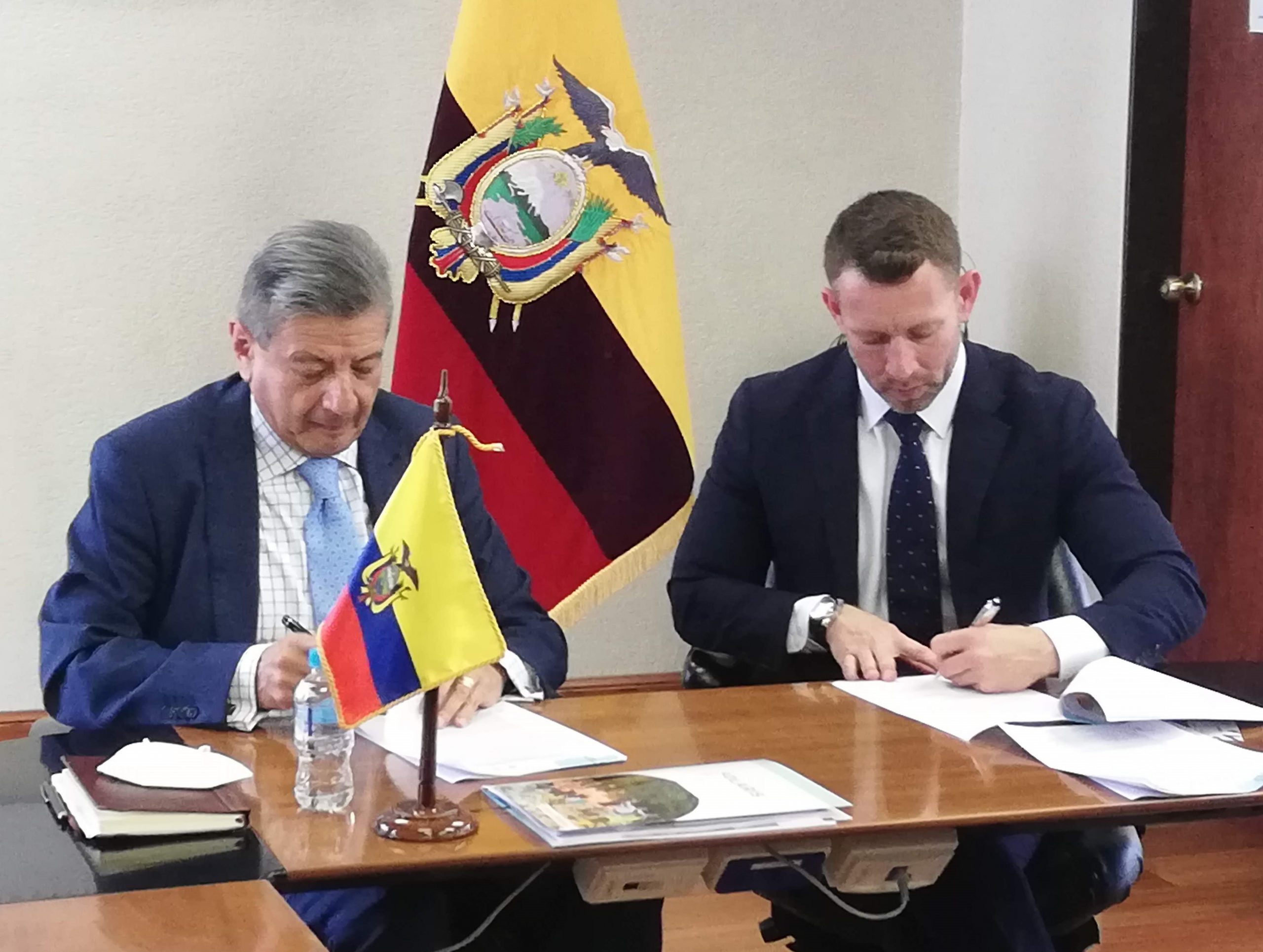

Solaris Resources (TSX:SLS) announced this morning the signing of a Memorandum of Understanding with Electric Corporation of Ecuador (CELEC) to provide low-cost, locally sourced hydroelectric power to the Warintza Project in southeastern Ecuador.
The Warintza Project is Solaris’ flagship exploration project, for which CELEC will provide locally-sourced hydroelectric power from the National Transmission System in Ecuador. This clean-power initiative will provide the primary power to the entire Warintza Project.
The adoption of this plan is aligned with the “Ecuador Zero Carbon Program” created by the Ministry of Environment, Water and Ecological Transition, as well as the National Decarbonization Pact, for which Solaris was one of the first mining signatories in September 2021.
Daniel Earle, President & CEO of Solaris Resources, commented in a press release: “The MOU with CELEC supports our vision to study the potential for electrified operations that maximize the structural benefits of the Warintza Project within an infrastructure-rich mining district with the aim of lowering costs, increasing efficiencies, reducing emissions, and broadly positioning the Project as a leading development opportunity across a range of financial and ESG metrics in the industry.”
Solaris aims to maximize the efficiency possibilities from this enormous, renewable, and low-cost energy source by investigating potential solutions for electrification of infrastructure, mobile mining equipment, including drills, trucks and shovels, material transportation and conveyance, such as gravity-assisted methods, and processing and pumping systems.
Mr. Gonzalo Uquillas Vallejo, General Manager of CELEC, also said: “As a leading strategic public company in the generation and transmission of electric power, we work in compliance with national guidelines to move toward the electrification of all areas of national industry, including large-scale mining, which will be a mainstay for the development of the Ecuadorian economy in the coming decades.”
Solaris has been singled out by the government for its commitment to best practices, and the Warintza Project is expected to set a new industry standard for low-cost, emission-free mining.
This announcement comes as good news for the Warintza Project and for Solaris Resources as a whole. Not only does it reduce the environmental impact of the project, but it also demonstrates Solaris’ commitment to working with the local community and government to create a sustainable future for all.
The above references an opinion and is for information purposes only. It is not intended to be investment advice. Seek a licensed professional for investment advice. The author is not an insider or shareholder of any of the companies mentioned above.
Copper exploration company Solaris Resources (TSX:SLS) recently announced new assay drilling results from its Warinzta project in southeastern Ecuador. These results come from additional holes that actually increased the size of the “drilled defined envelope of mineralization” at the Warinzta Central location.
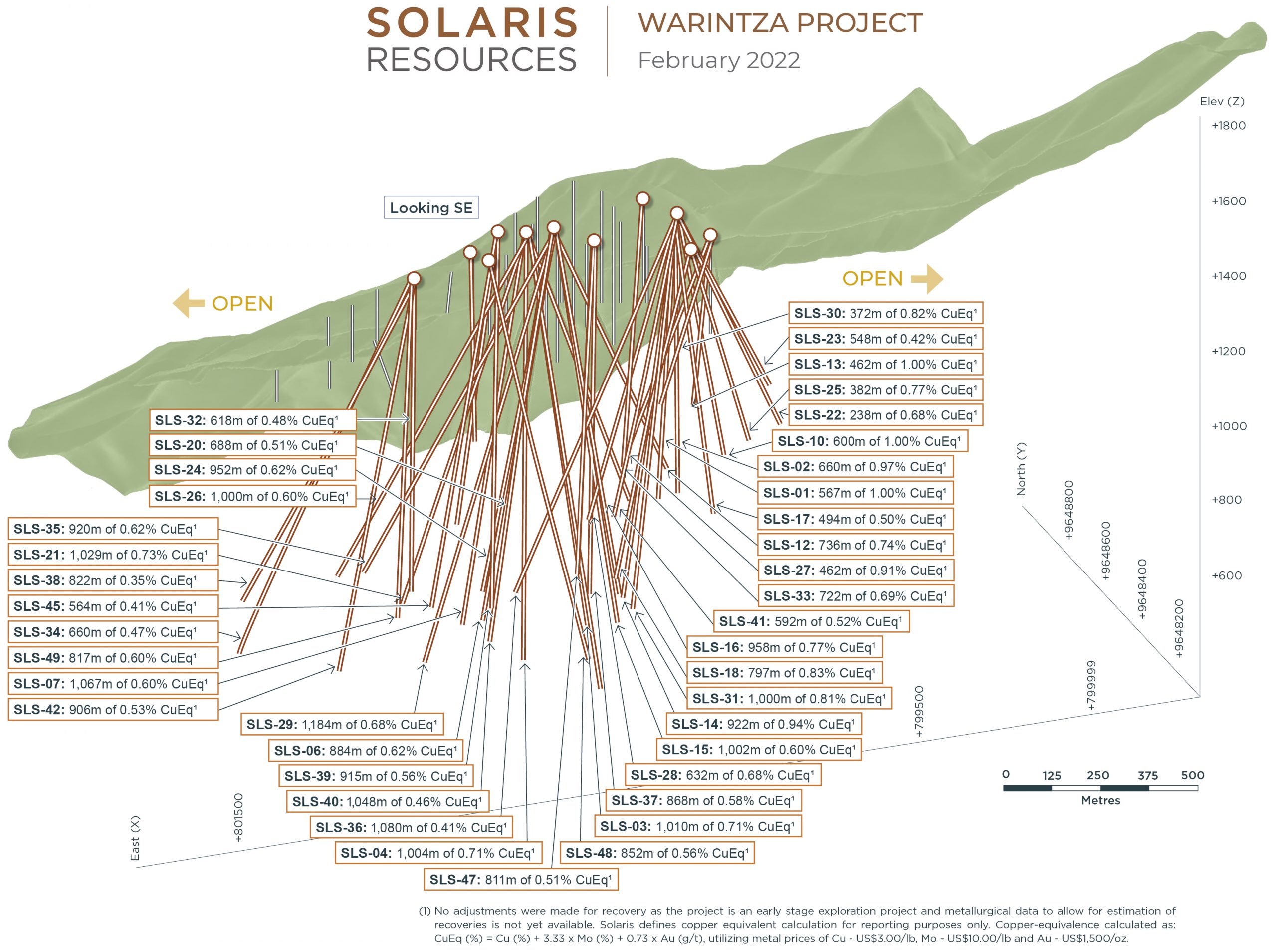

The drilling of these additional holes provided the area with the highest-grade intersection reported by Solaris to date, as well as high-grade extension to the northeast, south and southeast locations at the Warinzta project.
As of today, Solaris has completed drilling 58 holes at Warinzta, and 49 of those holes have assays already reported. Mr. Jorge Fierro, Vice President of Exploration of Solaris explained that the initial resource growth drilling program for Warinzta is finally completed and touched on future drilling plans.
“With this intensive program behind us, the focus of ongoing drilling has turned to pursuing the further extensions of near-surface, high-grade mineralization which remain open, with additional platforms allowing for more aggressive step-outs under construction,” said Fierro in a press release.
Highlights of the drilling from Solaris are as follows:
Drilling Returns Highest Grades Reported to Date in Emerging Northeast Extension that Remains Open:
- SLS-42 was collared at the northeastern limit of the grid and drilled northeast into an entirely open volume, returning 740m of 0.60% CuEq¹ from 52m depth within a broader interval of 906m of 0.53% CuEq¹, extending mineralization in this direction where it remains open
- SLS-49 was drilled southeast from the same platform and returned 396m of 0.70% CuEq¹ within a broader interval of 817m of 0.60% CuEq¹ from 50m depth, tying the northeast extension to the overlap between Warintza Central and East
- SLS-48, was collared in an undrilled area ~200m west of SLS-49 and drilled south, returning 100m of 1.64% CuEq¹ from 50m depth, the highest-grade mineralization reported to date, within a broader interval of 852m of 0.56% CuEq¹, extending the near surface high-grade mineralization to the west in that area
- These results expand Warintza Central by building on an emerging area of near surface, high-grade mineralization; follow-up drilling will pursue further growth by targeting the open areas to the north and northwest, with an additional platform being constructed to pursue further step-outs to the northeast
Drilling Extends Mineralization to Southeast that Remains Open:
- SLS-45 was collared on the eastern side of the grid and drilled southeast into an entirely open volume, returning 236m of 0.56% CuEq¹ from 44m depth within a broader interval of 564m of 0.41% CuEq¹, extending mineralization to the southeast where it remains open
- SLS-46 was collared from a southeastern platform and drilled southeast into a partially open volume, returning 168m of 0.69% CuEq¹ from 48m depth within a broader interval of 632m of 0.31% CuEq¹, extending mineralization in this direction where it remains open
- SLS-47 was collared in the middle of the grid and drilled southeast to infill this area, returning 446m of 0.70% CuEq¹ from 48m depth within a broader interval of 811m of 0.51% CuEq¹, with mineralization remaining open to the south
Figure 2 – Plan View of Warintza Drilling Released to Date
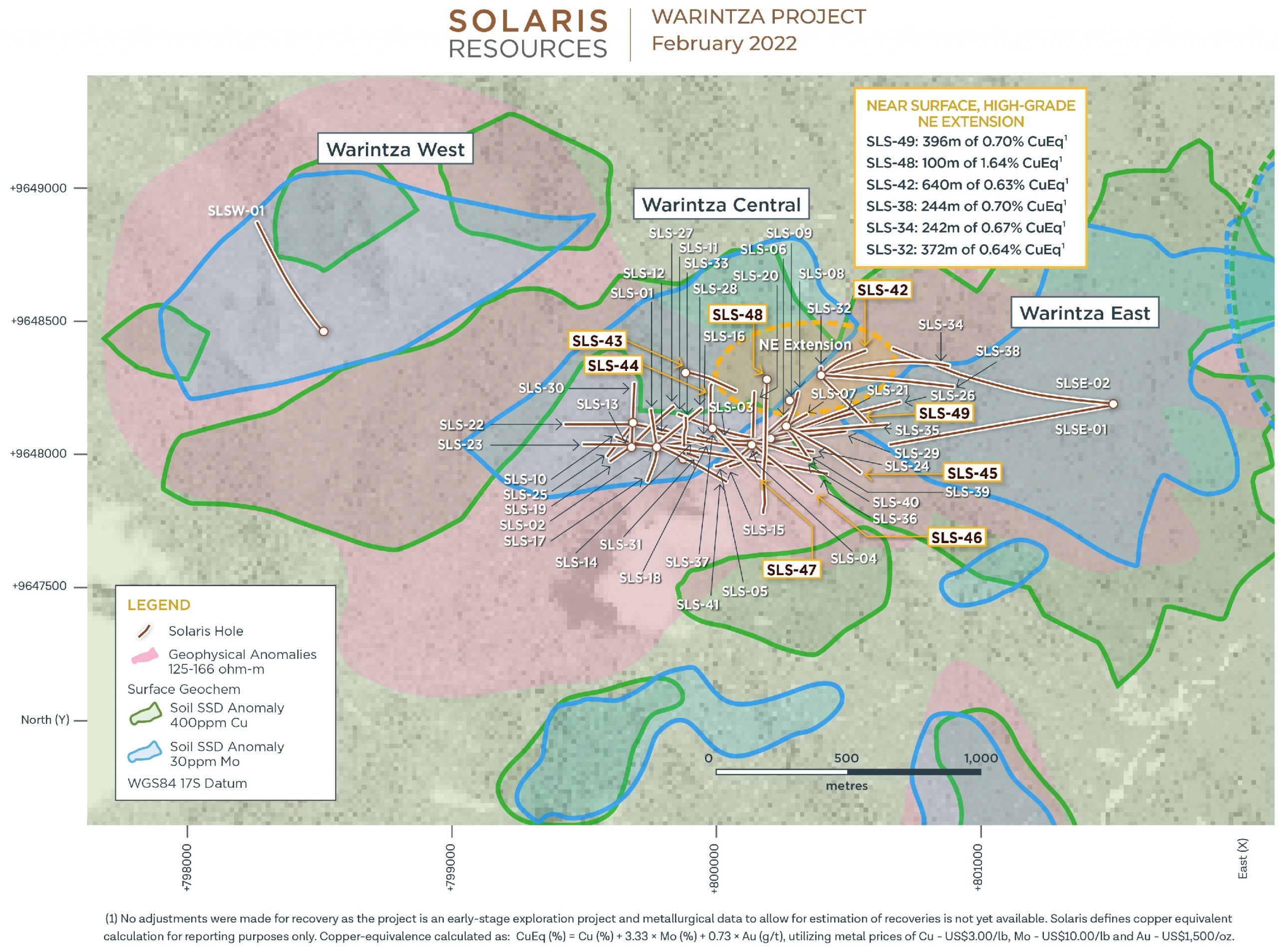

Figure 3 – Long Section of 3D Geophysics Looking Southwest
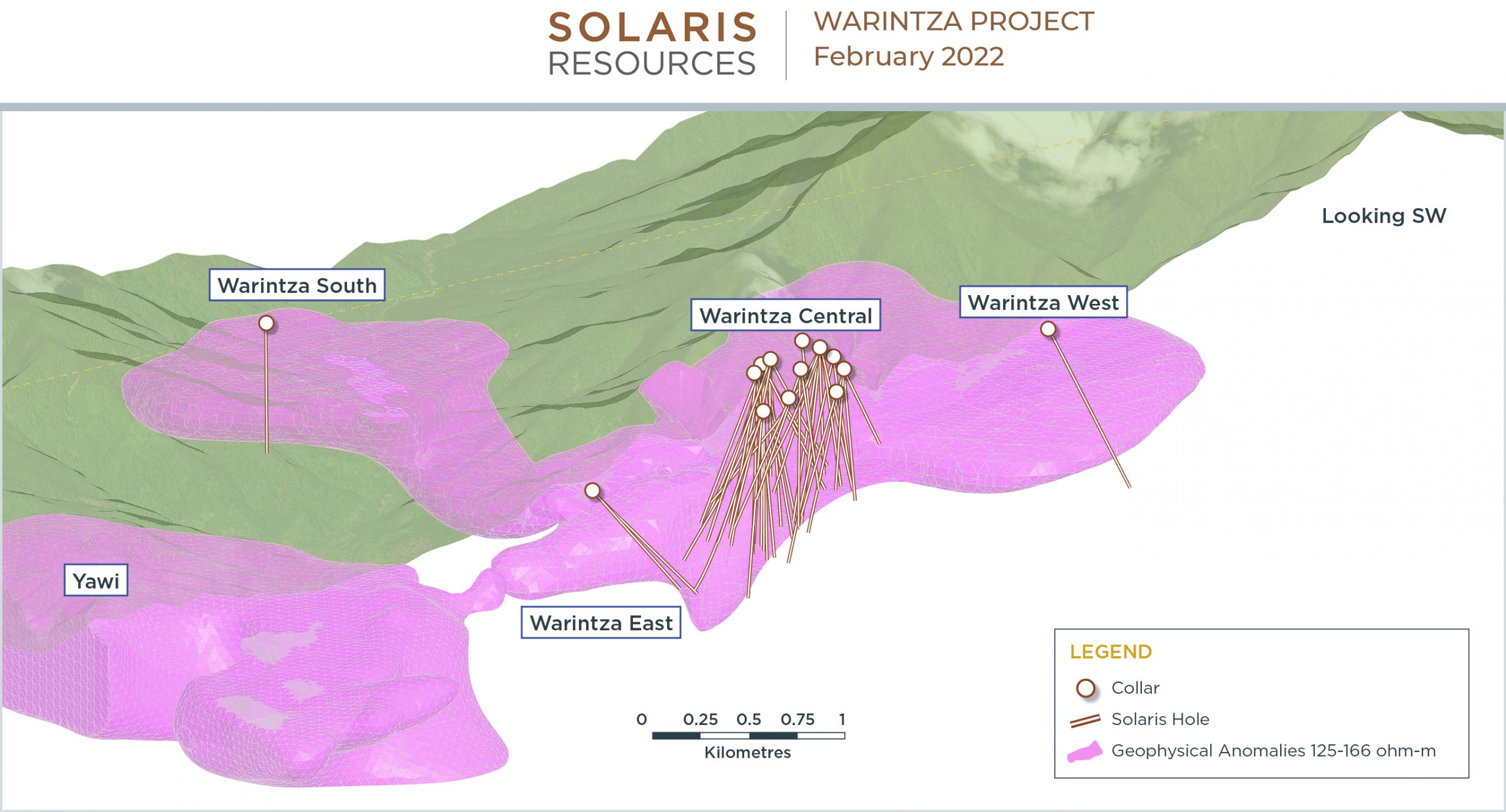

The above references an opinion and is for information purposes only. It is not intended to be investment advice. Seek a licensed professional for investment advice. The author is not an insider or shareholder of any of the companies mentioned above.
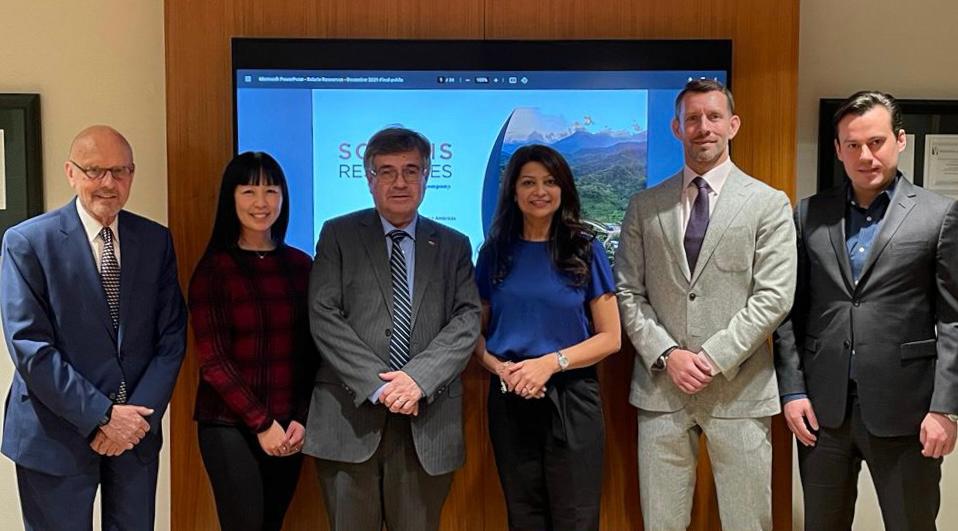

Bank of America (BofA) Global Research analysts have reported that beginning in 2025, the copper market will again suffer a deficit due to the lower number of projects currently underway.
Although global copper production by 2023 will increase by 7.7% after an expected shortfall in 2022, output will fall, due to the underperformance of new copper mine construction in recent years.
“While visibility over the near-term project pipeline is good, activity increases come with a wrinkle,” say the bank’s analysts. “Indeed, many of the projects currently developed have been in the making for almost three decades, and with exploration activity relatively limited in recent years, supply increases may fade from 2025.”
BofA predicts several drawbacks preventing copper production from growing. Edgar Blanco Rand, vice-minister of mining in Chile’s previous government, represented this data in a presentation during LME Week. His presentation showed a pipeline of projects planned for 2029 in Chile at a cost of $74 billion with the goal of achieving production of 7 million tons. Edgar Blanco pointed out a stagnation in production since 2000 with 5.7 million tons after 1990, a decade of rapid growth.
“This implies a capex intensity of around $50,000 per tonne, well above the $10,000 to 20,000 per tonne range seen in recent years. As an aggravating factor, the investment will need to be large enough to offset about 1.5 million tonnes of production losses,” says the bank.
The shortfall in copper production is beneficial to exploration companies because they have valuable projects that other companies are interested in acquiring in order to increase production.
Solaris Resources (TSX:SLS) is responsibly and sustainably pursuing a number of copper projects in the Americas. Its Warintza project, based in Ecuador, is a high-grade open-pit resource within a 7 km x 5 km porphyry copper cluster. The company is also working on discovery drilling at Tamarugo and Ricardo in Chile and Capricho and Paco Orco in Peru.
Warintza’s mining model is a participatory model that promotes state-company-community dialogue based on transparency, collaboration and trust, which contributes to the sustainable socio-economic development of the communities and the project.
For the copper market to continue to sustain steady production and high-quality projects, exploration companies like Solaris with projects like Warintza will become a priority and highly valuable to the major producers looking to grow output. As a result, this is a company that could be a significant part of the solution for this complex market problem.
The above references an opinion and is for information purposes only. It is not intended to be investment advice. Seek a licensed professional for investment advice. The author is not an insider or shareholder of any of the companies mentioned above.
If you would like to receive our free newsletter via email, simply enter your email address below & click subscribe.
CONNECT WITH US
Tweets
Tweet with hash tag #miningfeeds or @miningfeeds and your tweets will be displayed across this site.
MOST ACTIVE MINING STOCKS
Daily Gainers
      |
LML.AX | +125.00% |
      |
GCR.AX | +33.33% |
      |
CASA.V | +30.00% |
      |
AHN.AX | +22.22% |
      |
ADD.AX | +22.22% |
      |
AZM.V | +21.98% |
      |
NSE.V | +21.05% |
      |
DYG.V | +18.42% |
      |
AAZ.V | +18.18% |
      |
GLA.AX | +17.65% |

